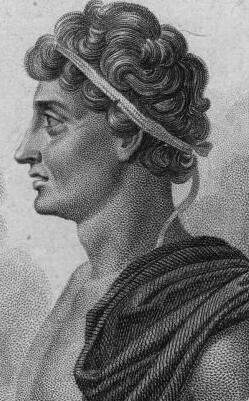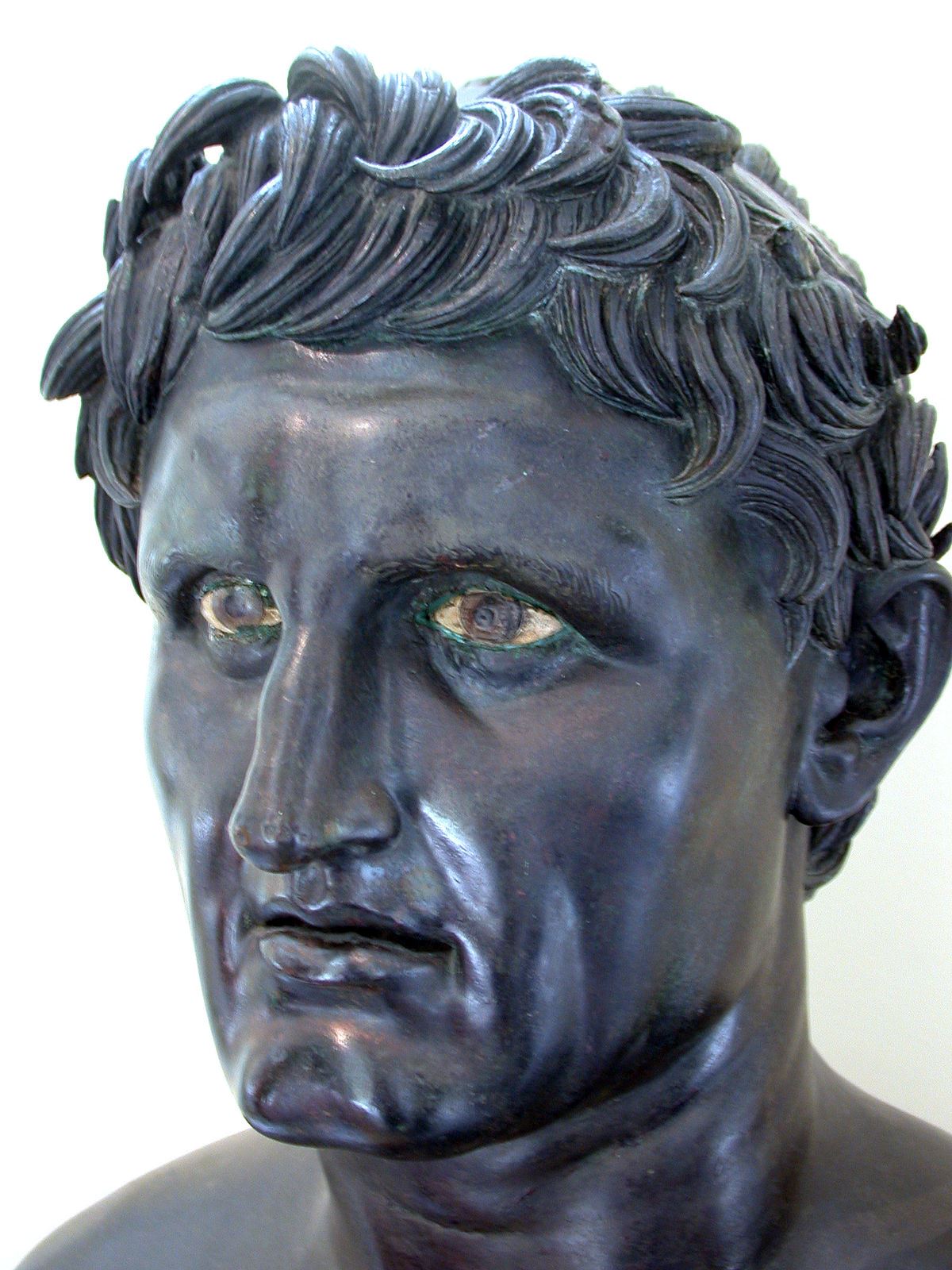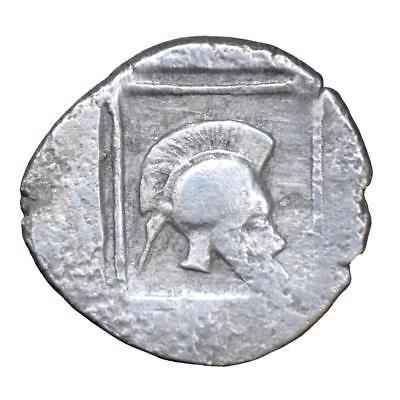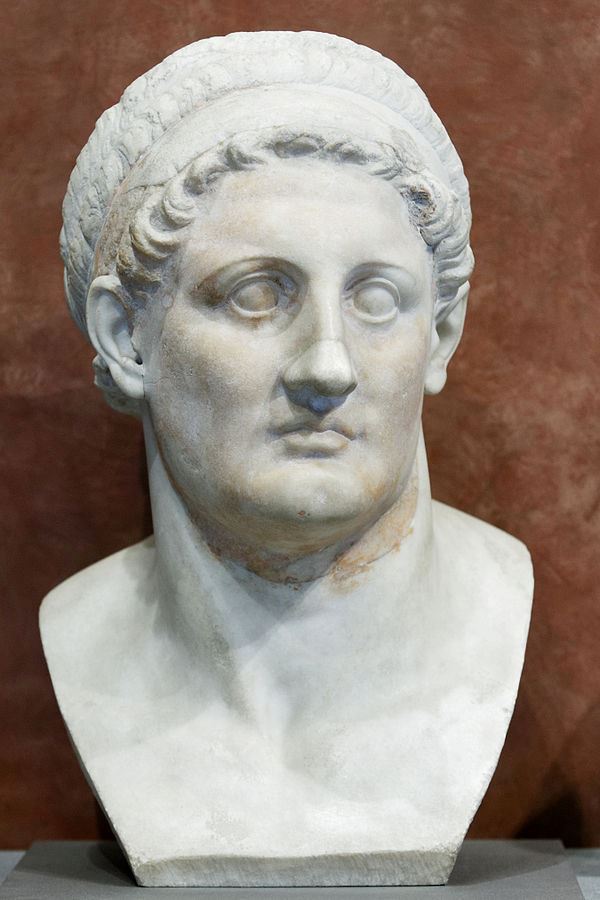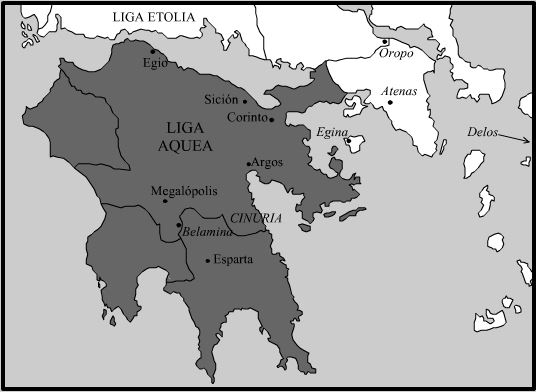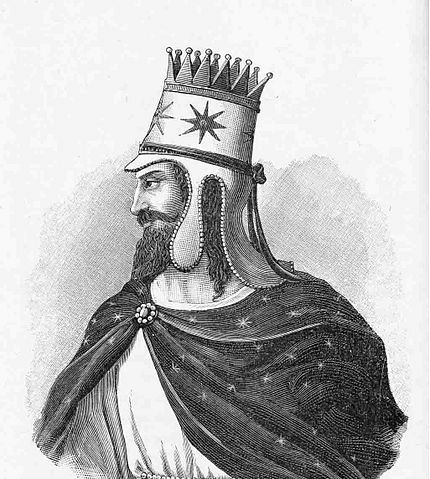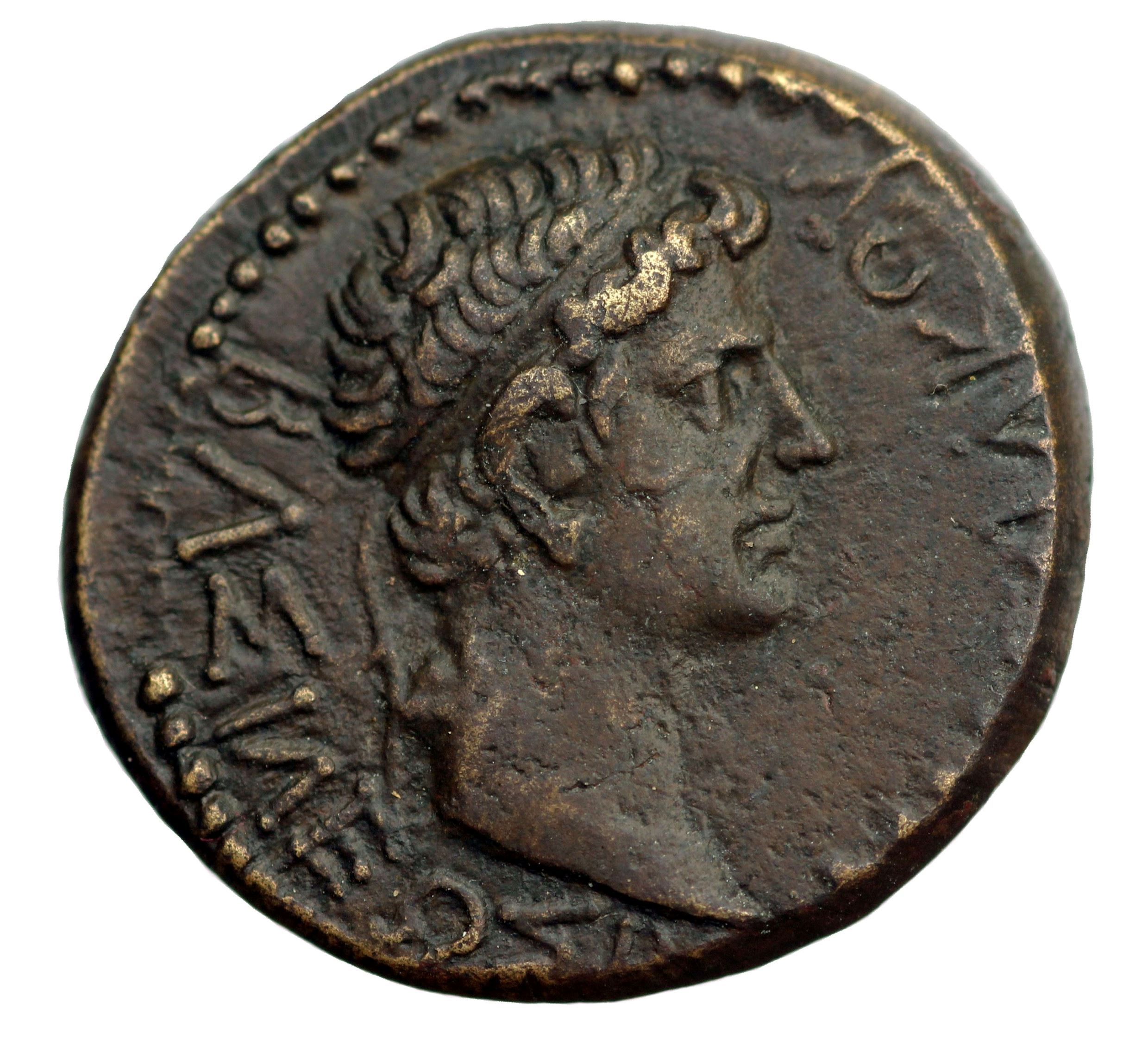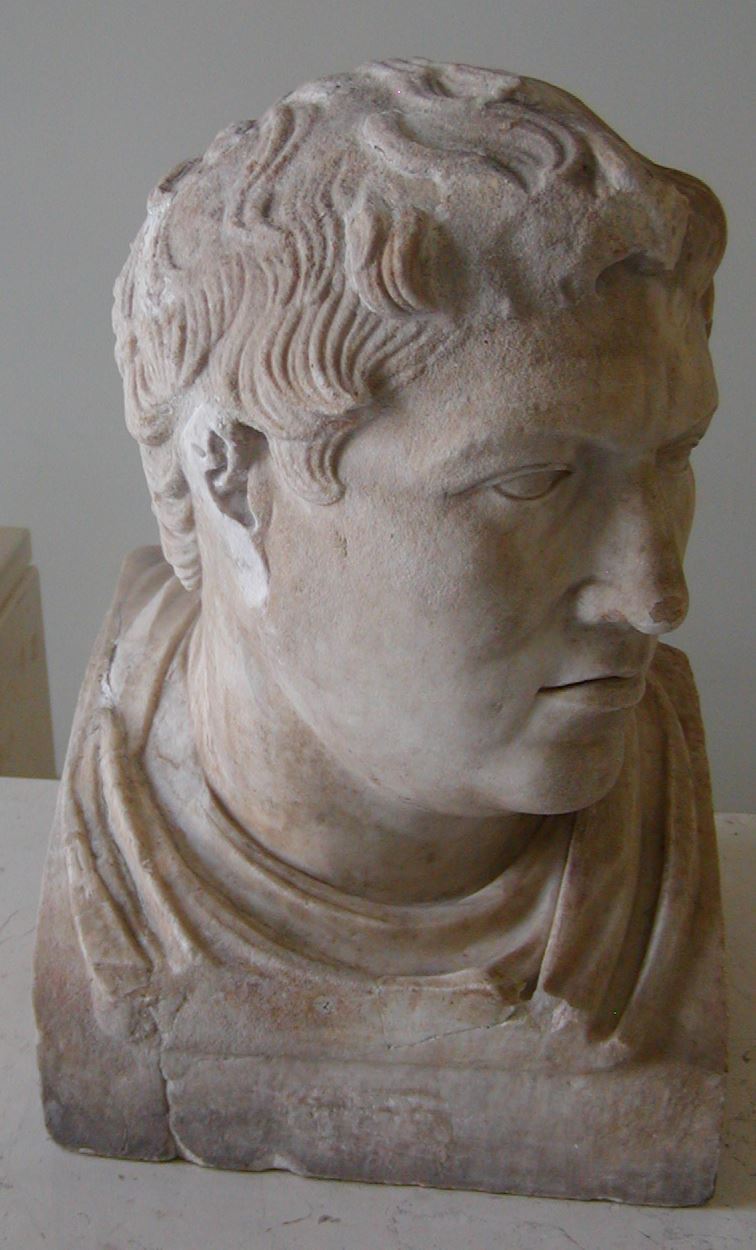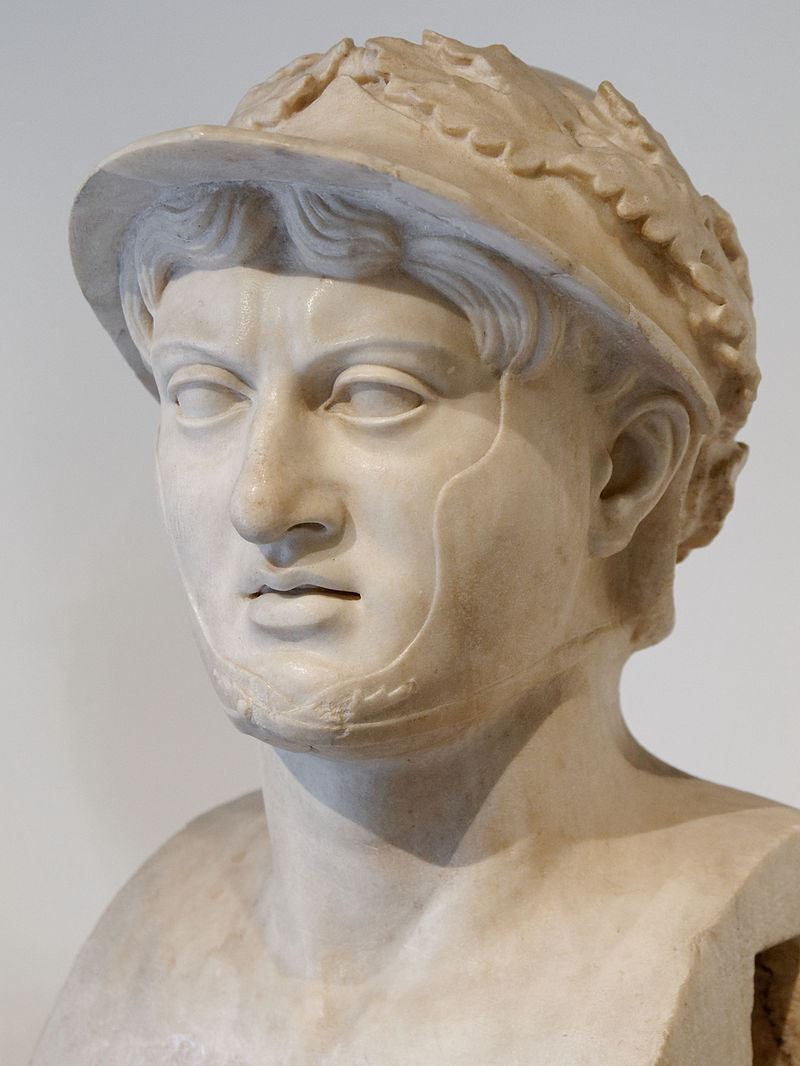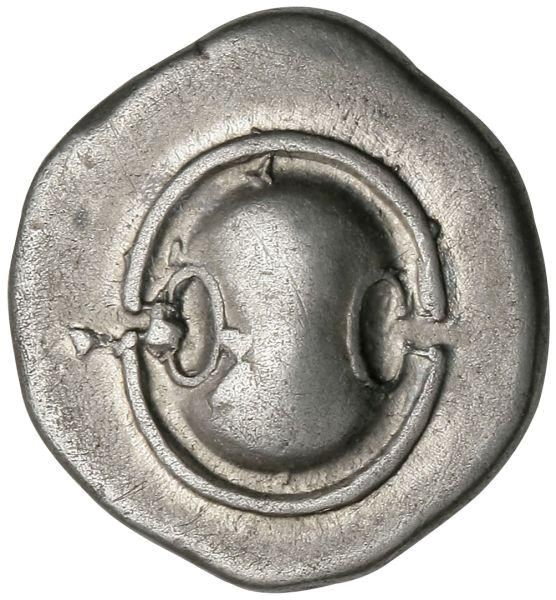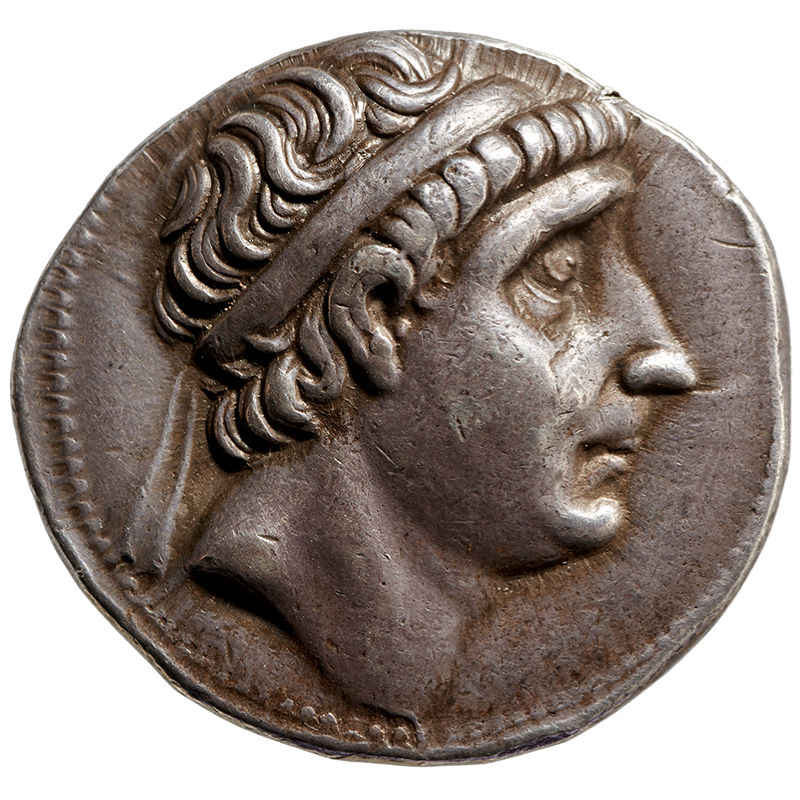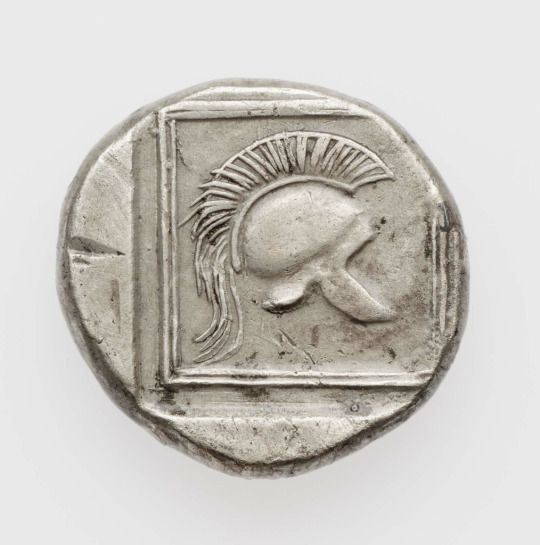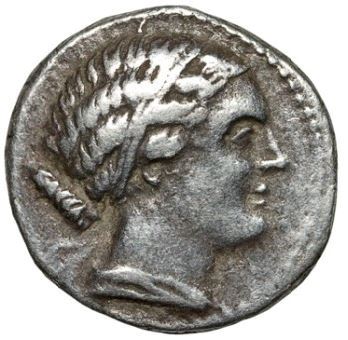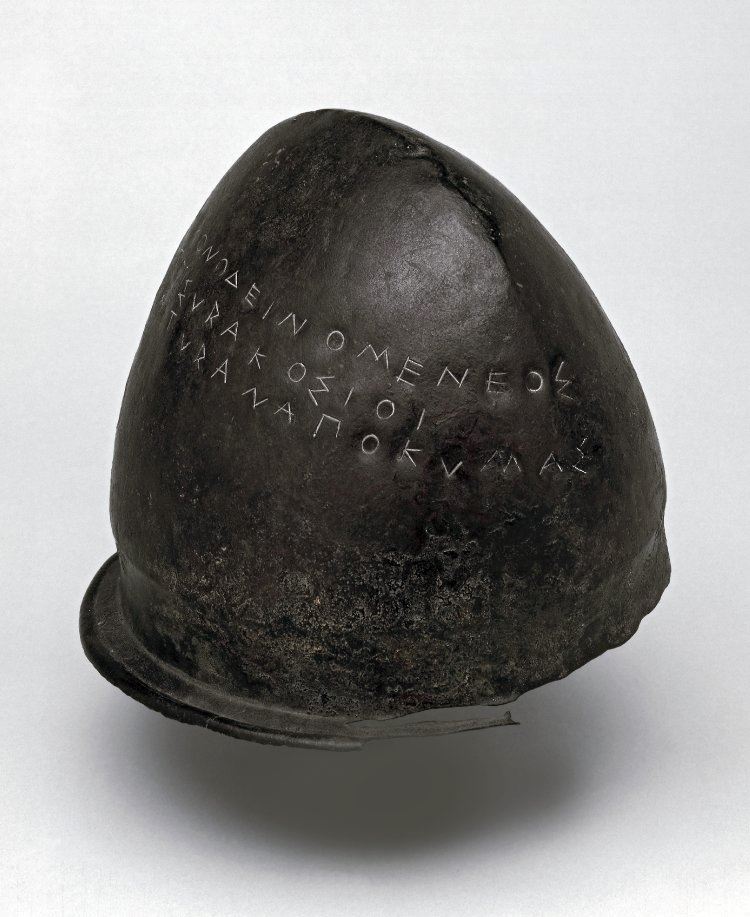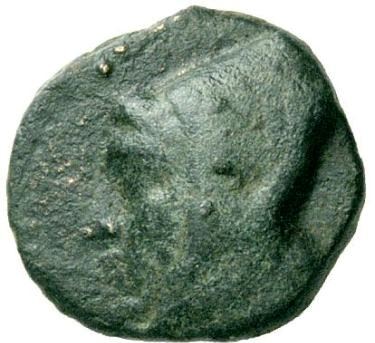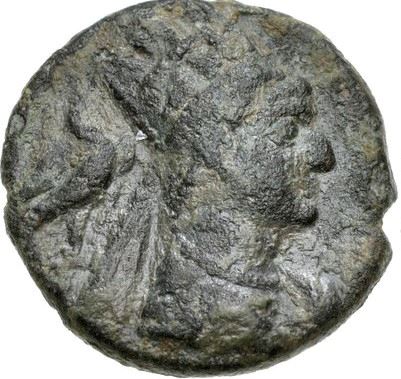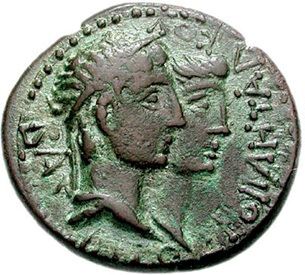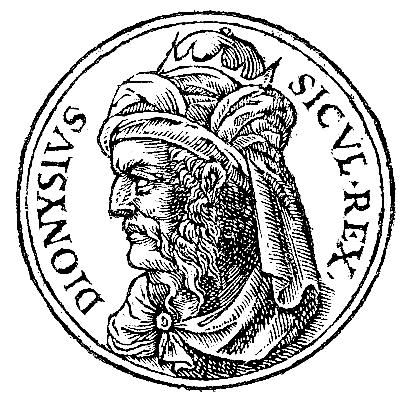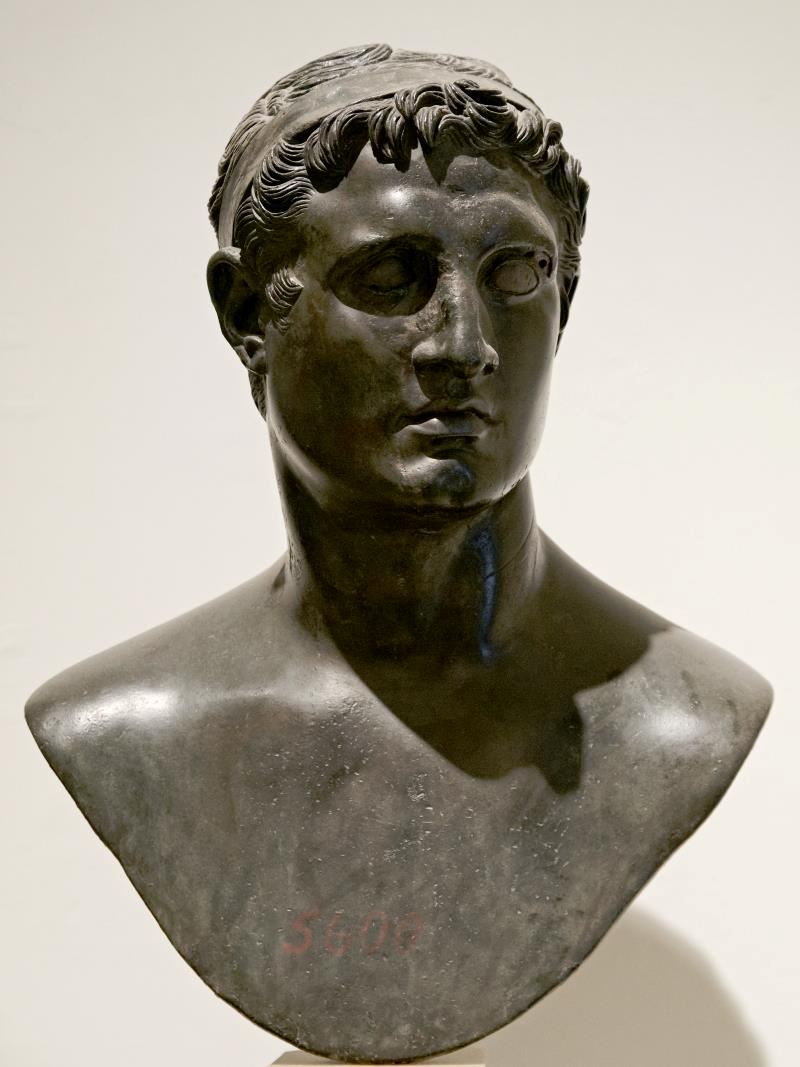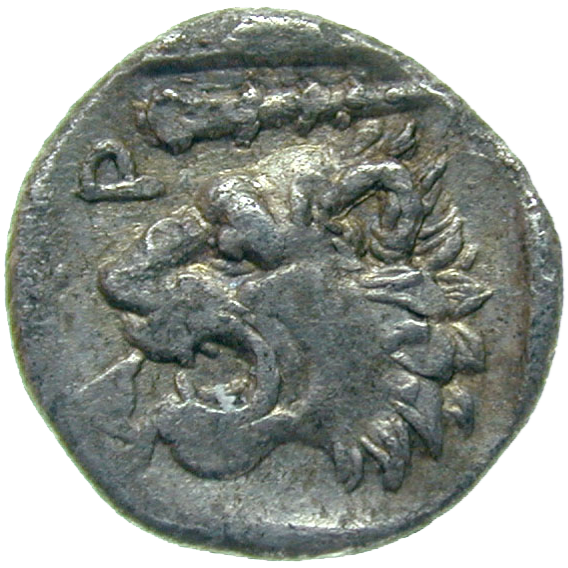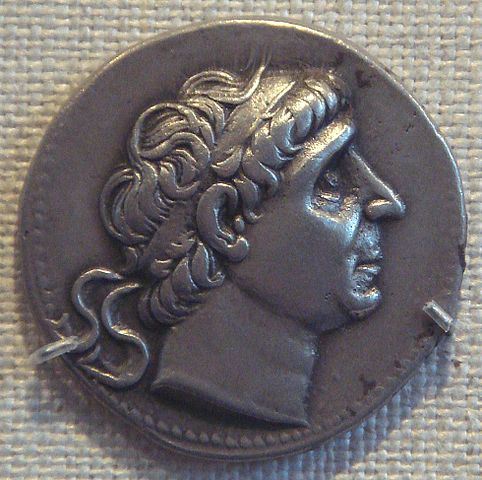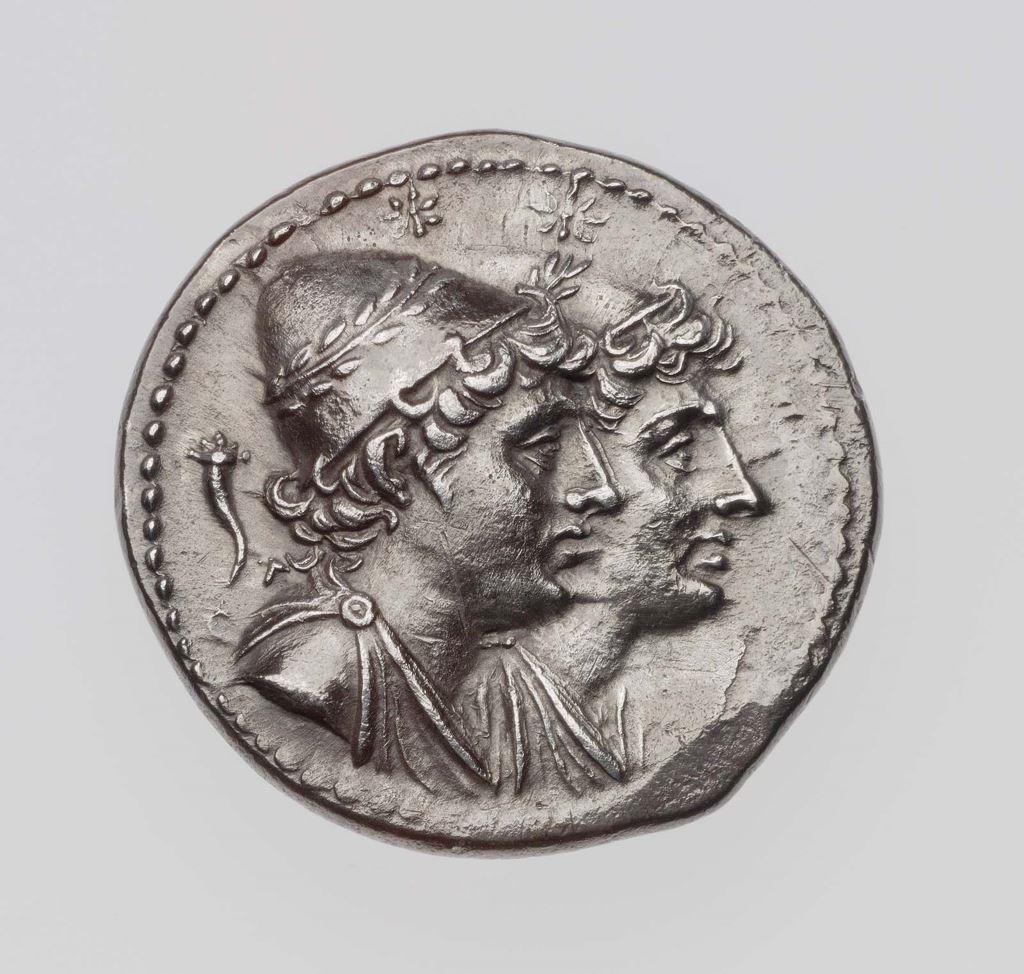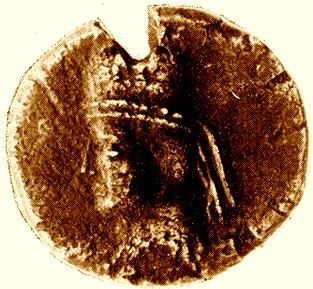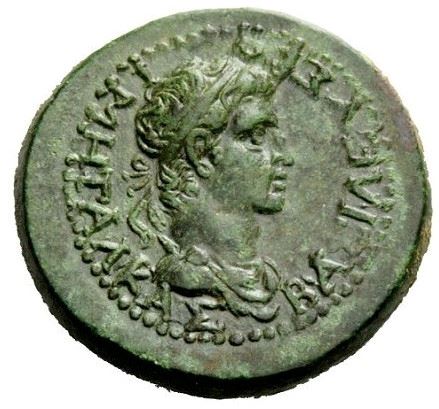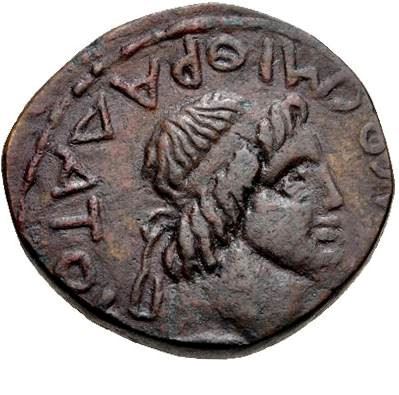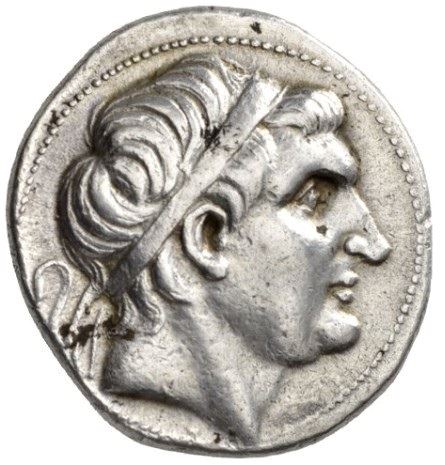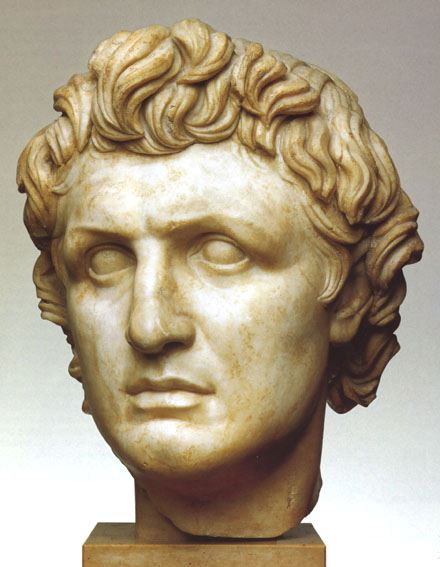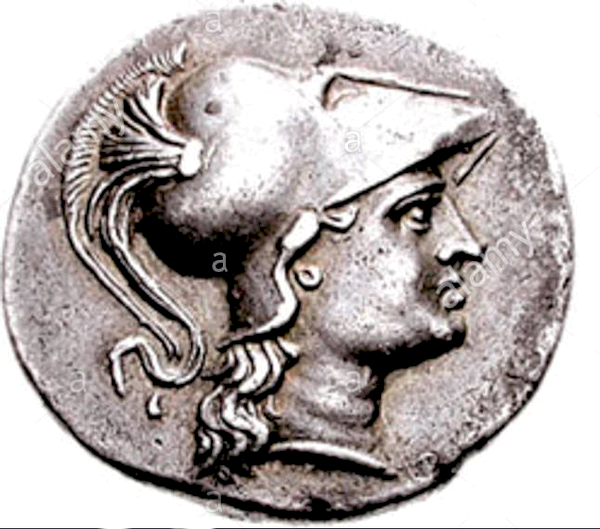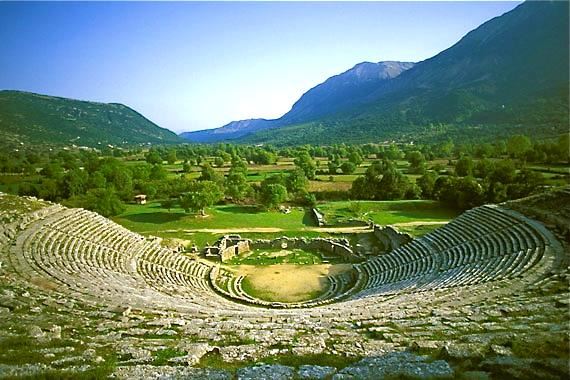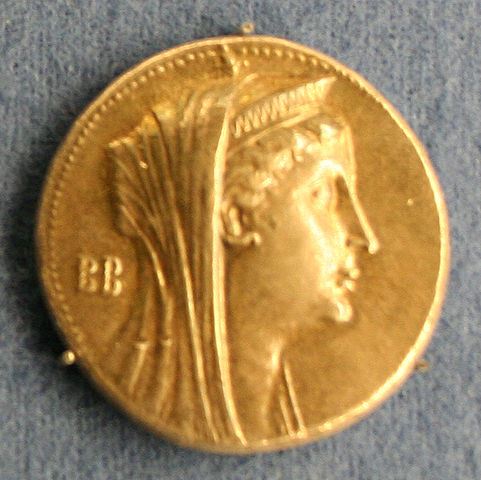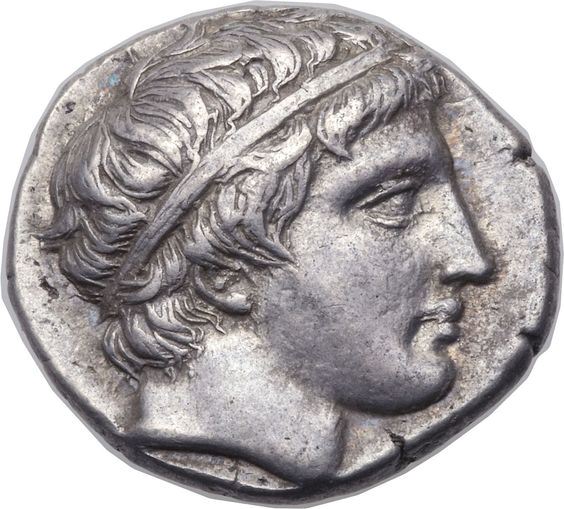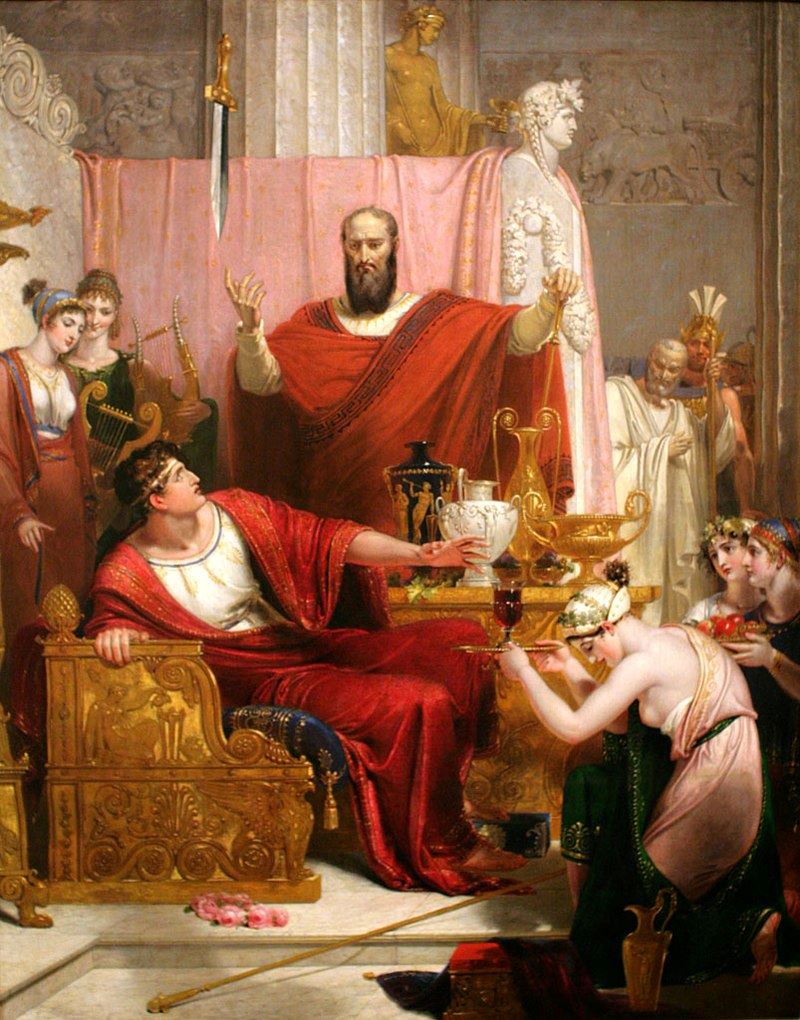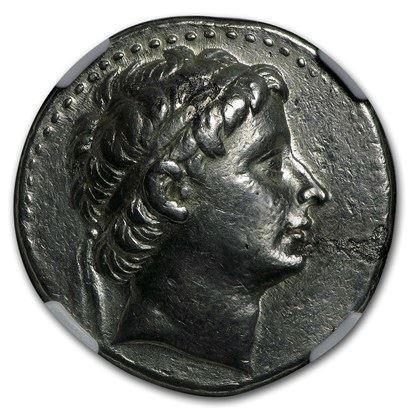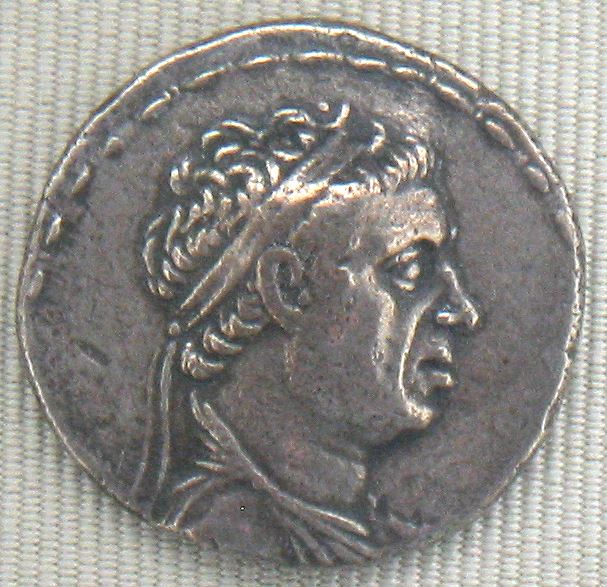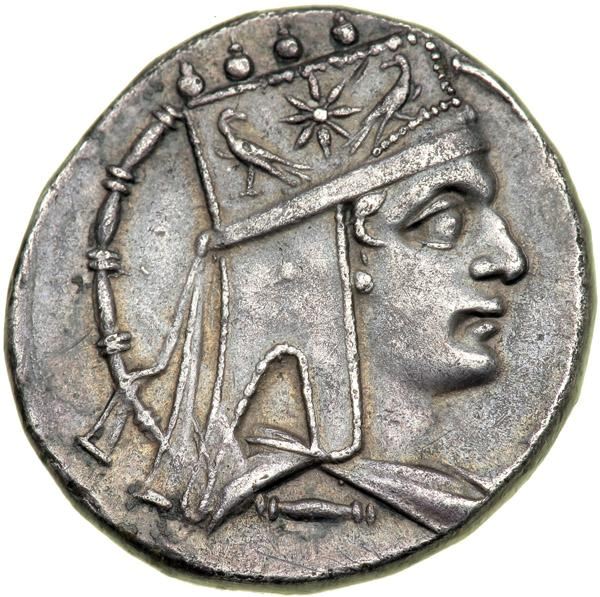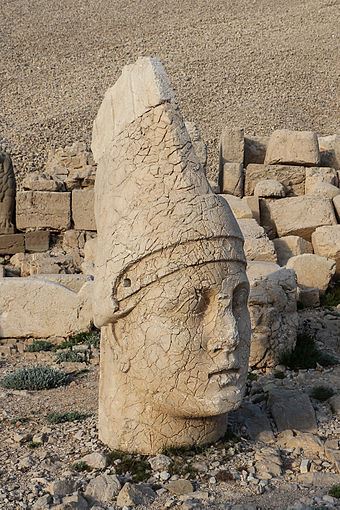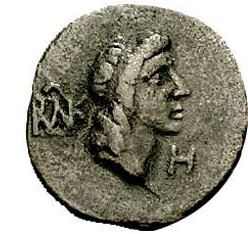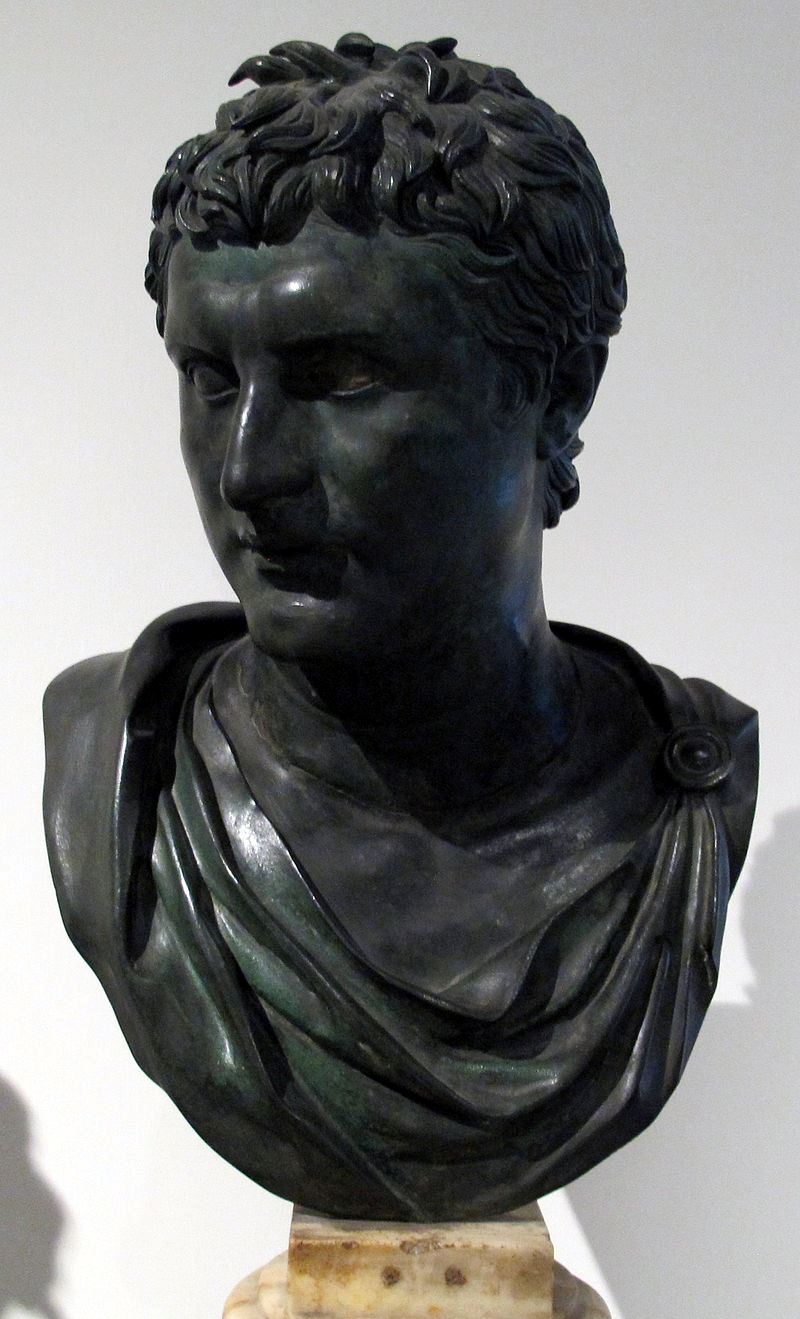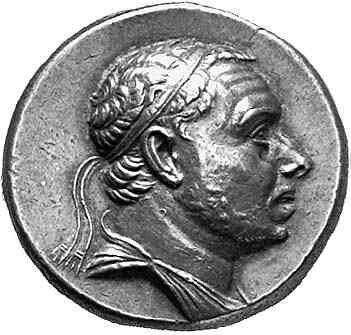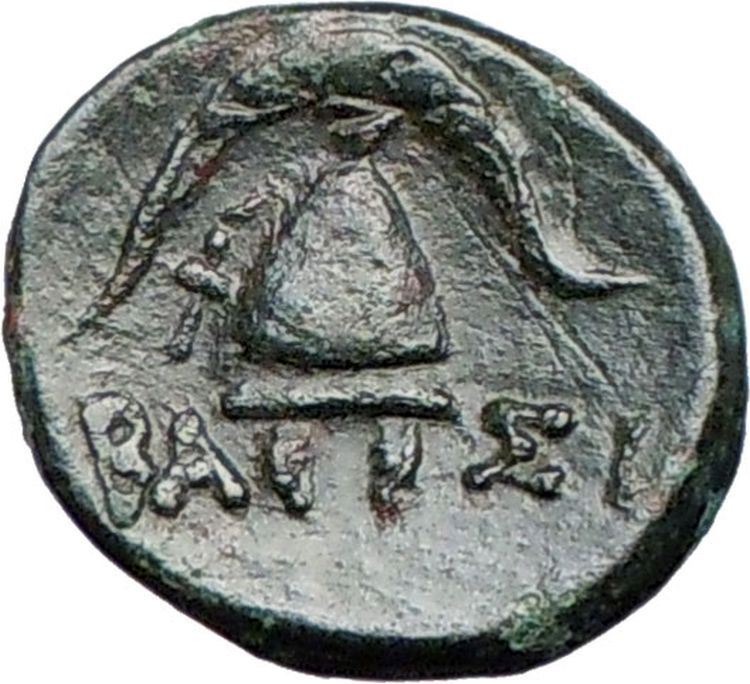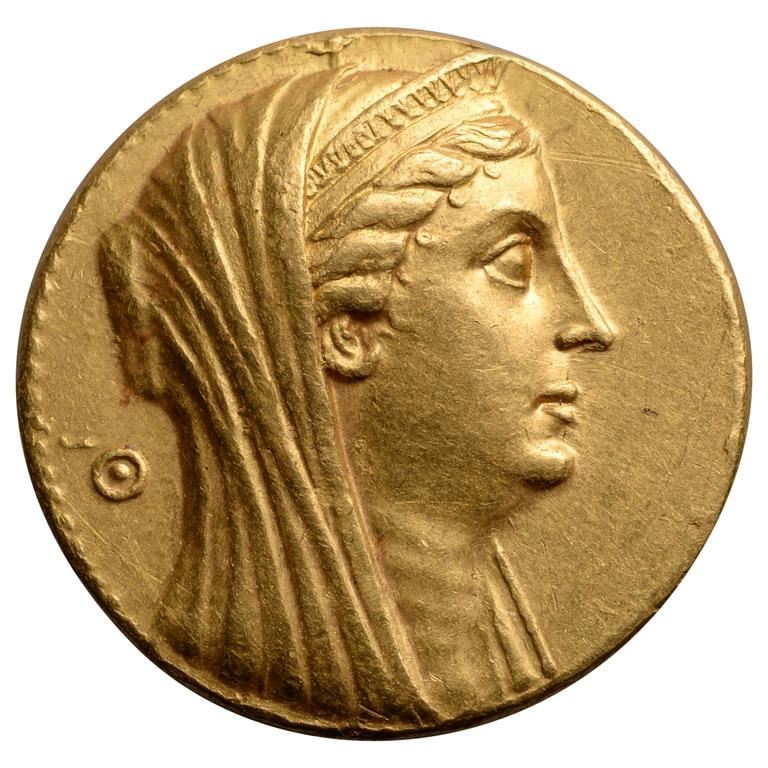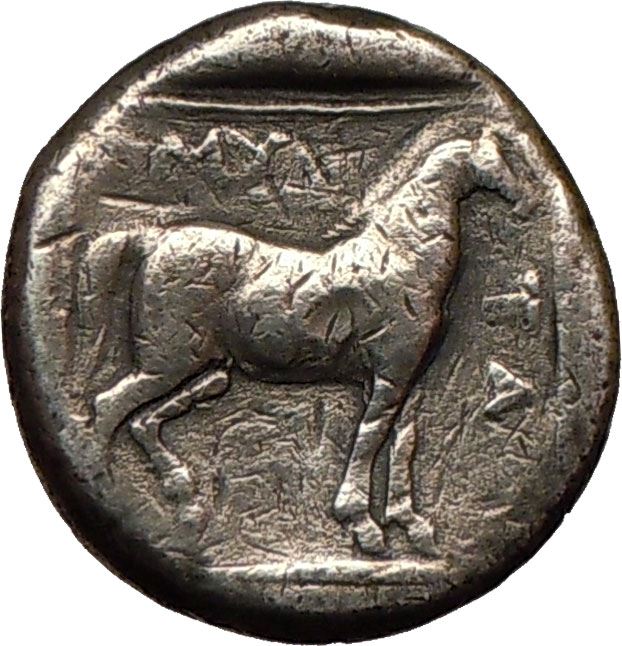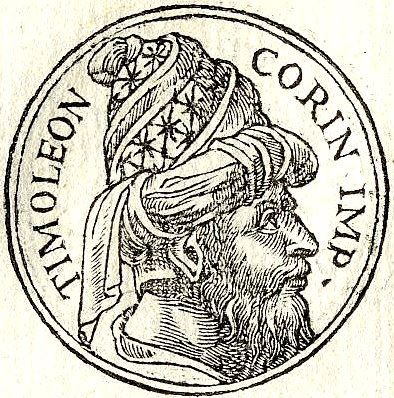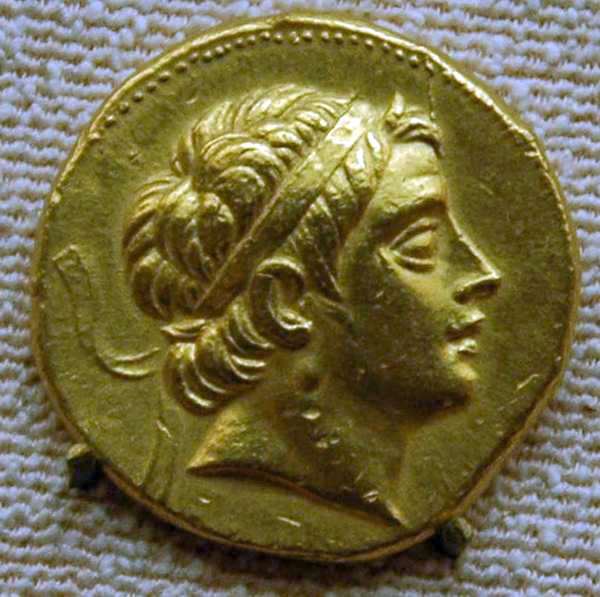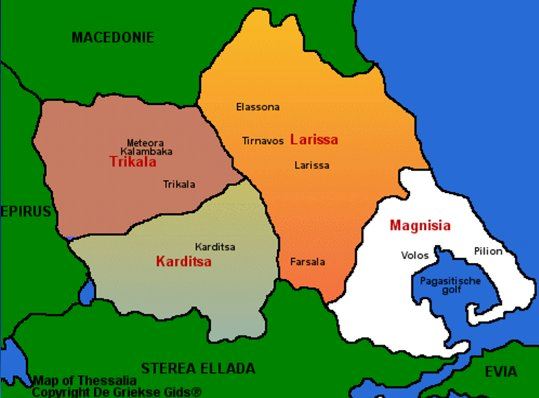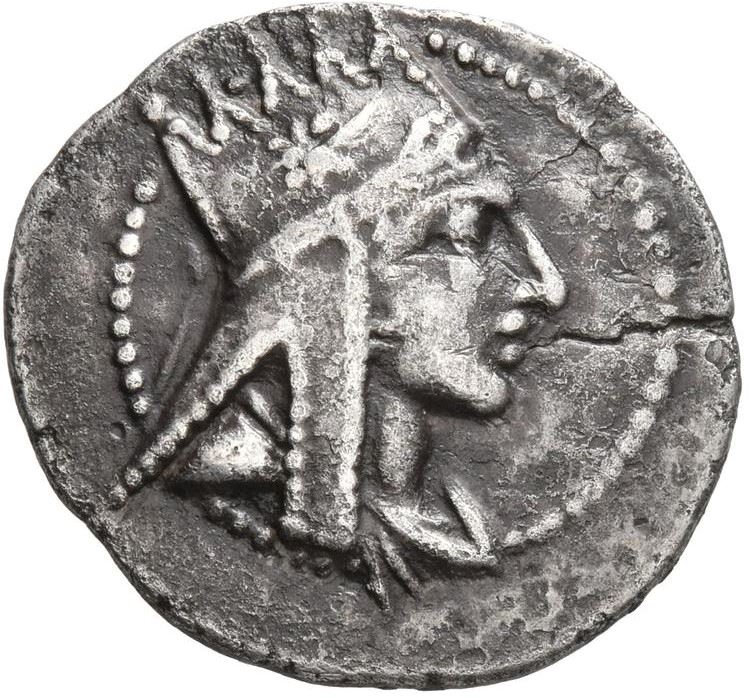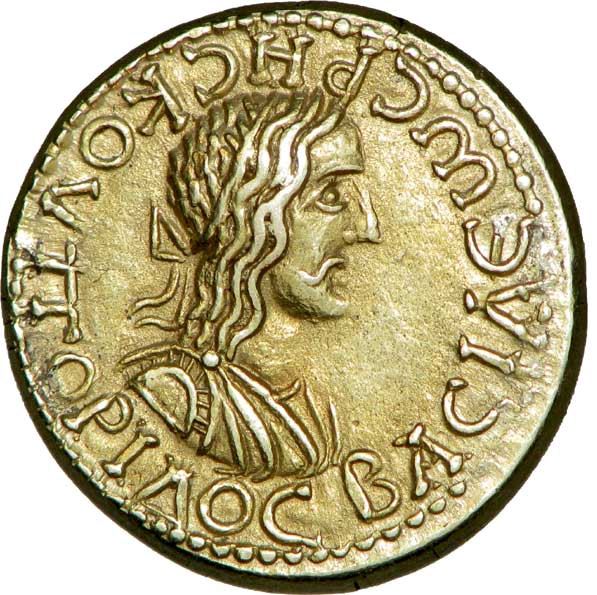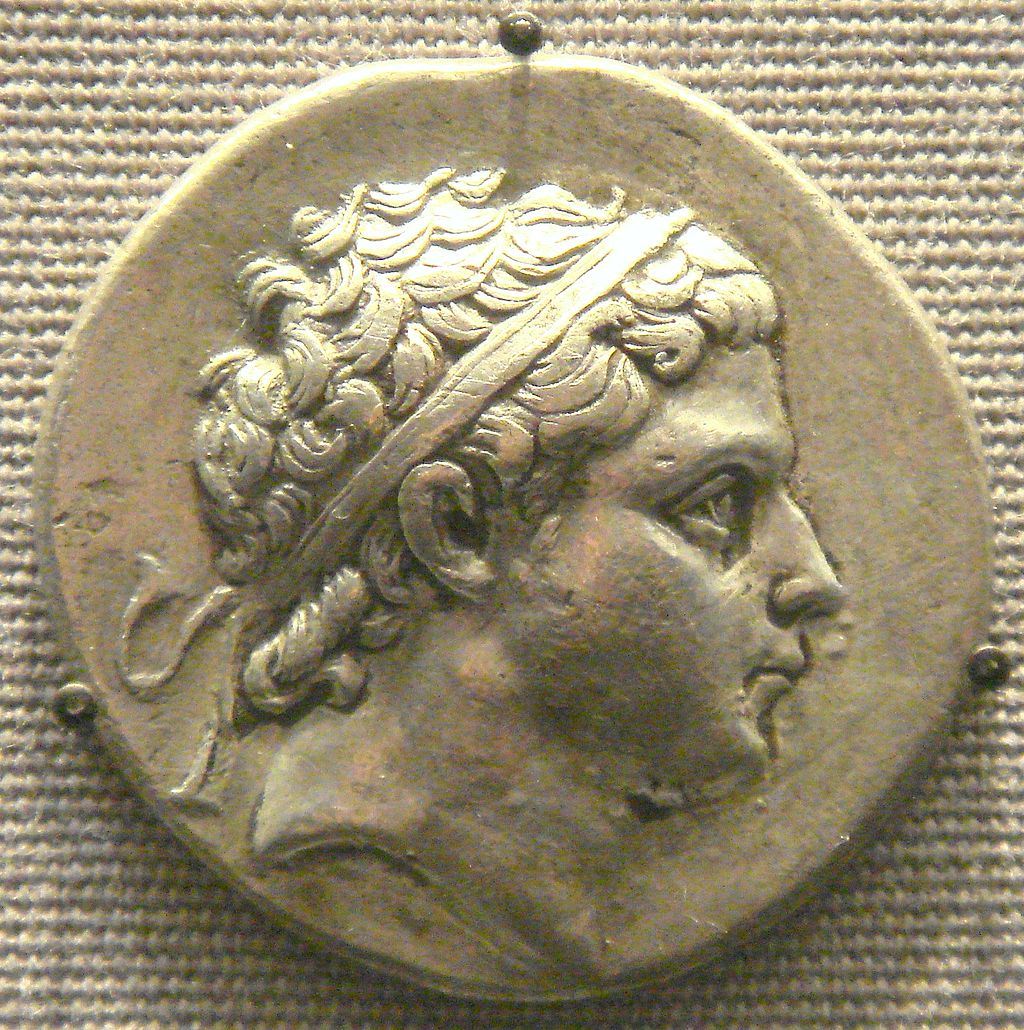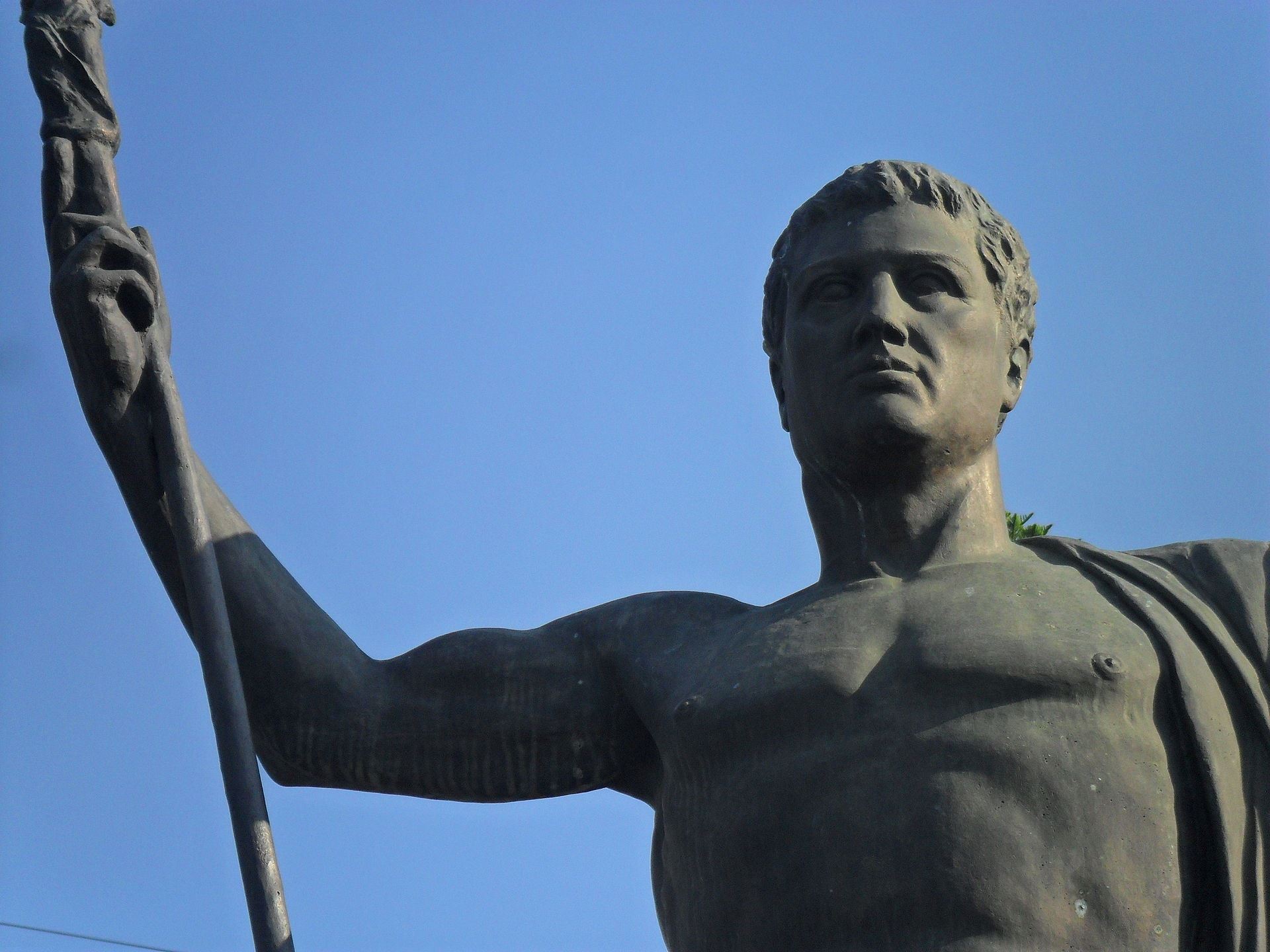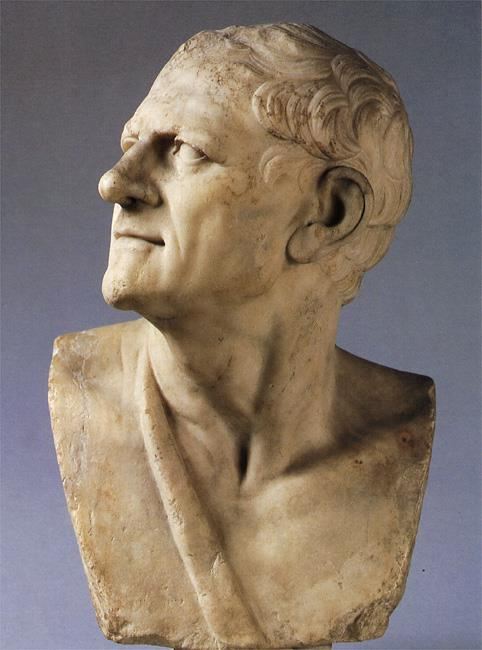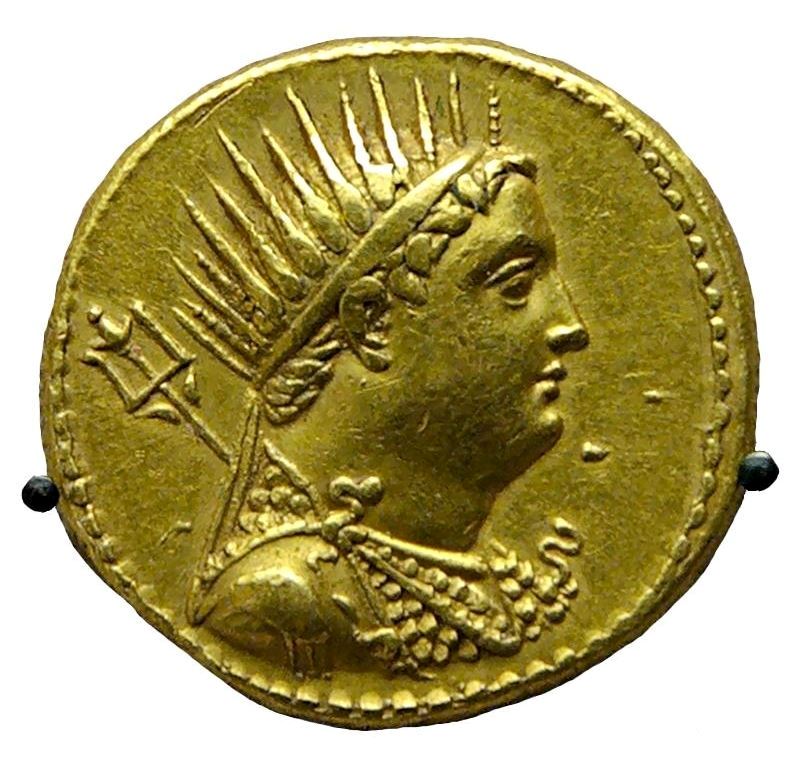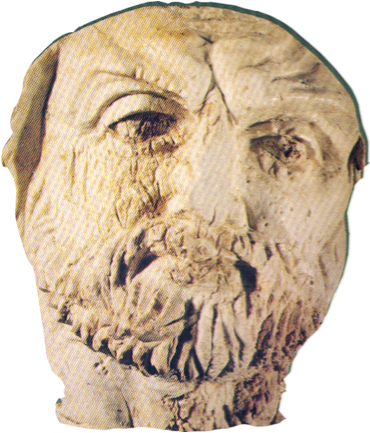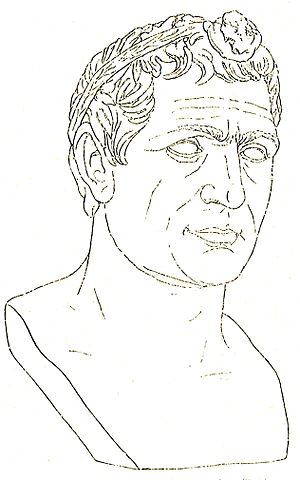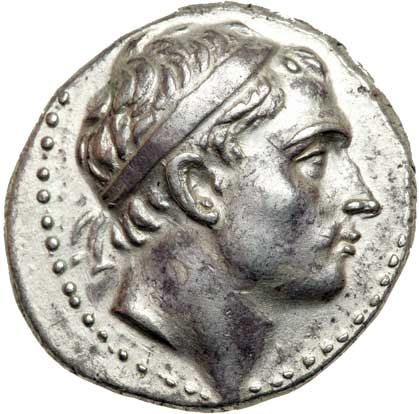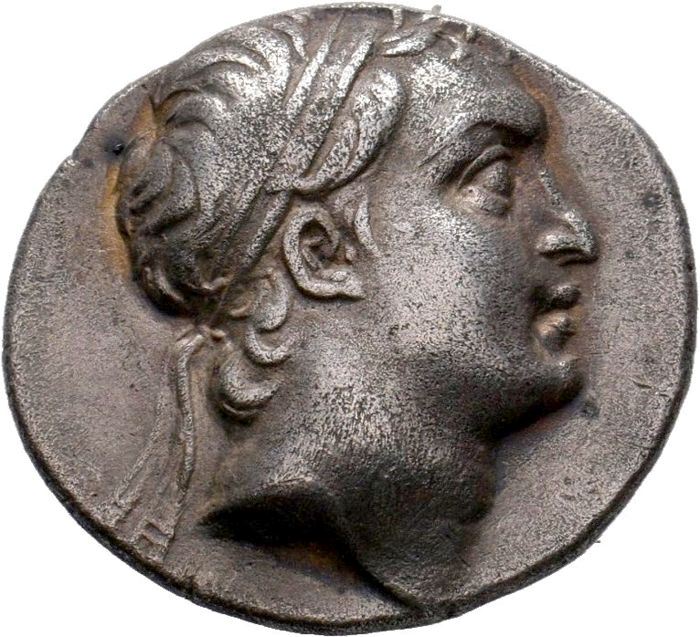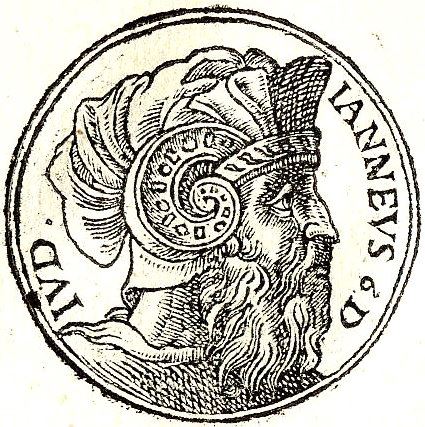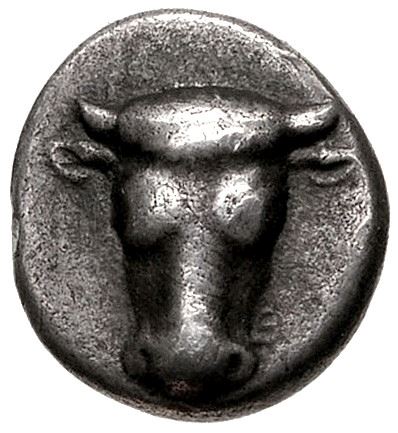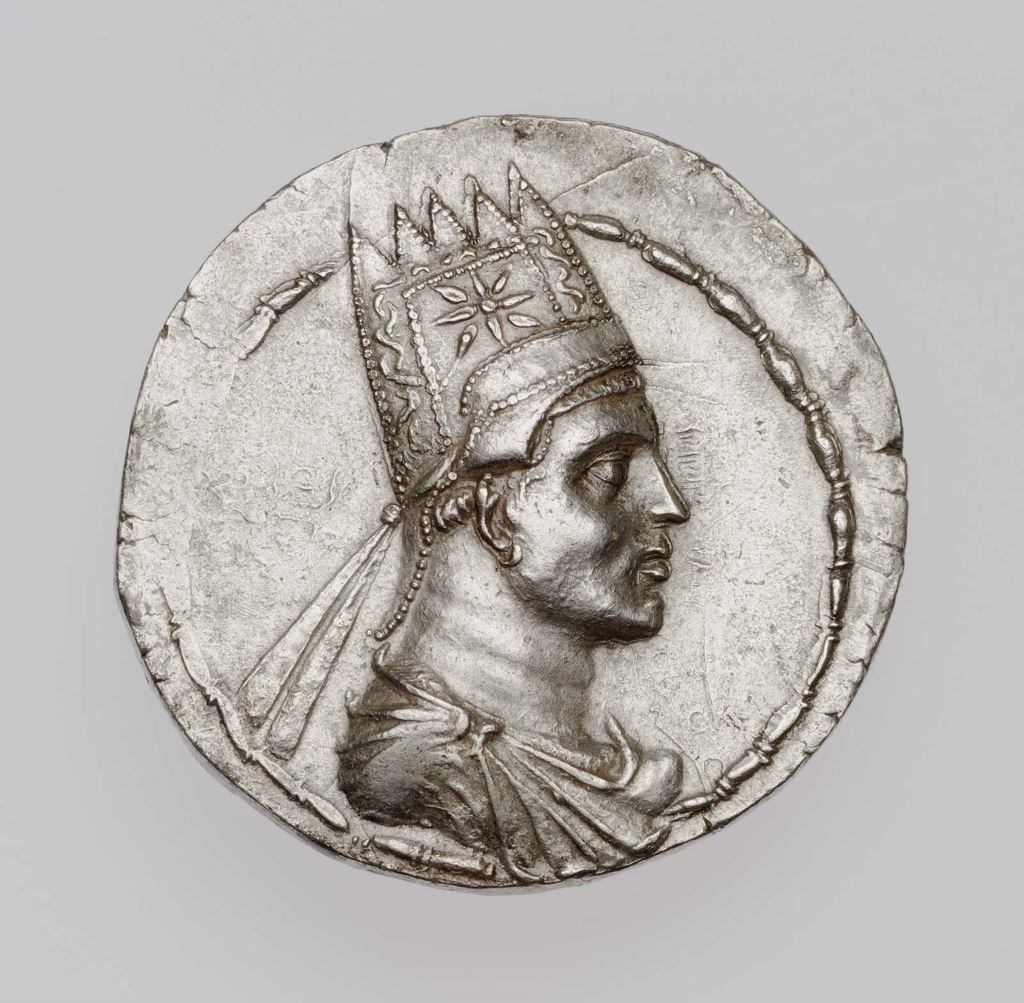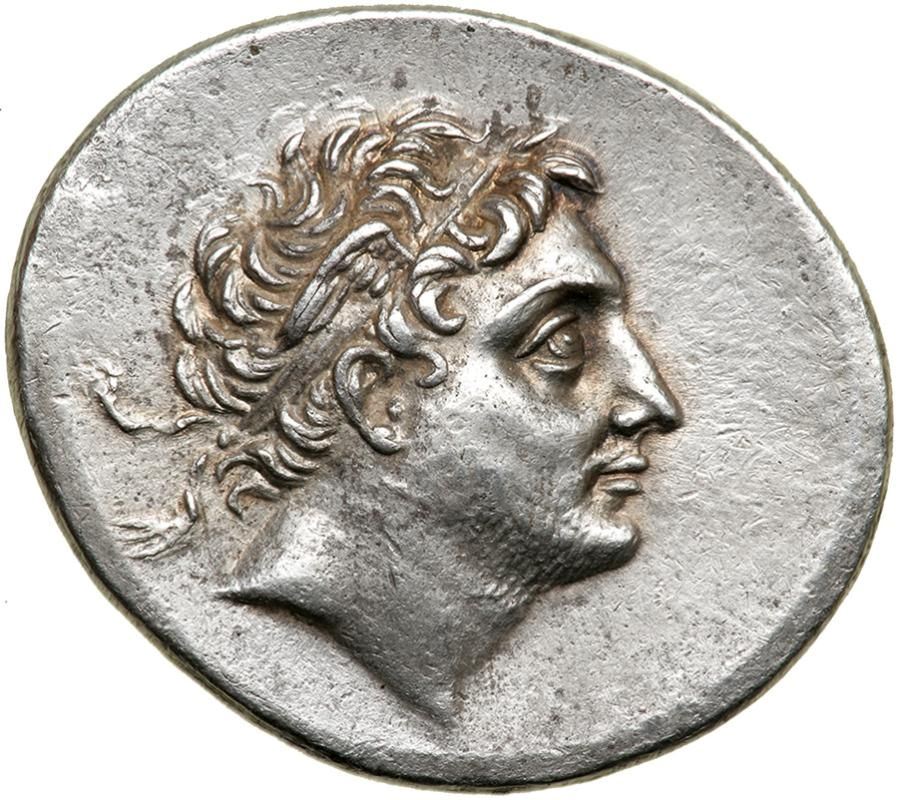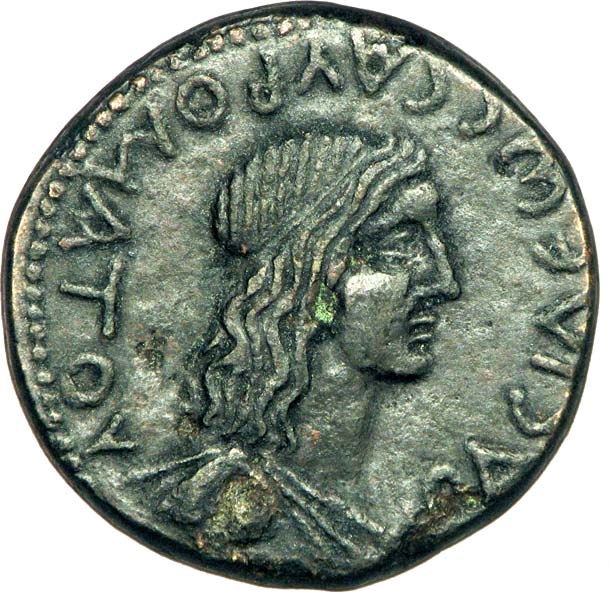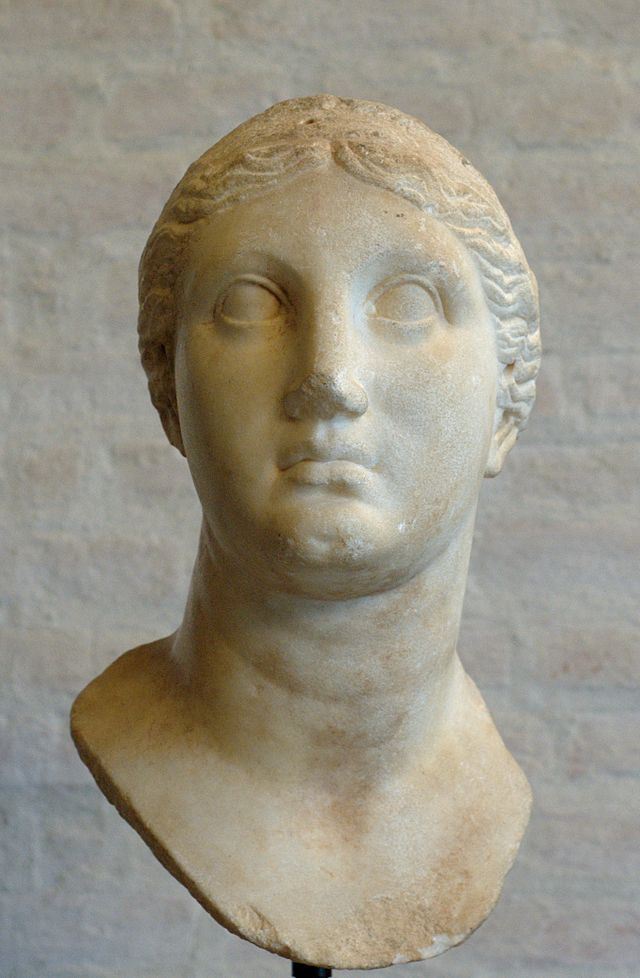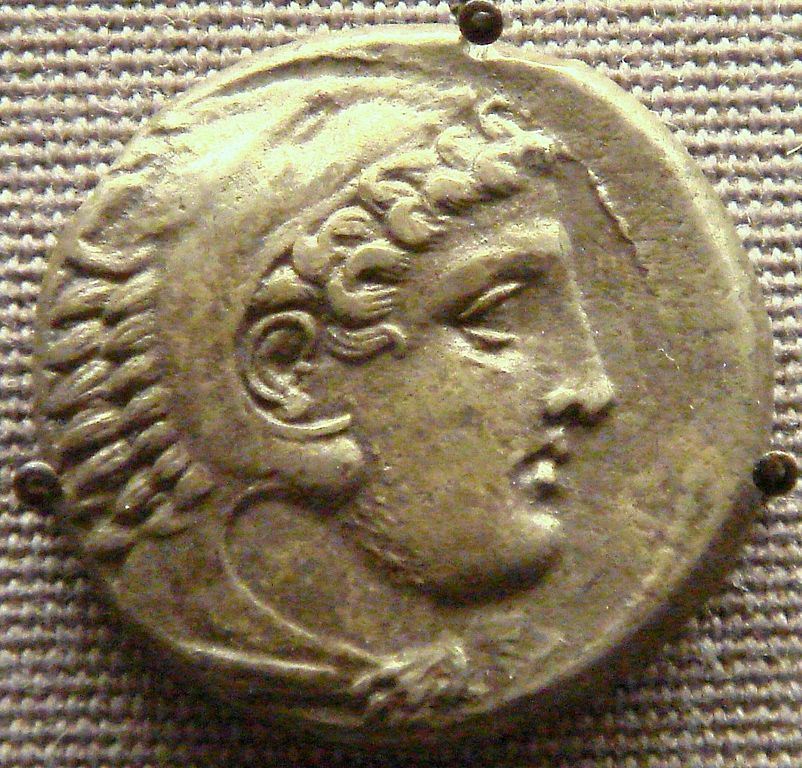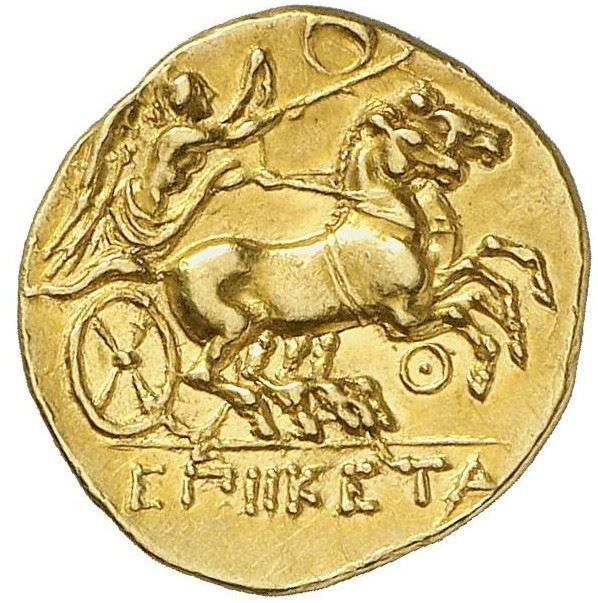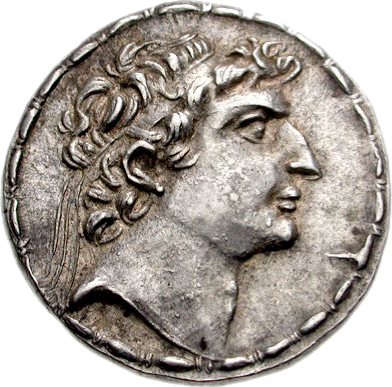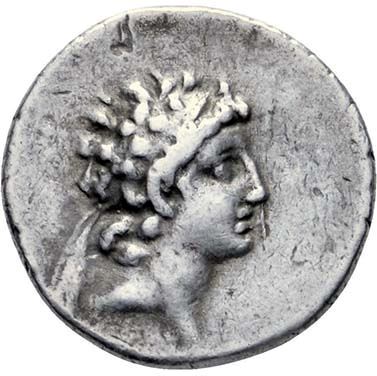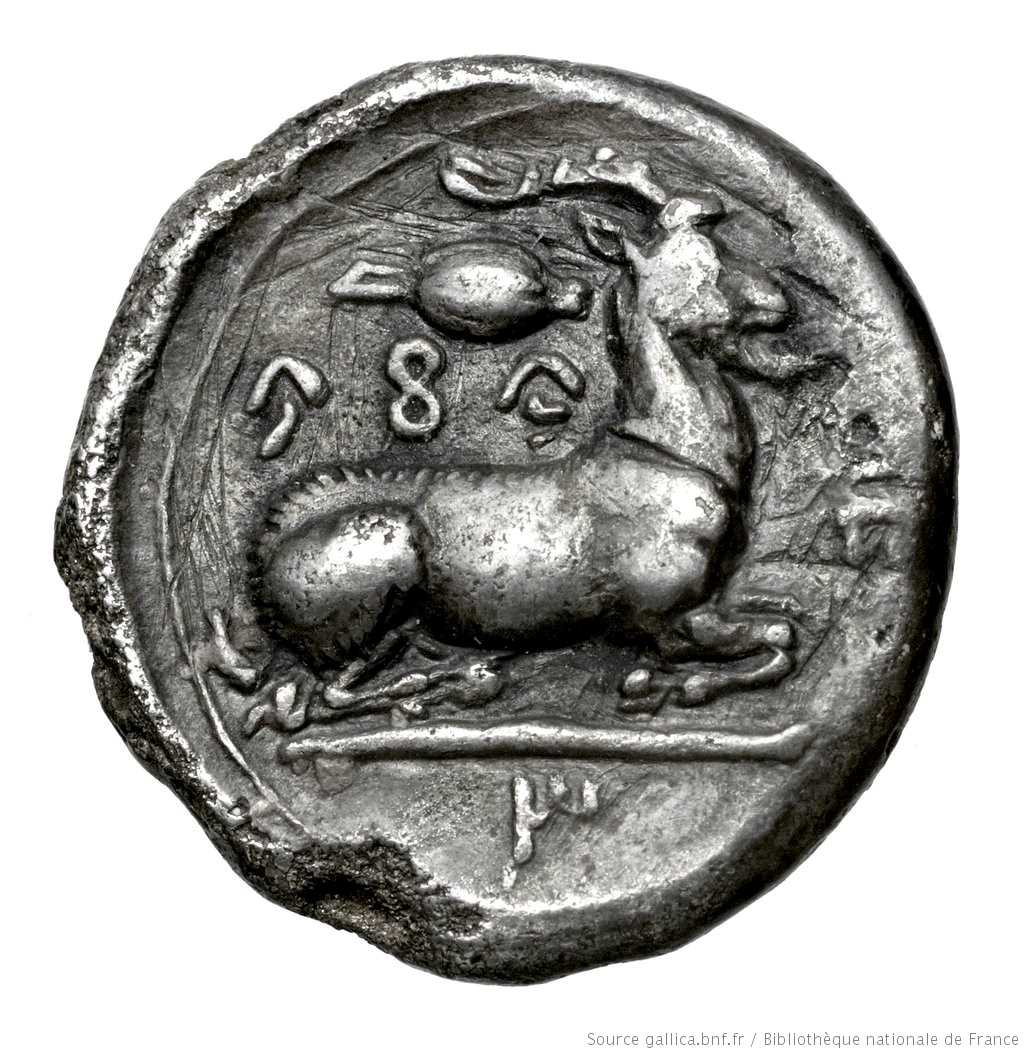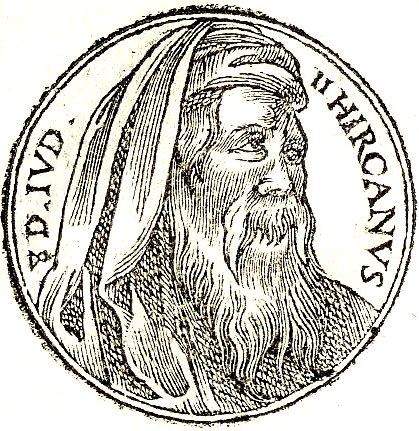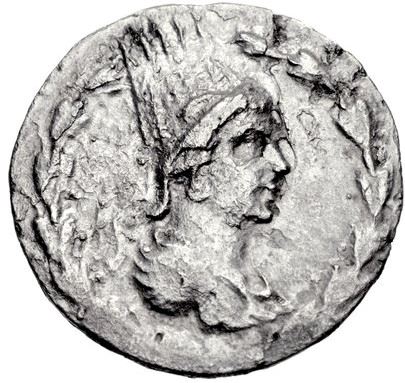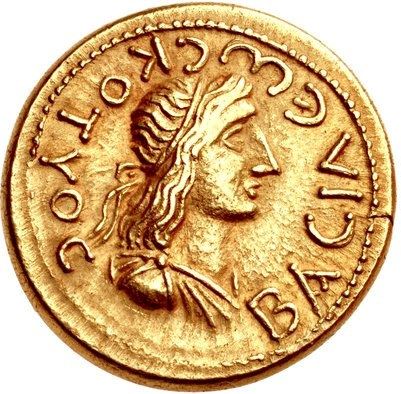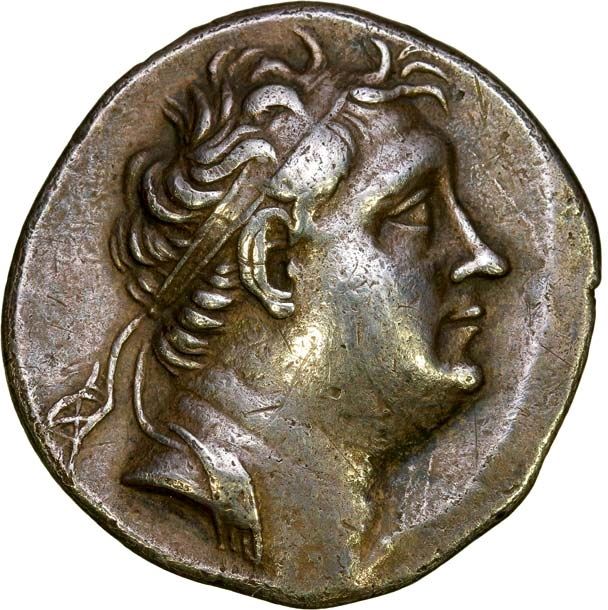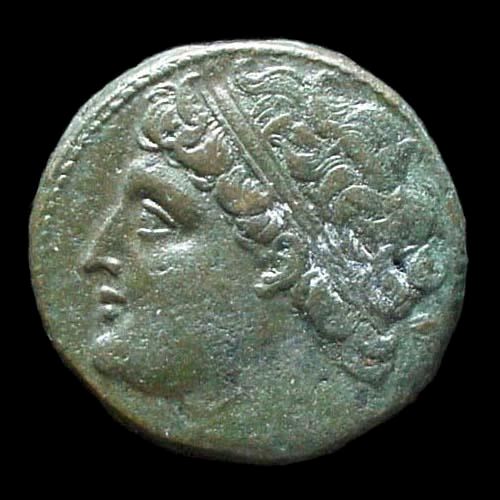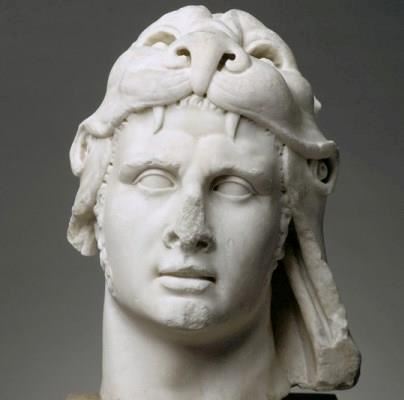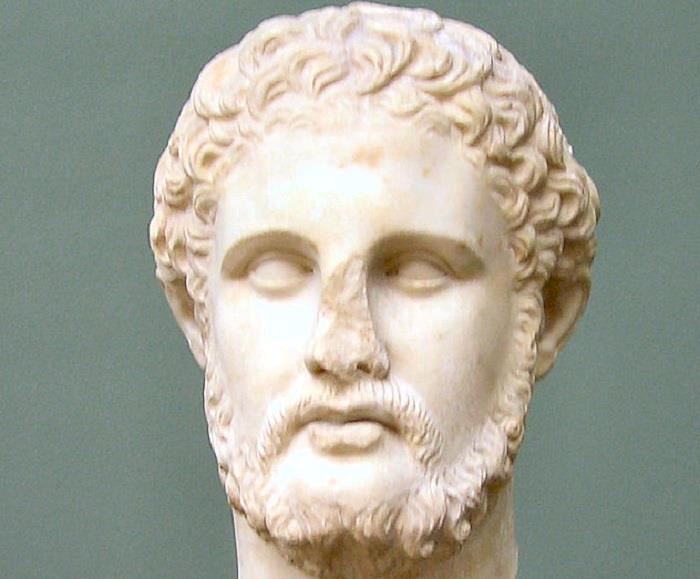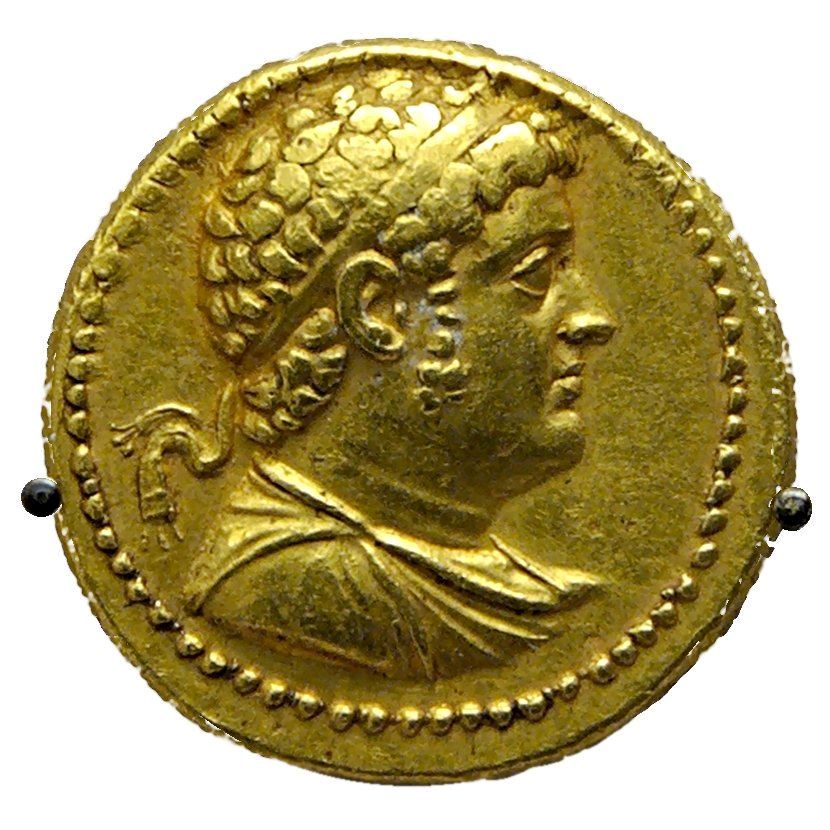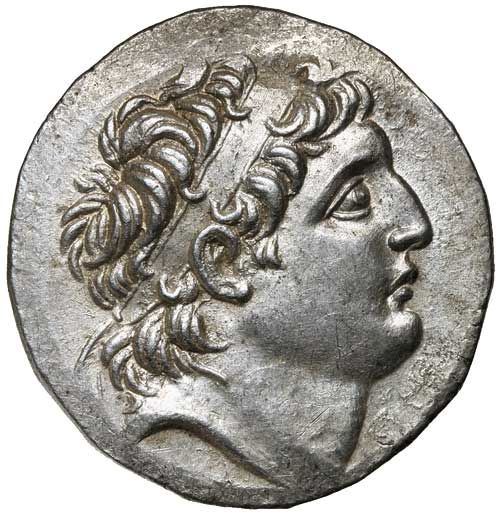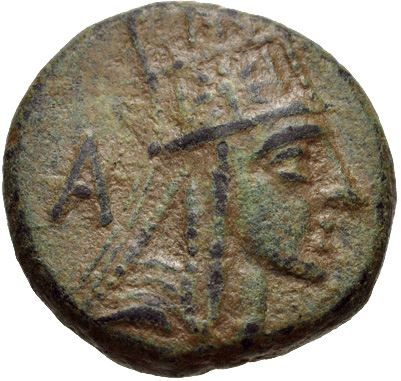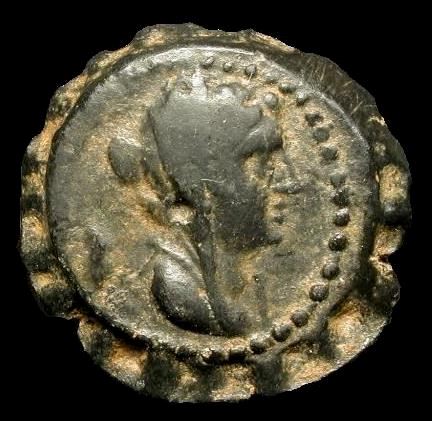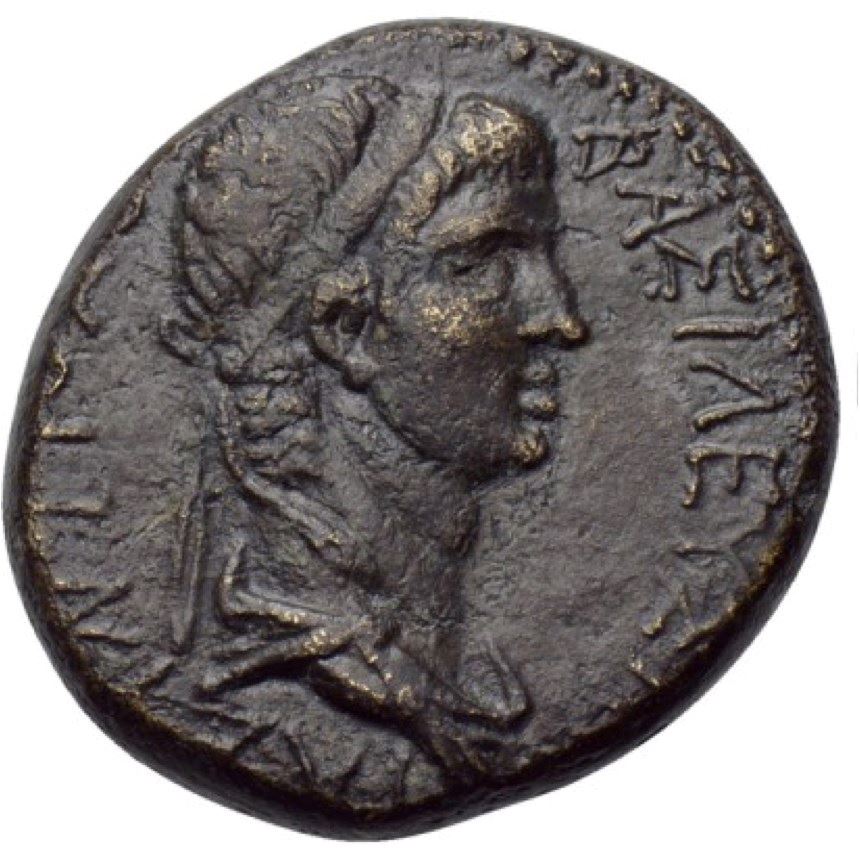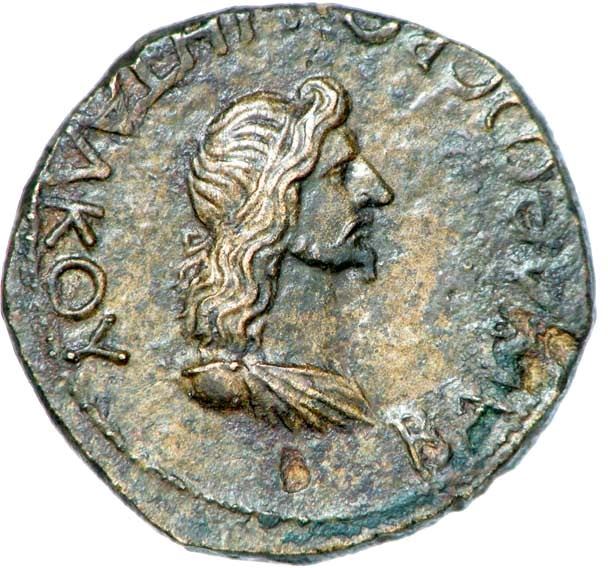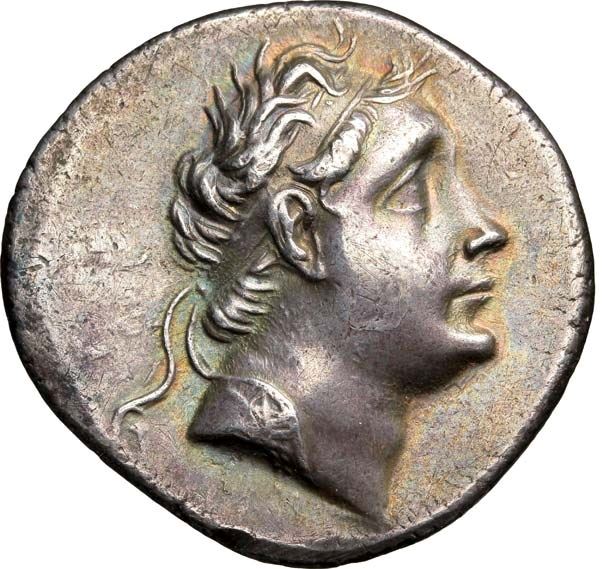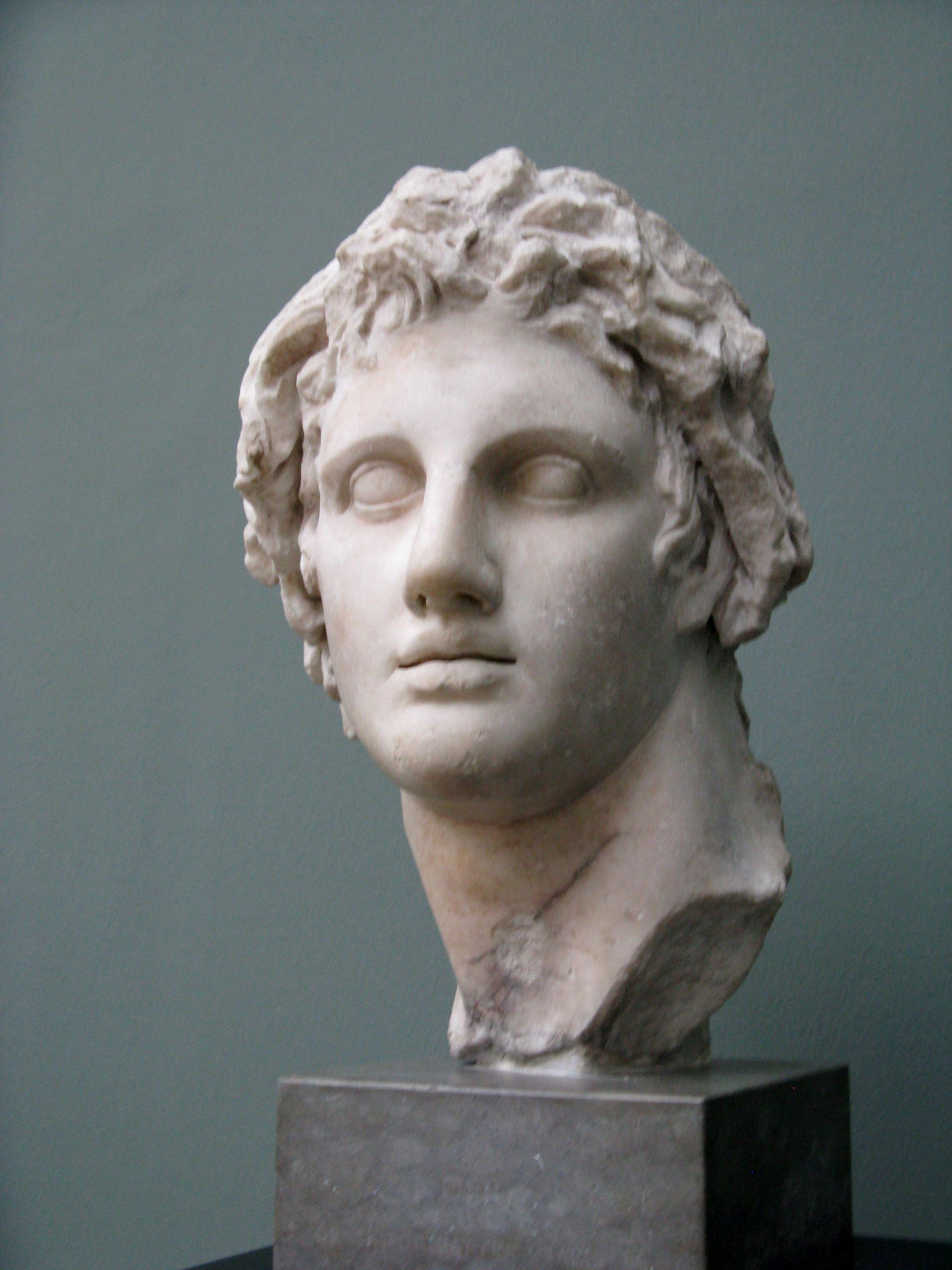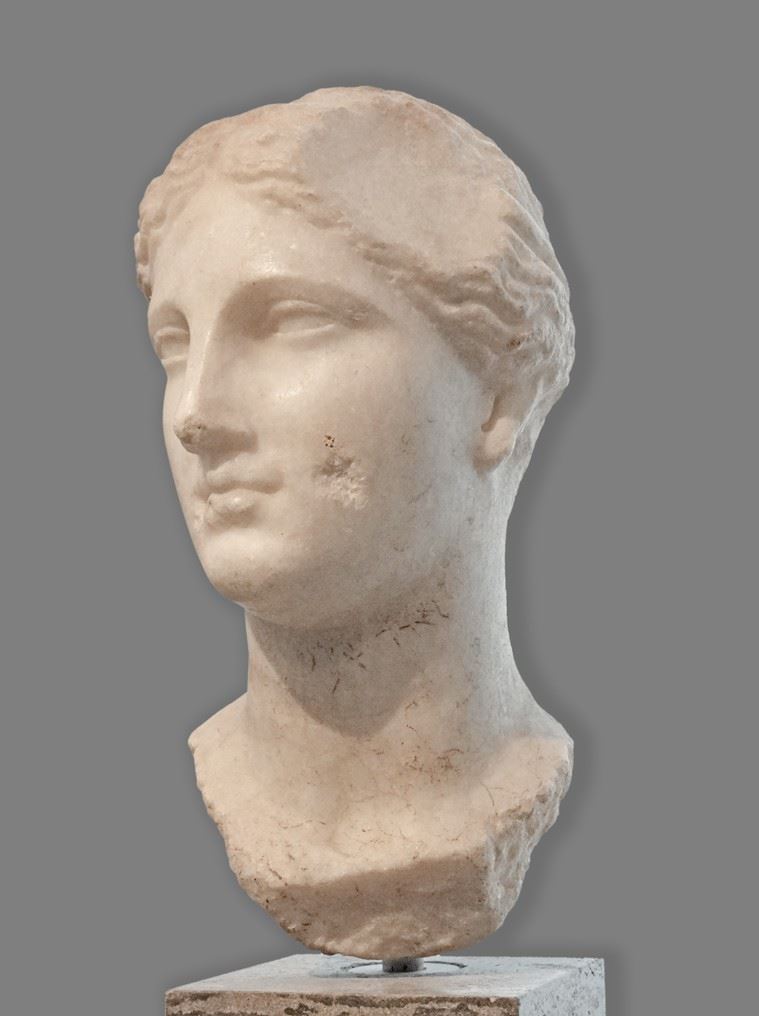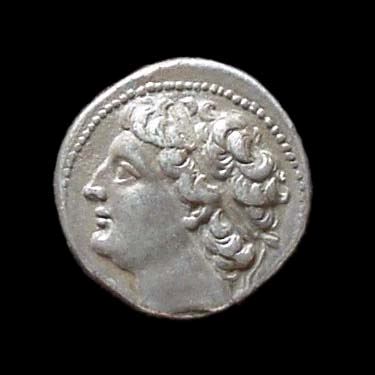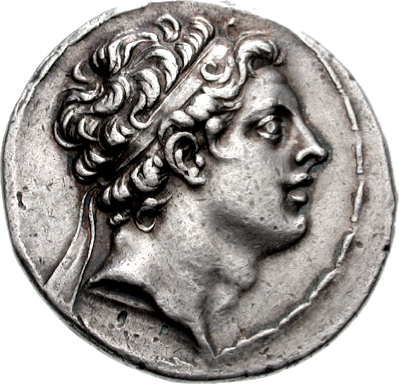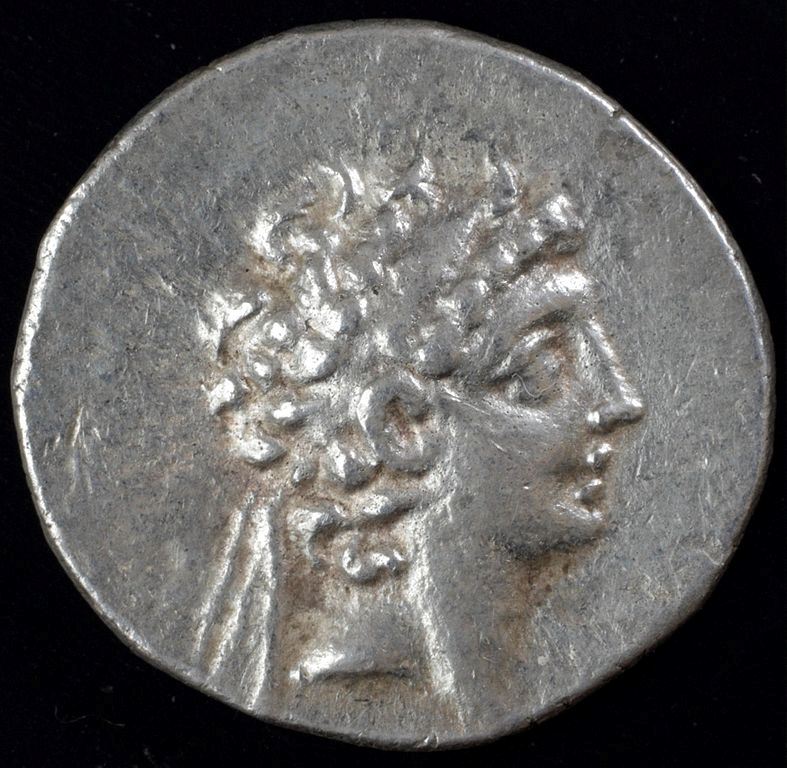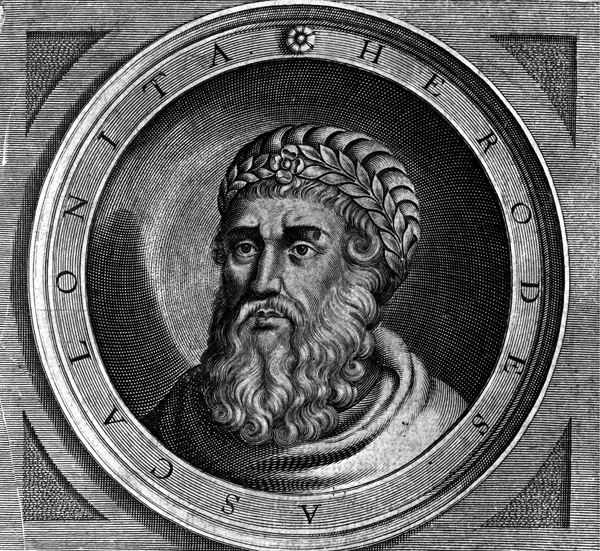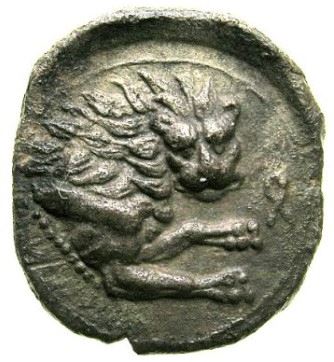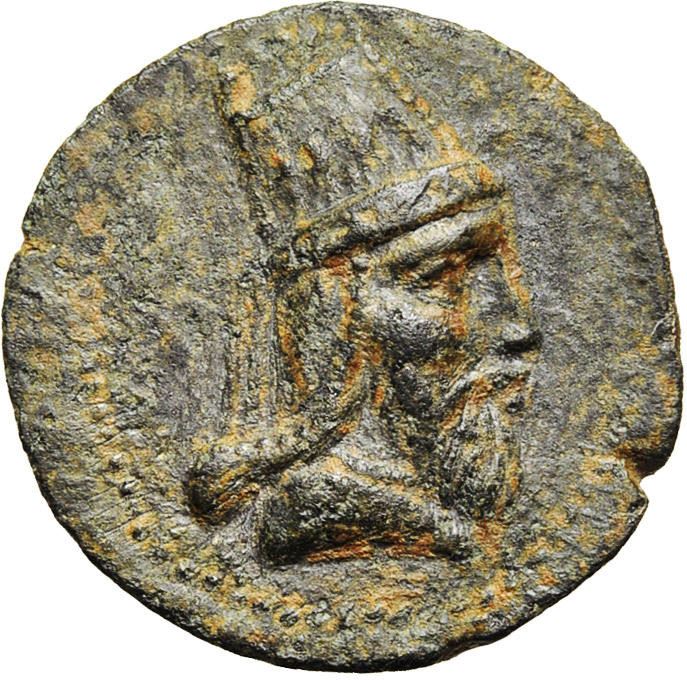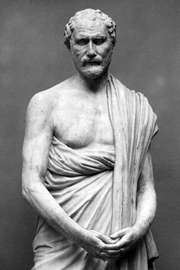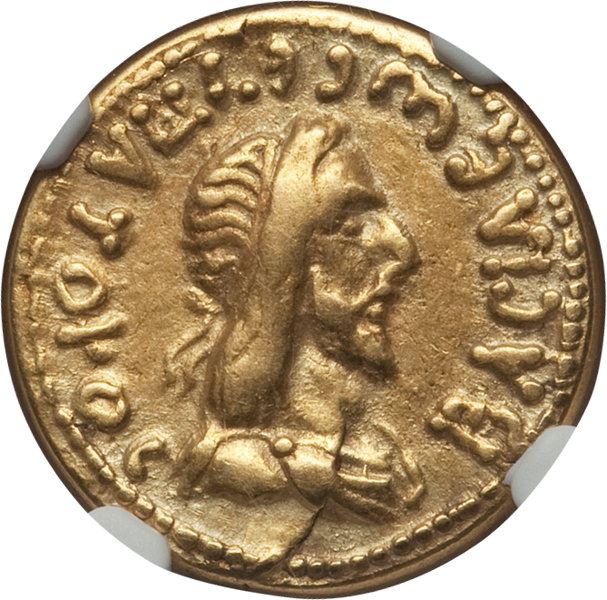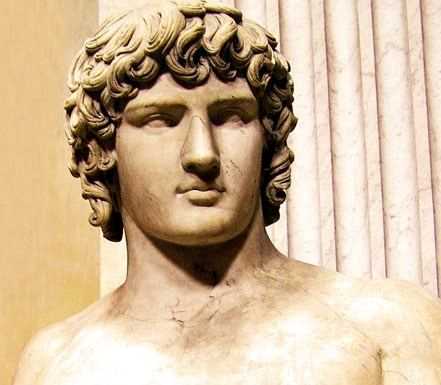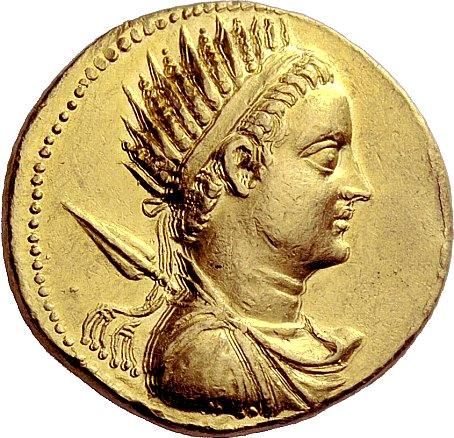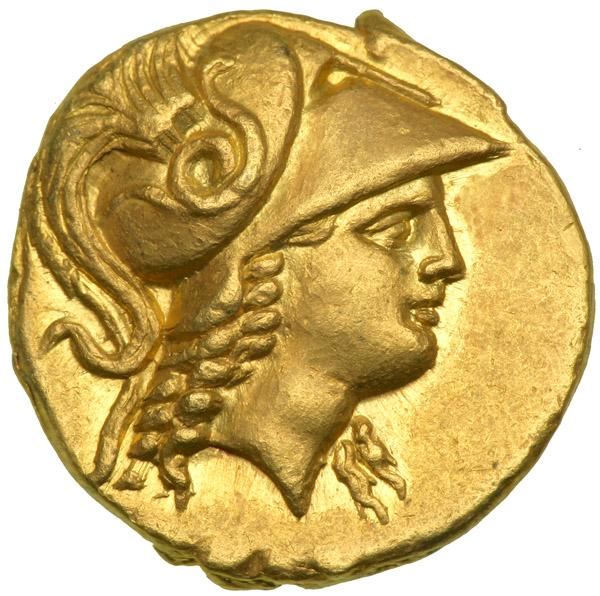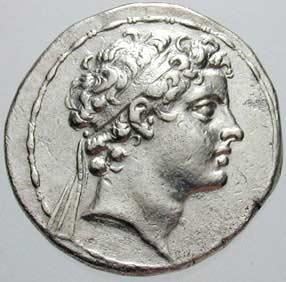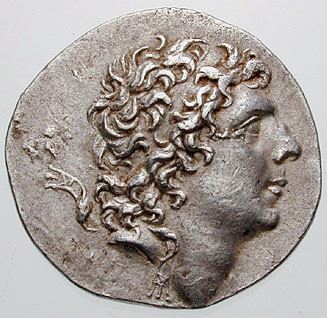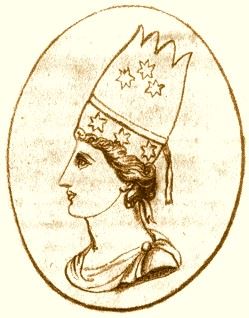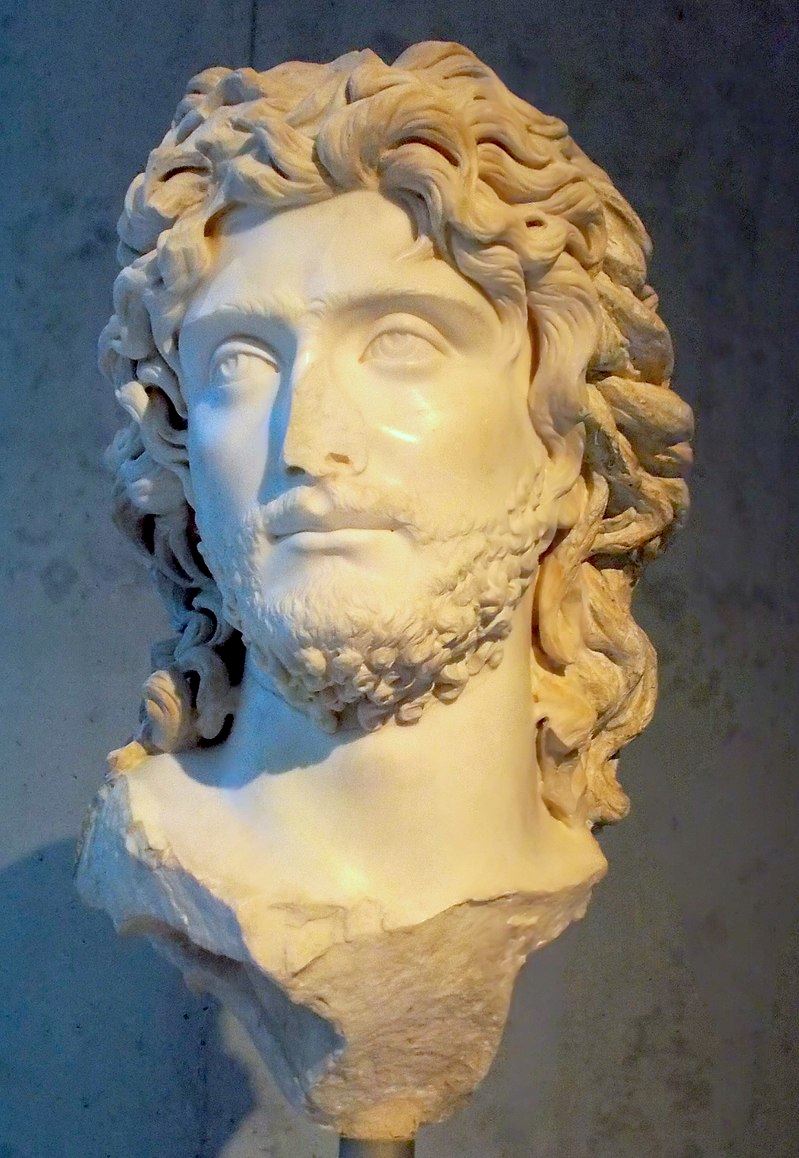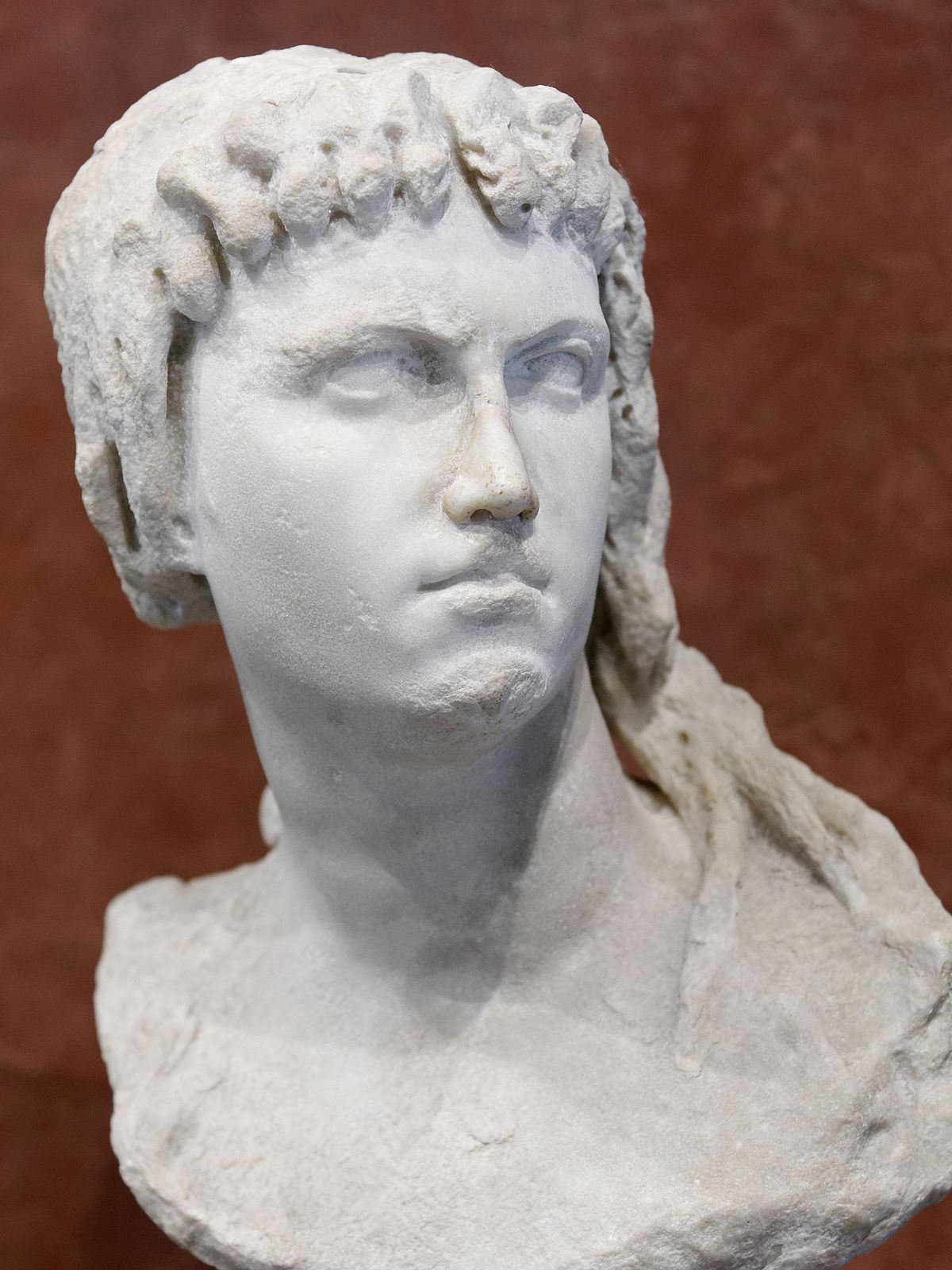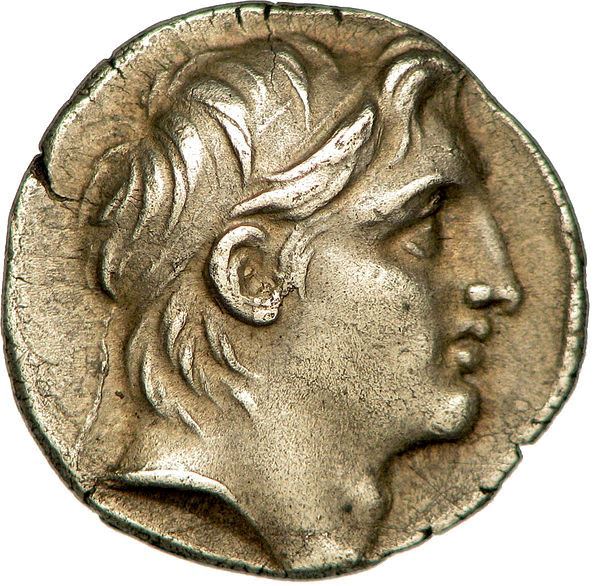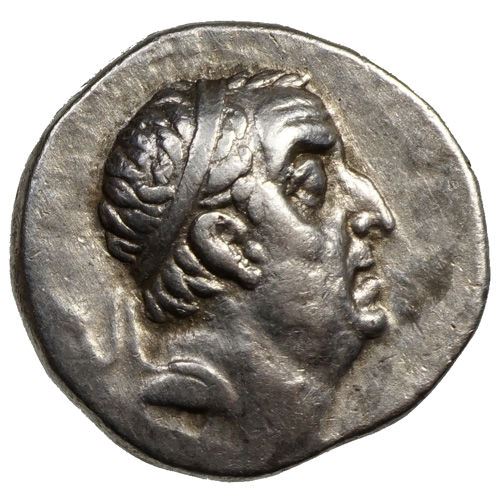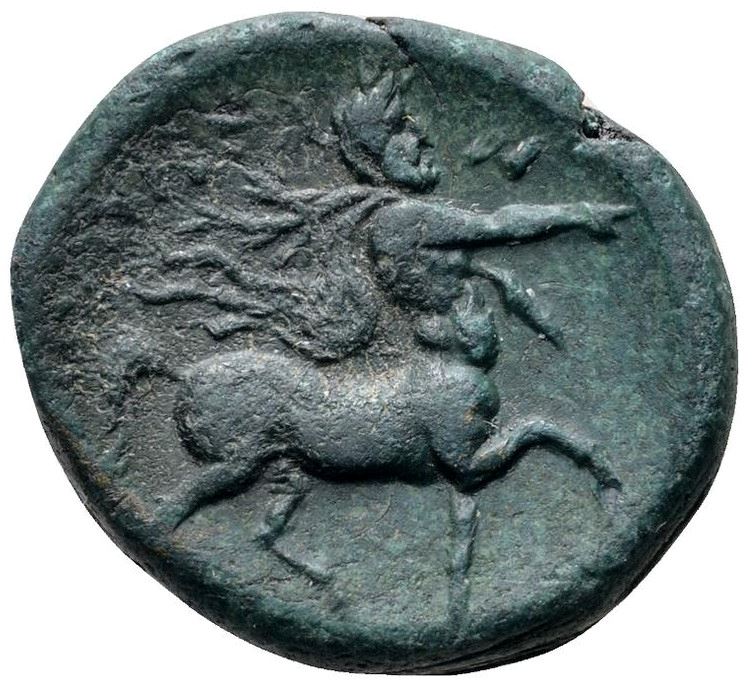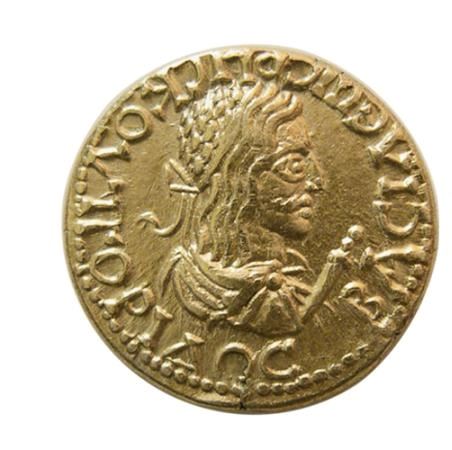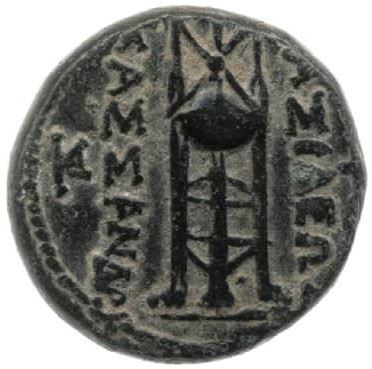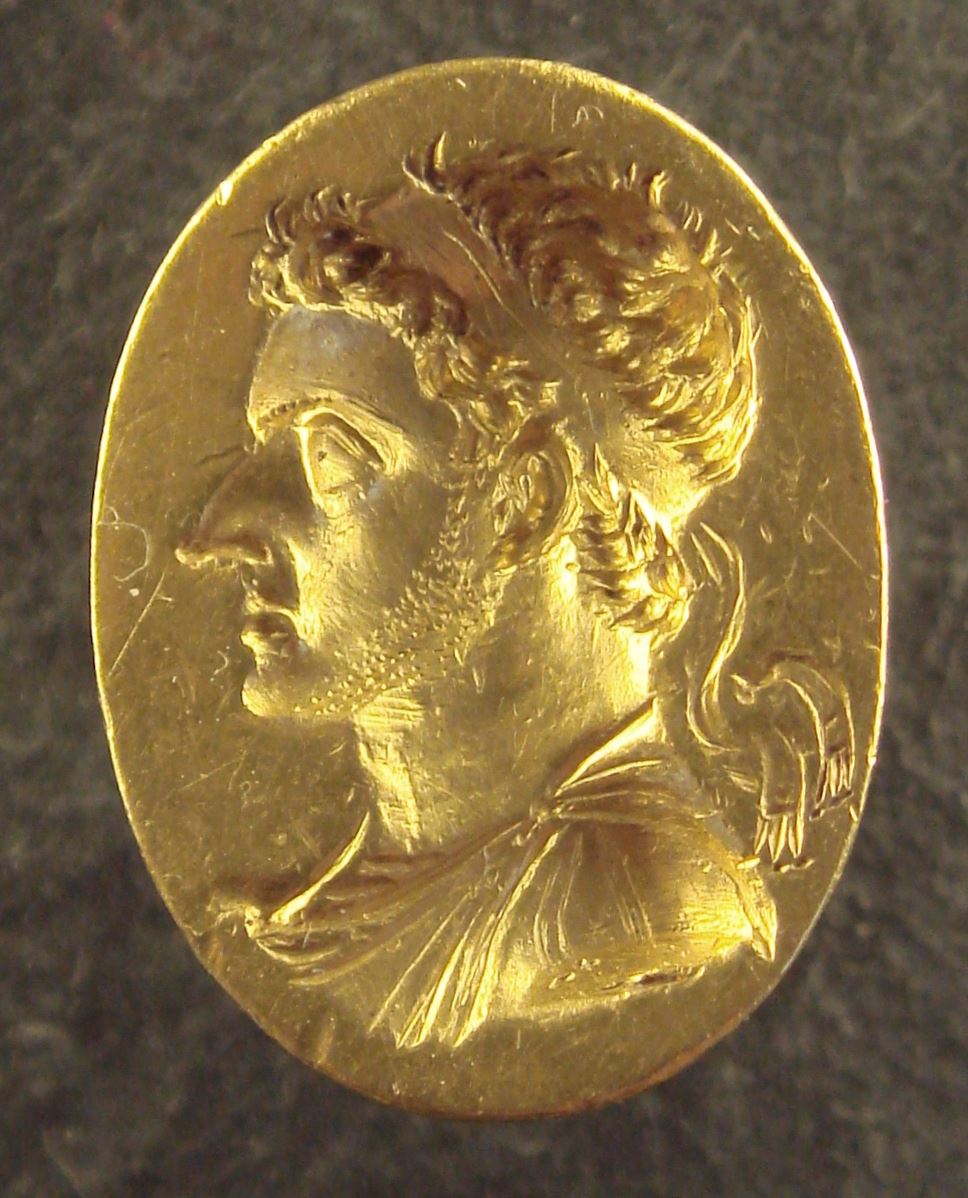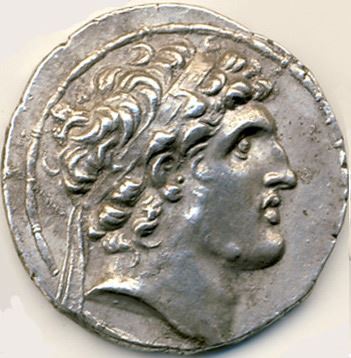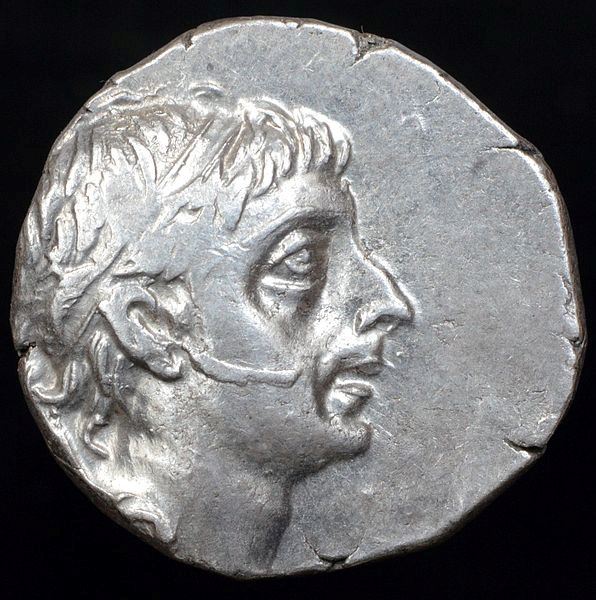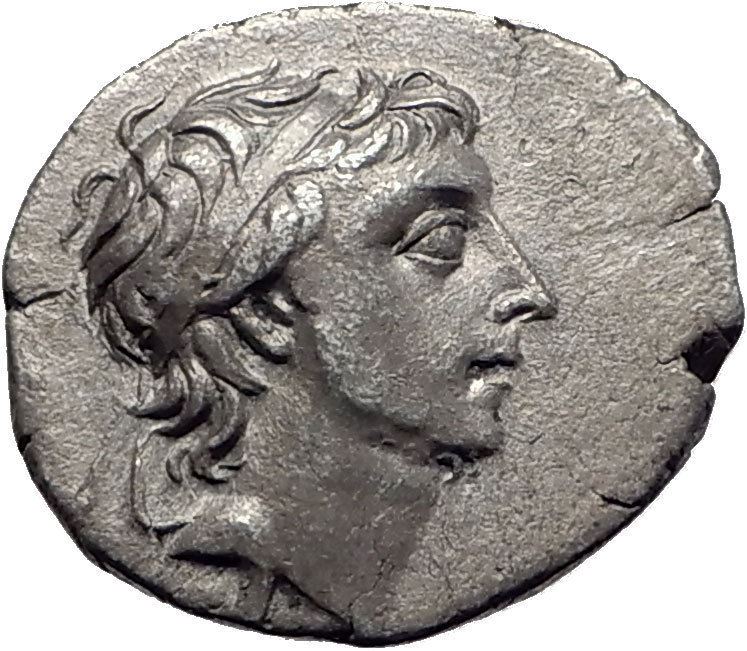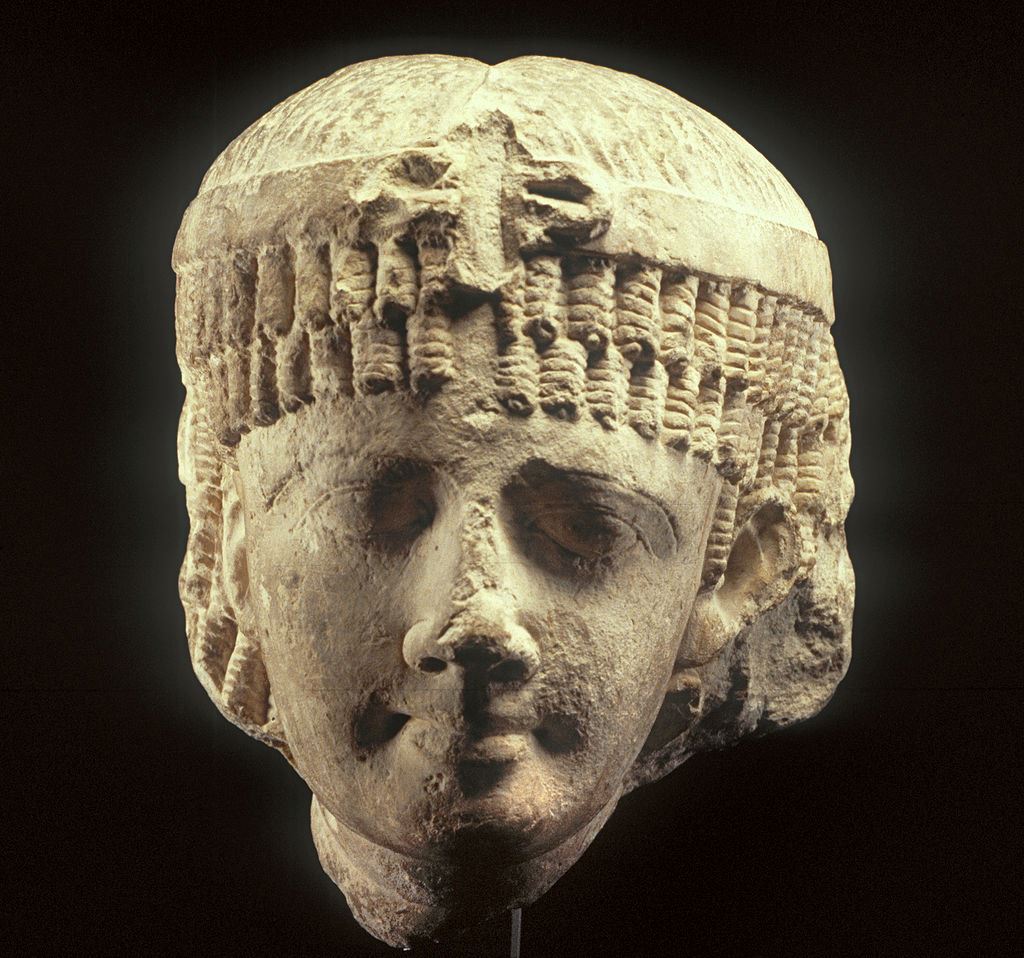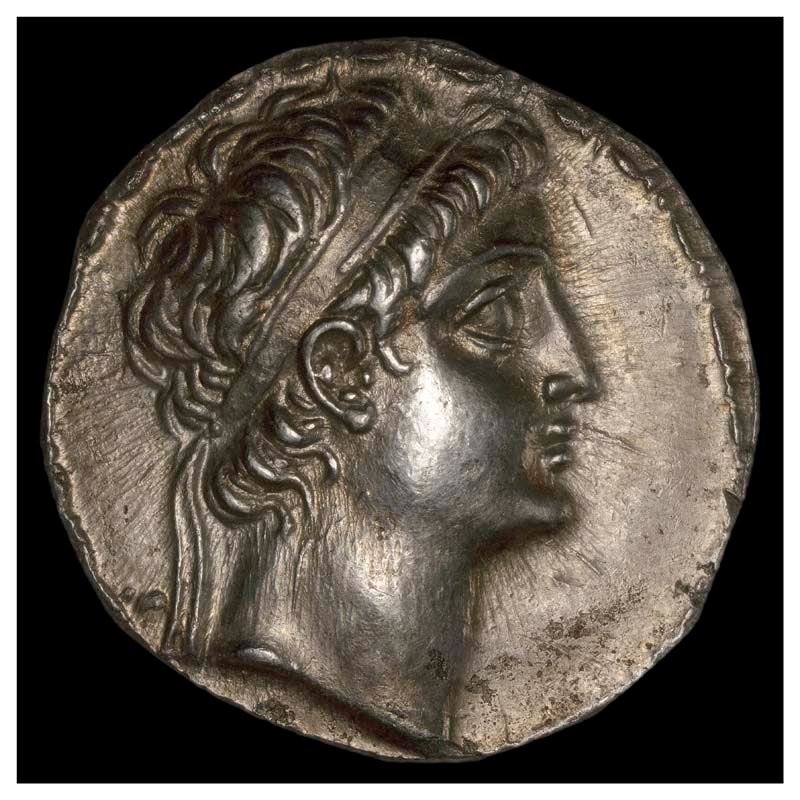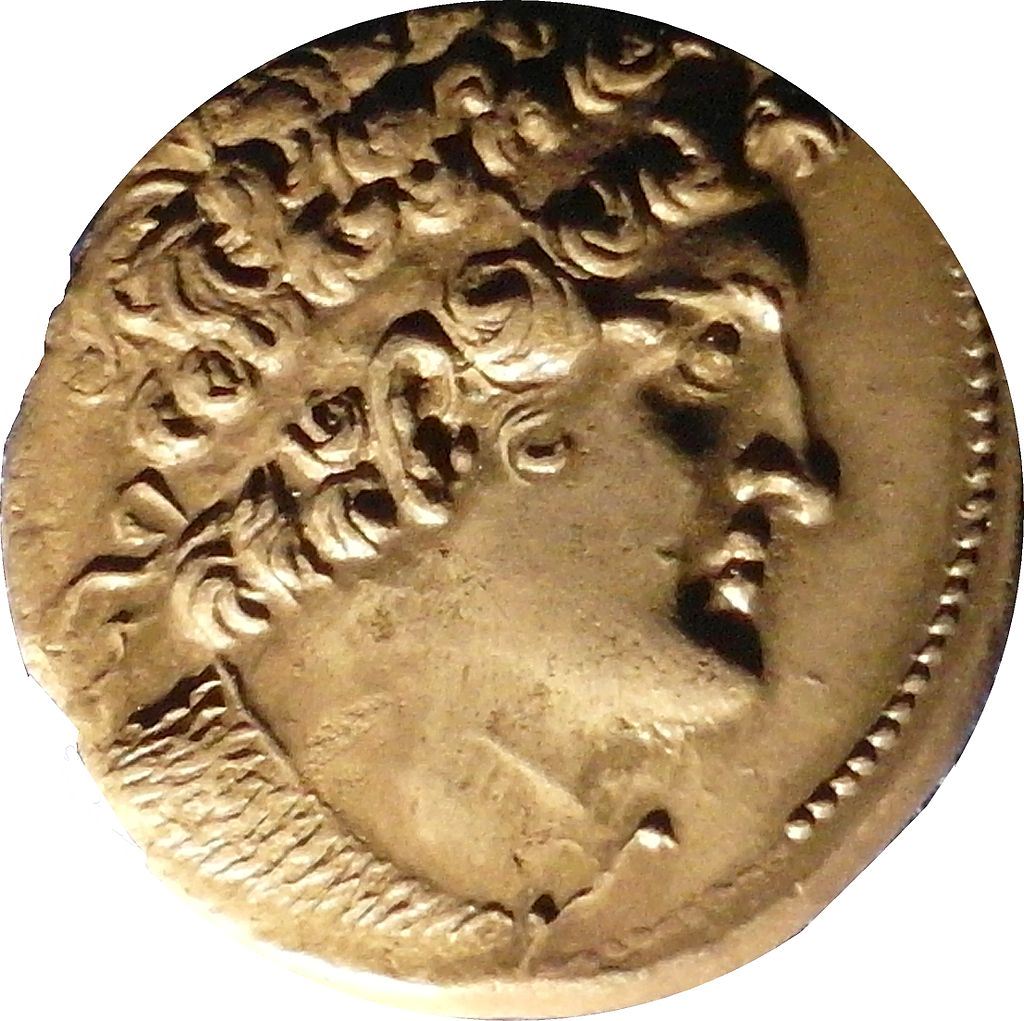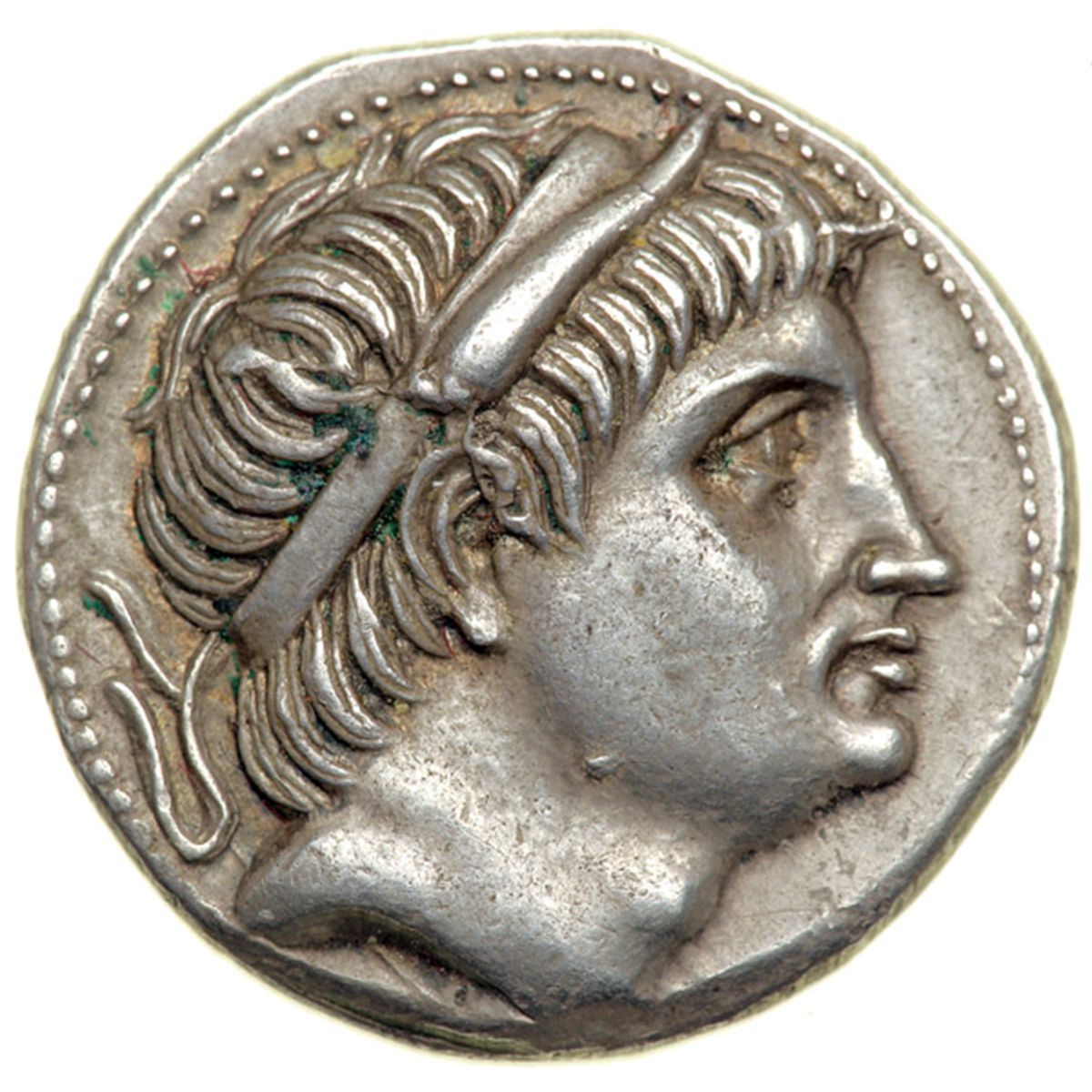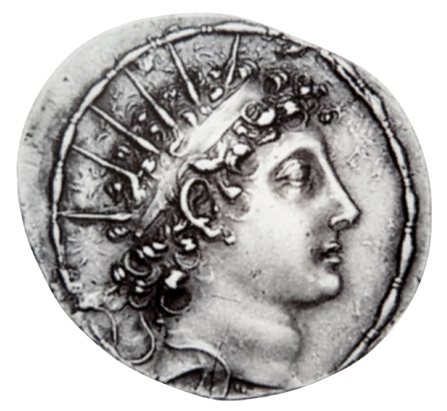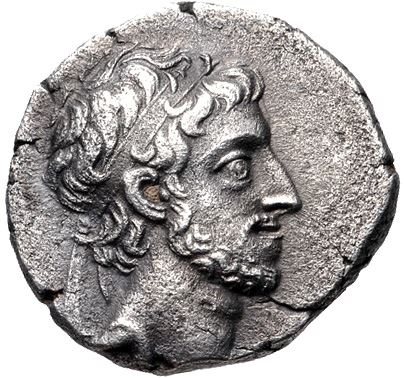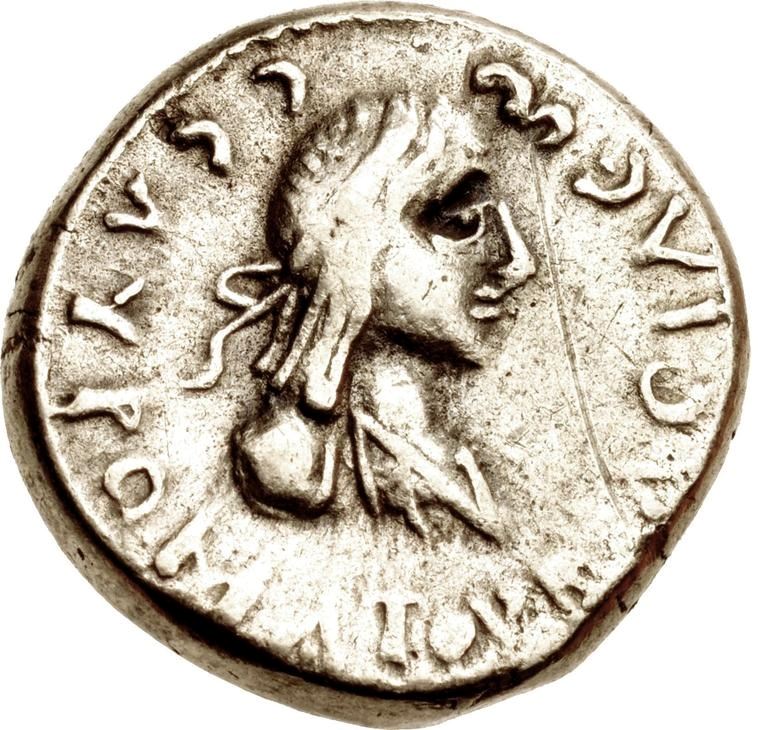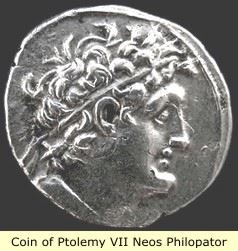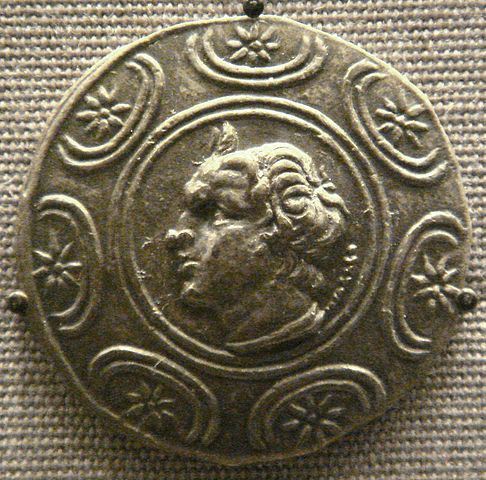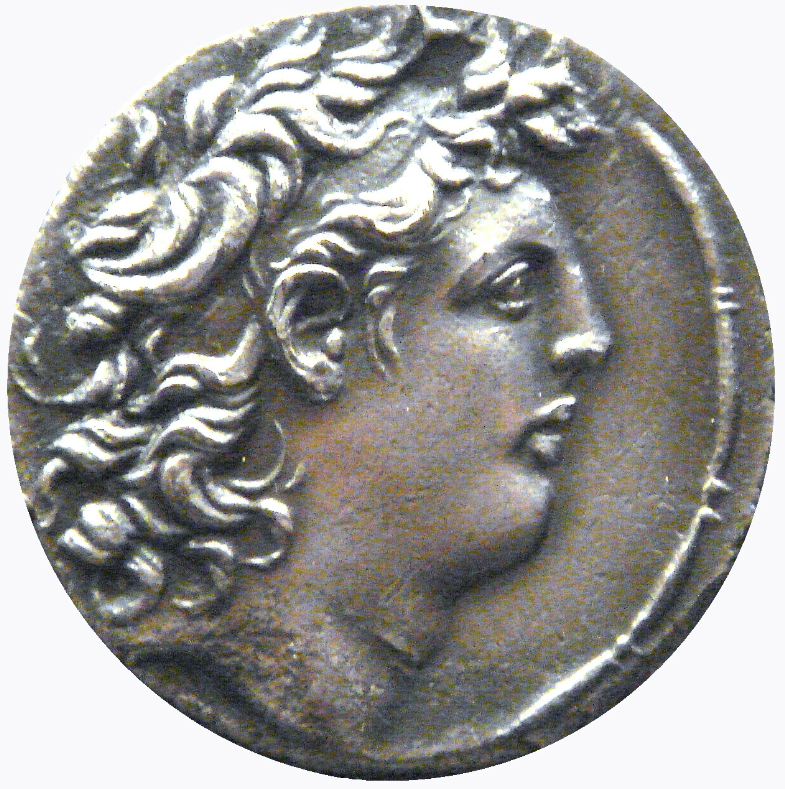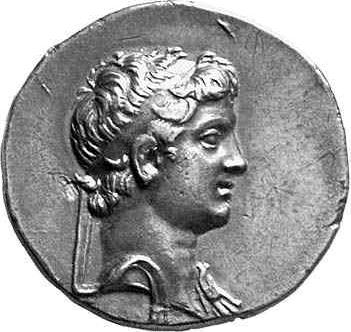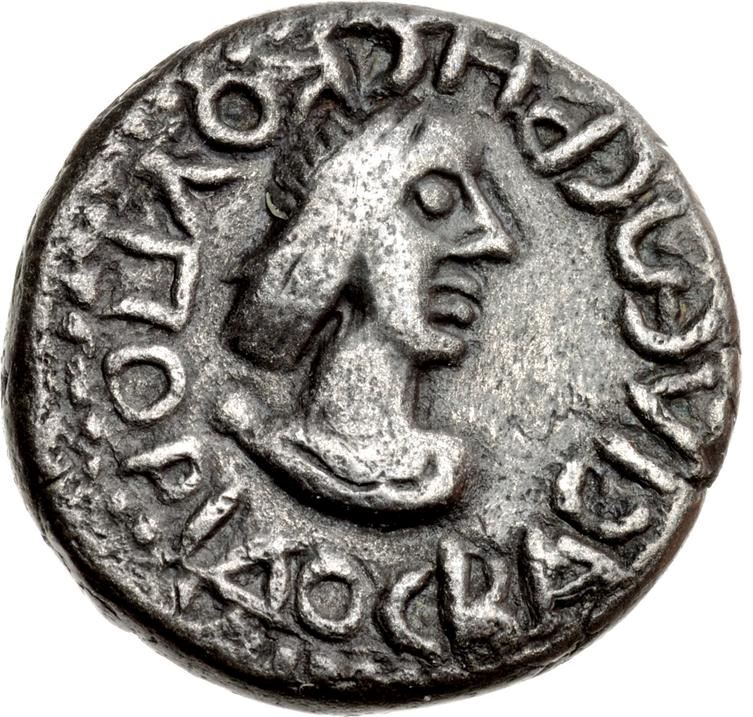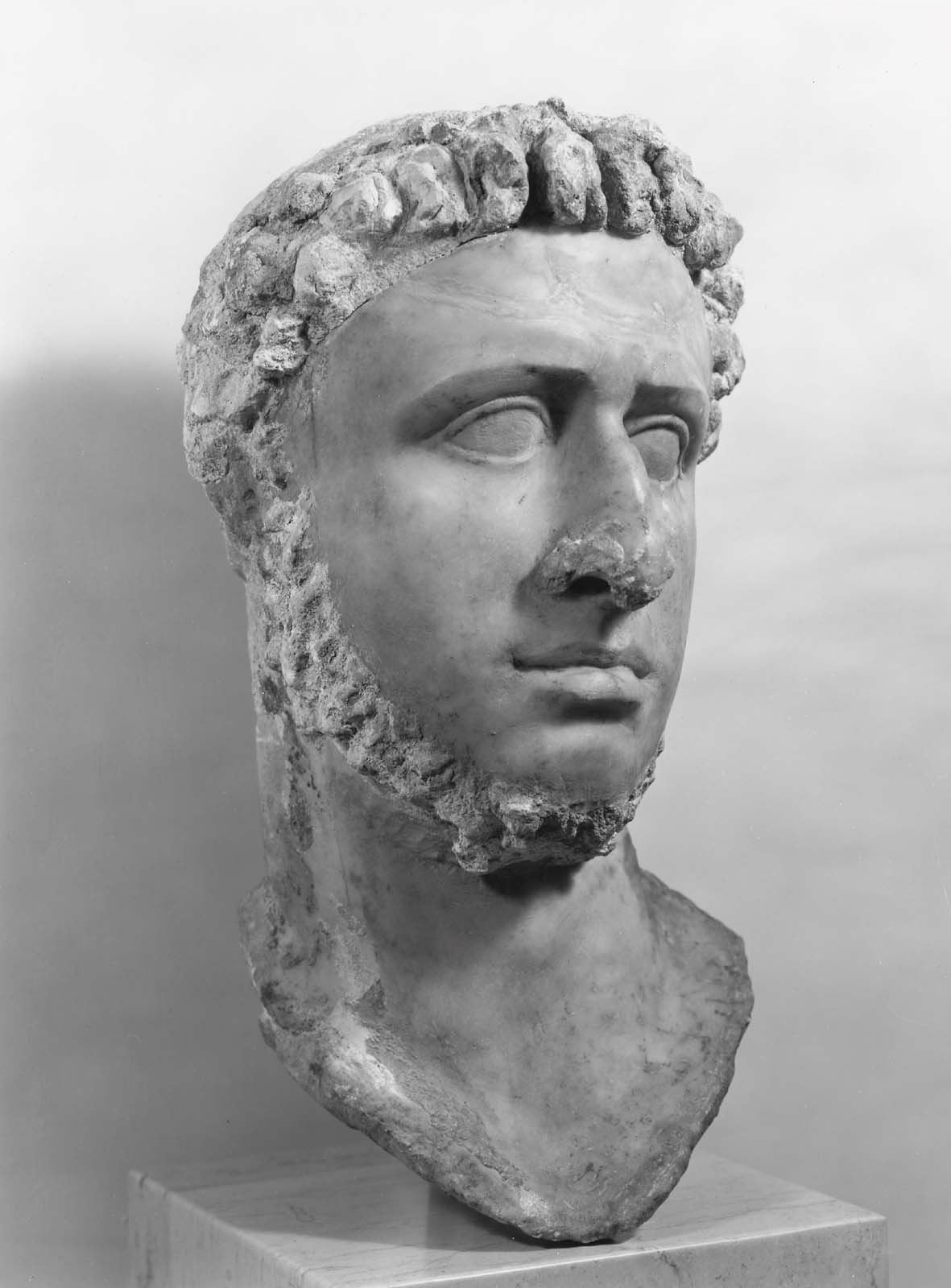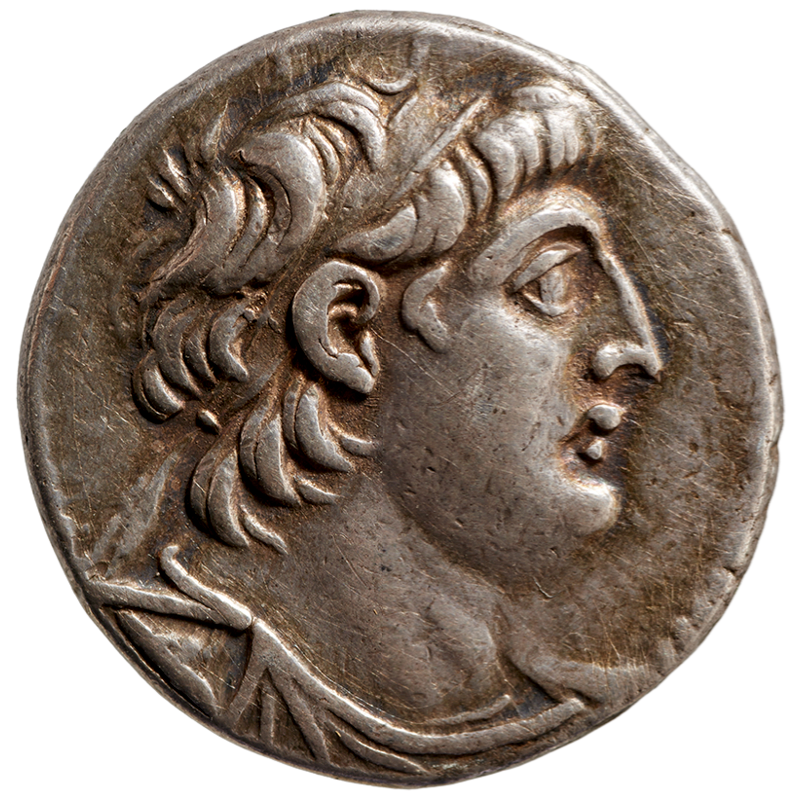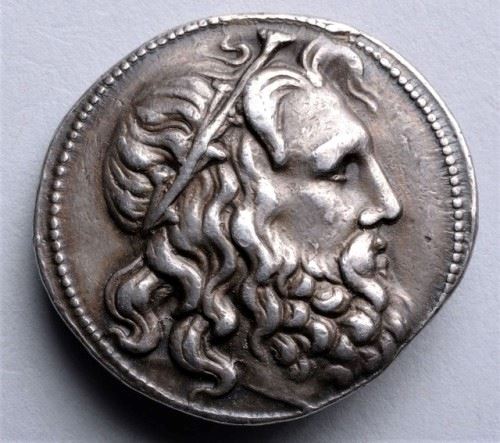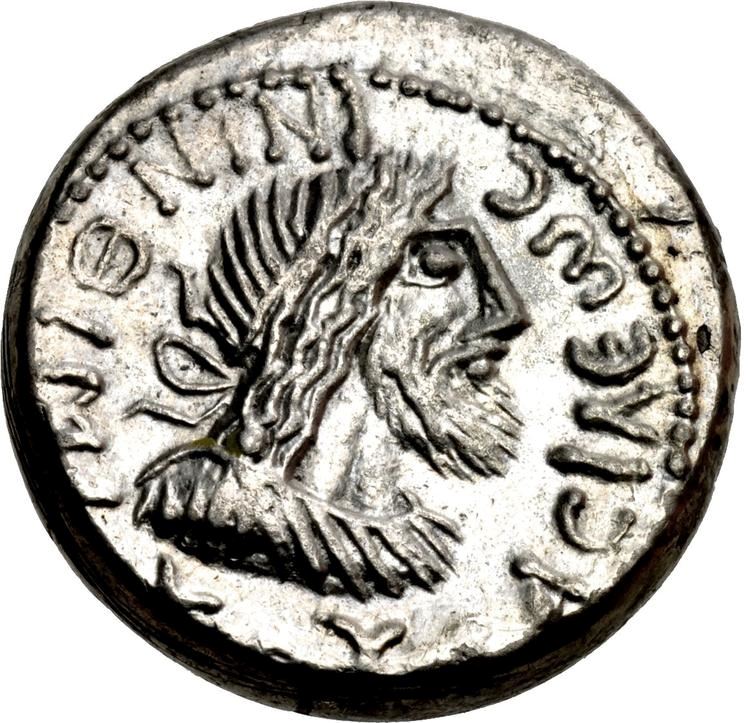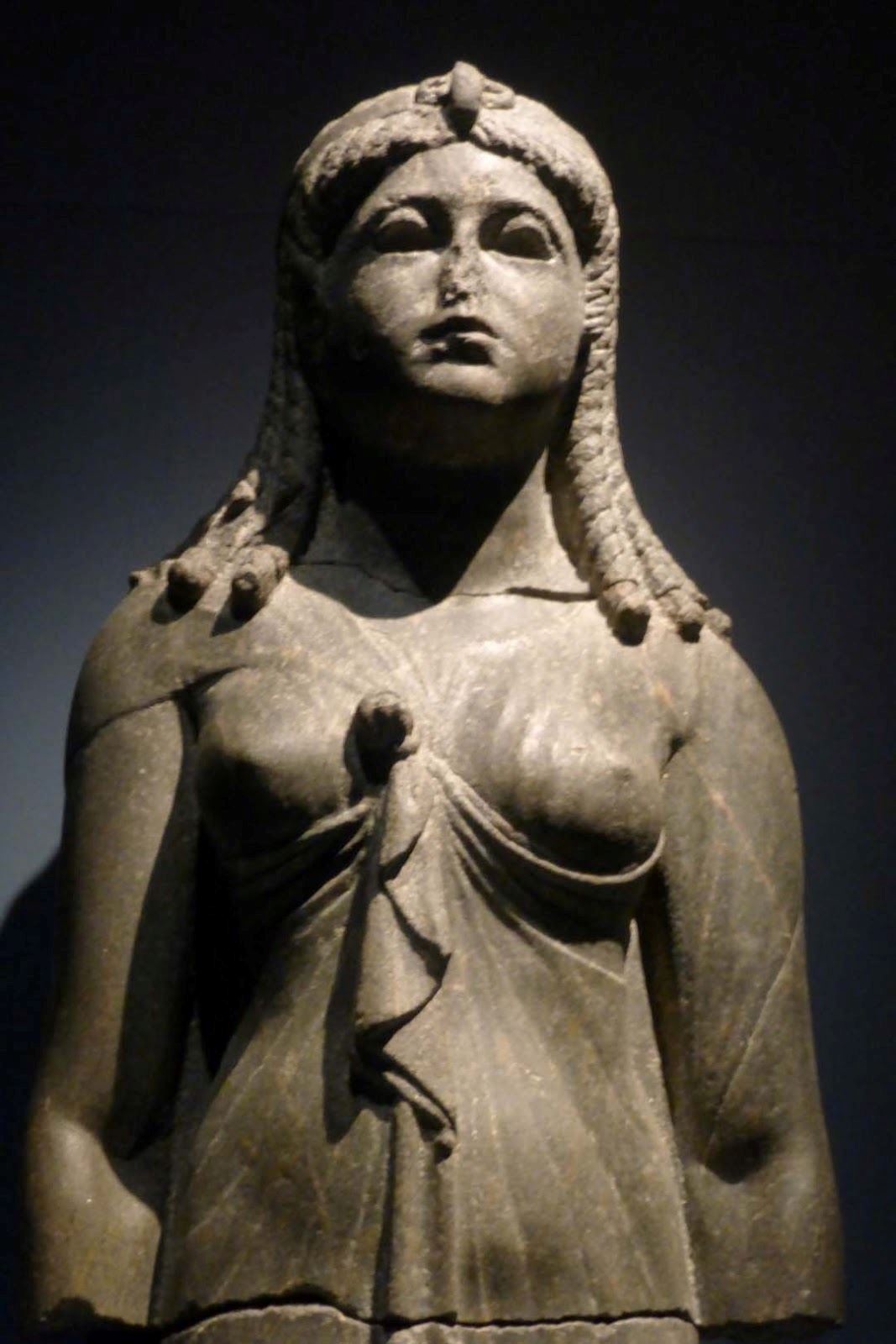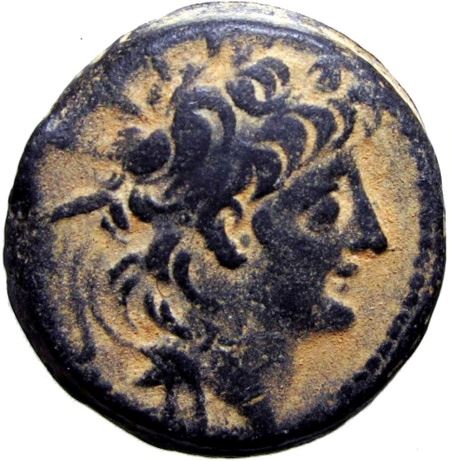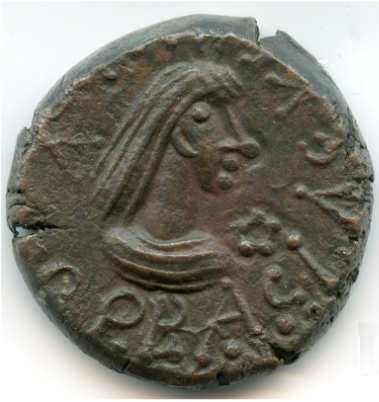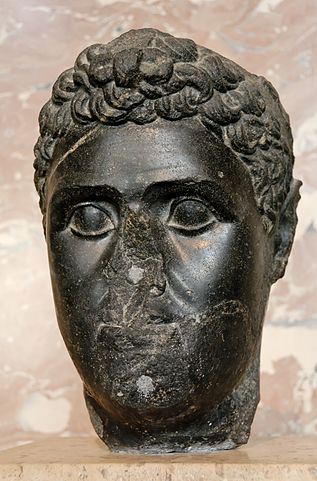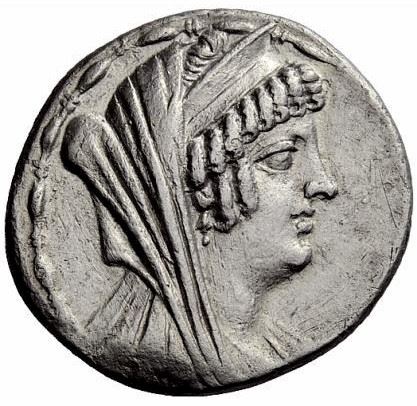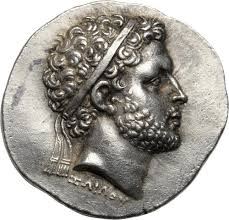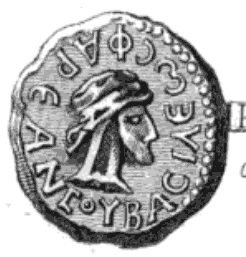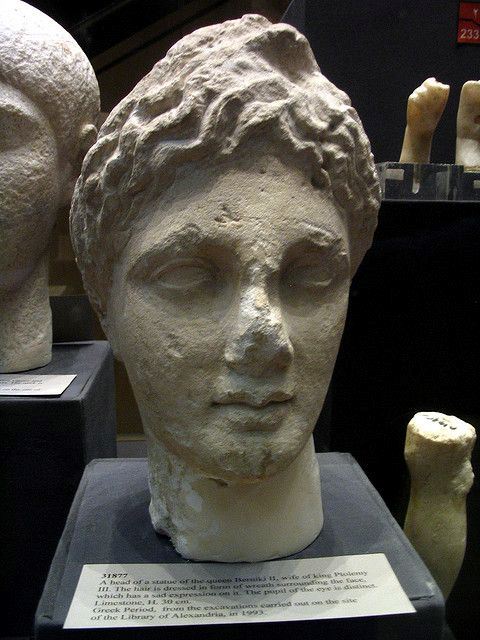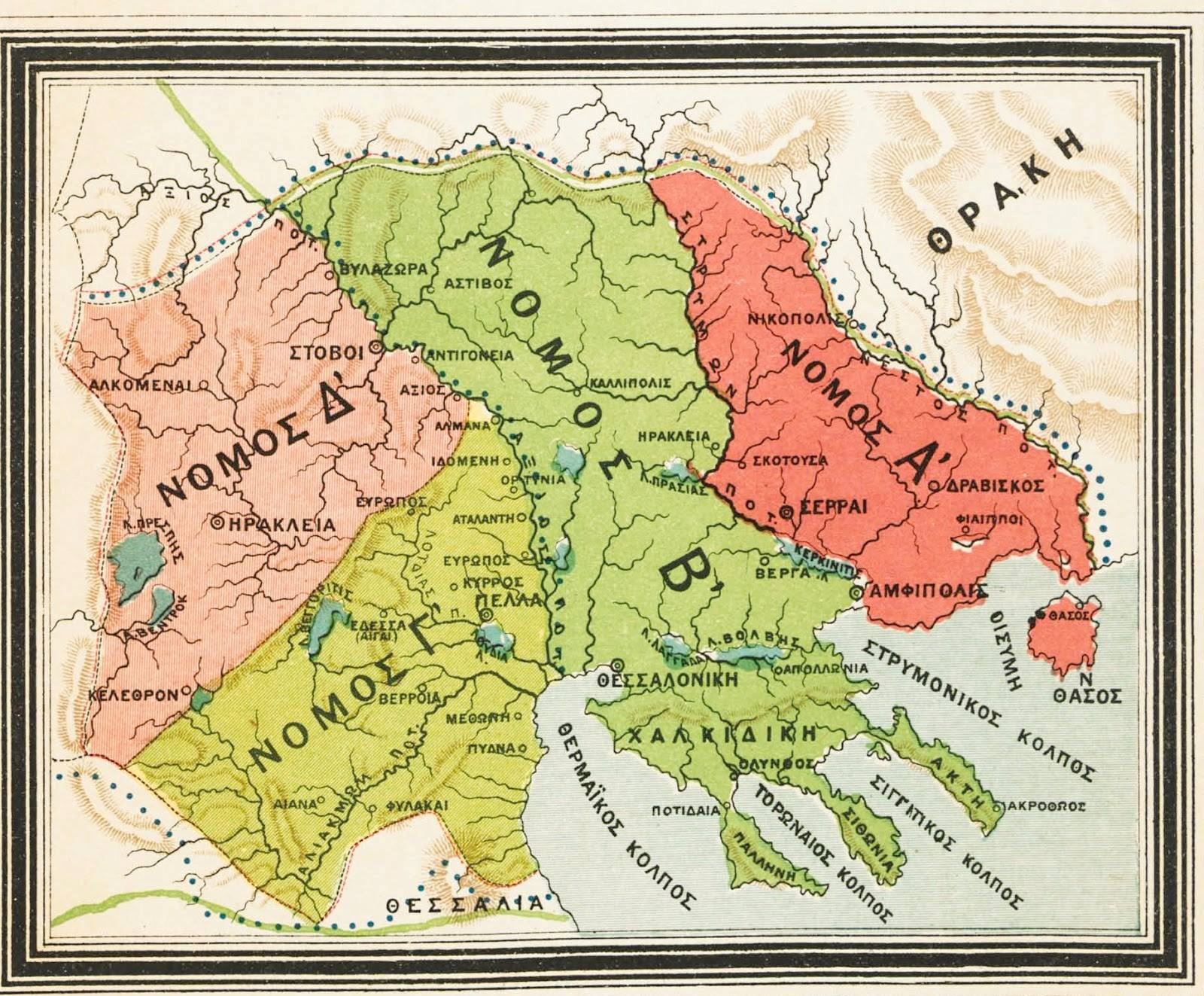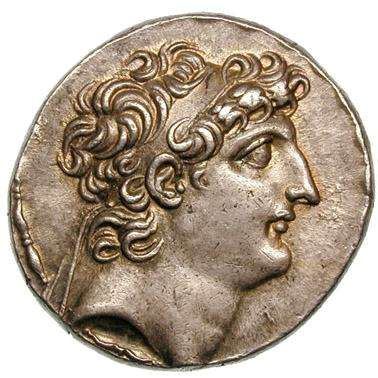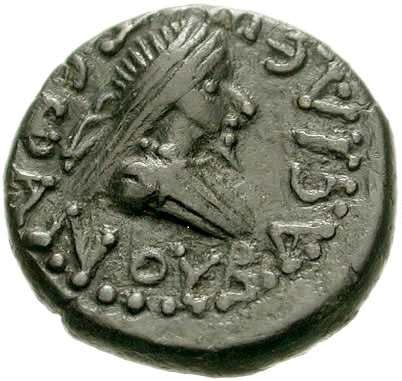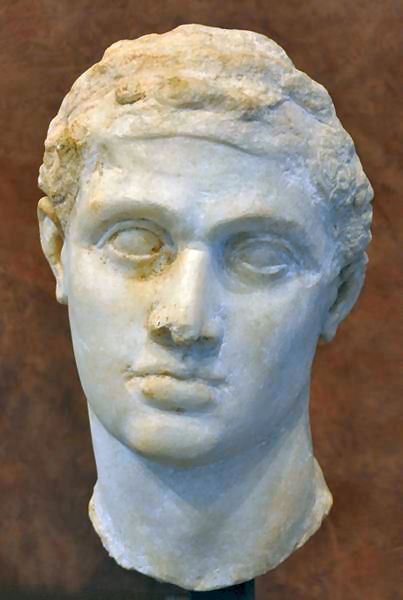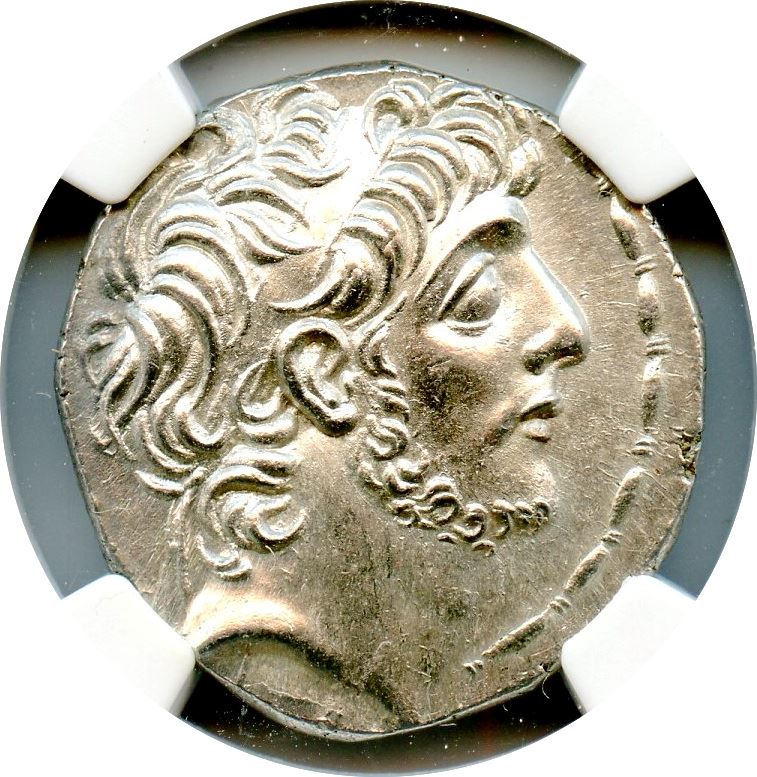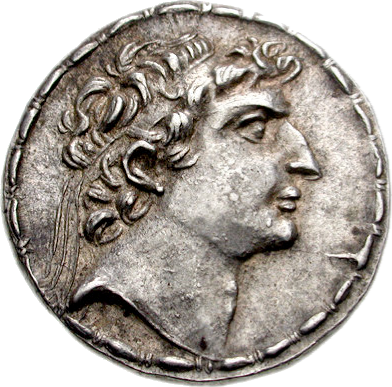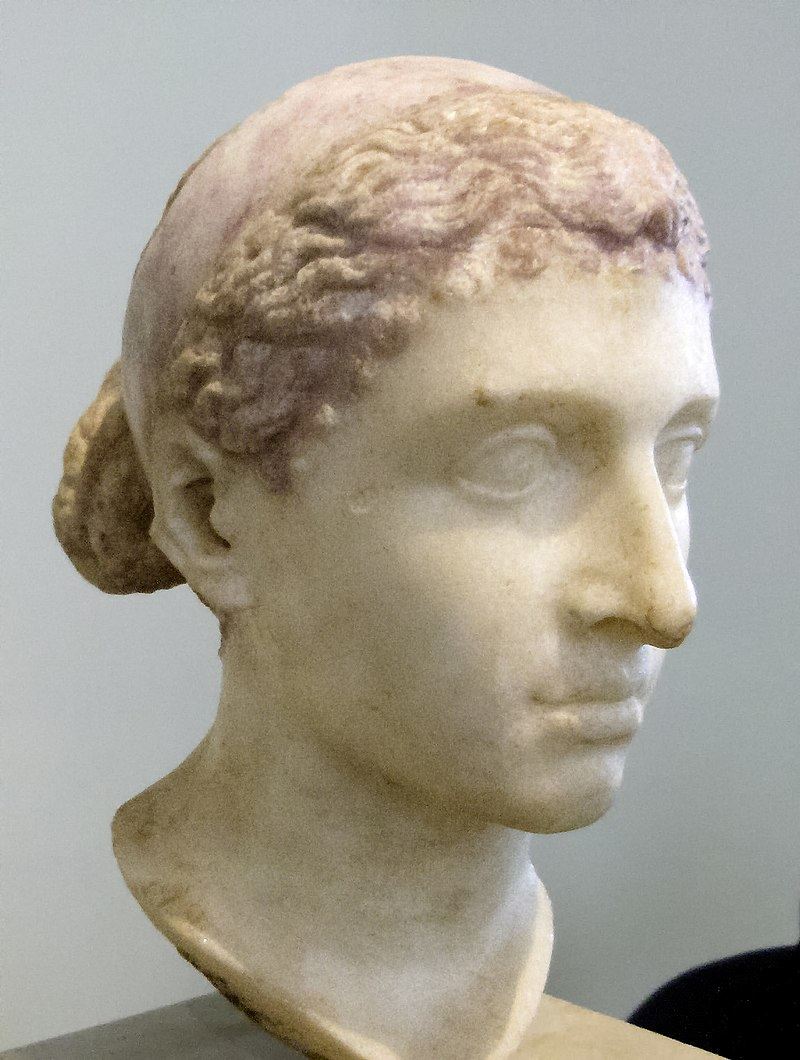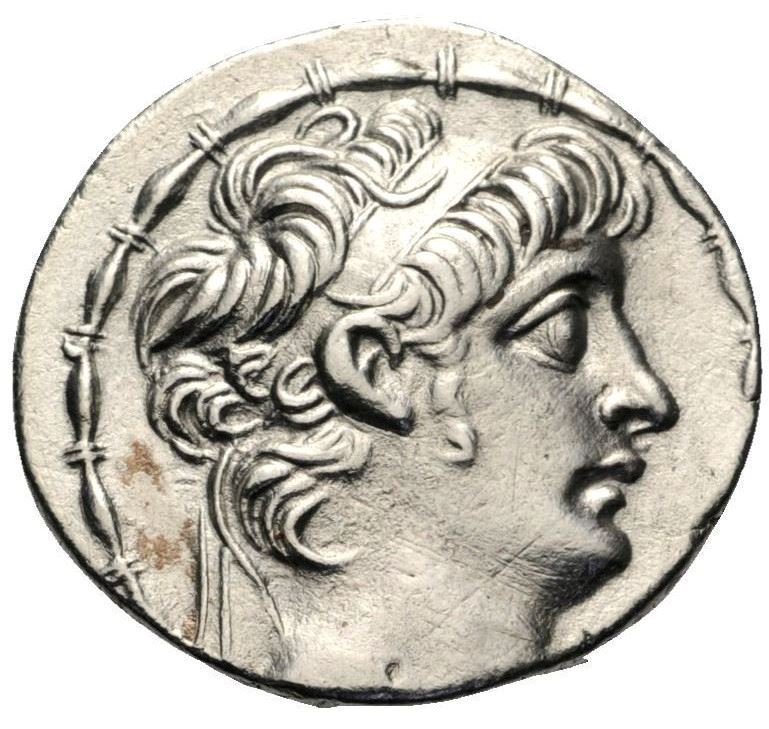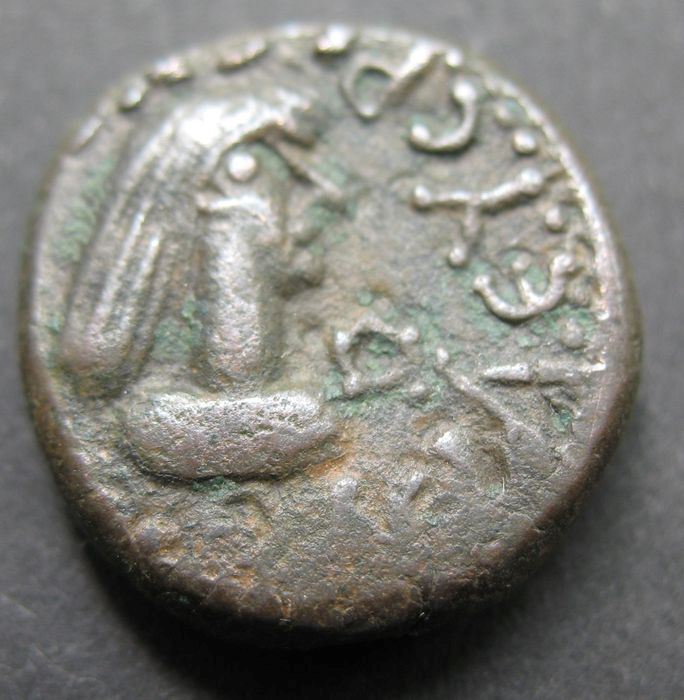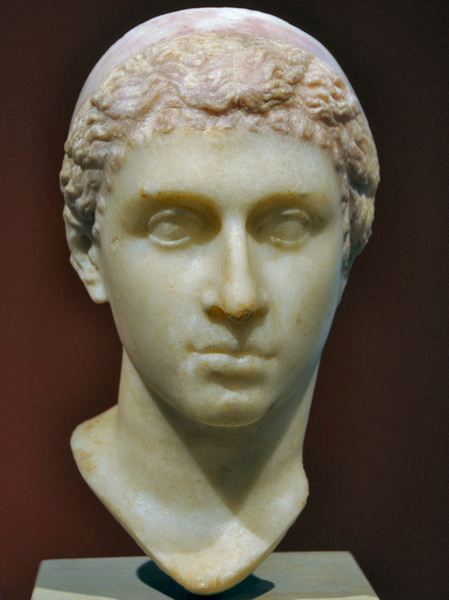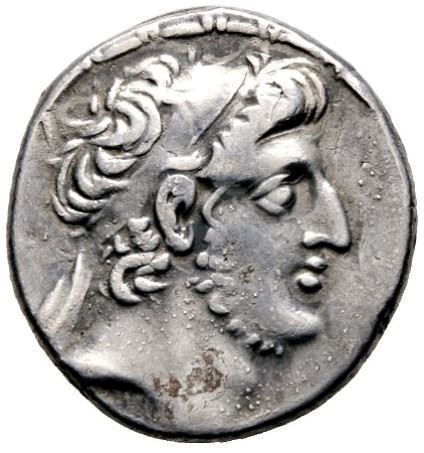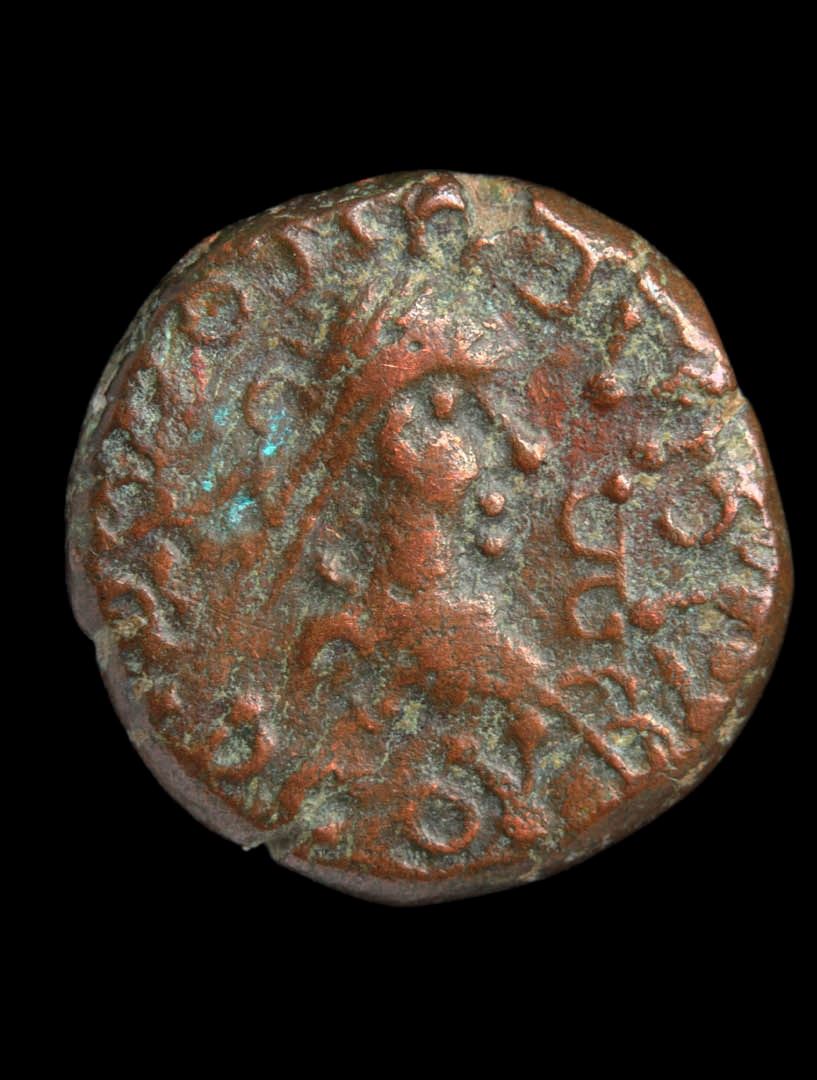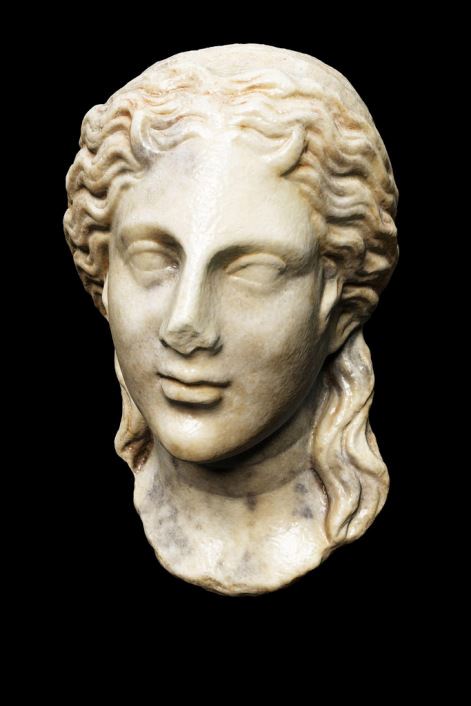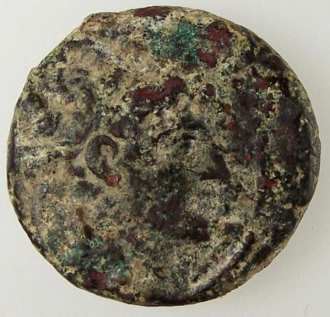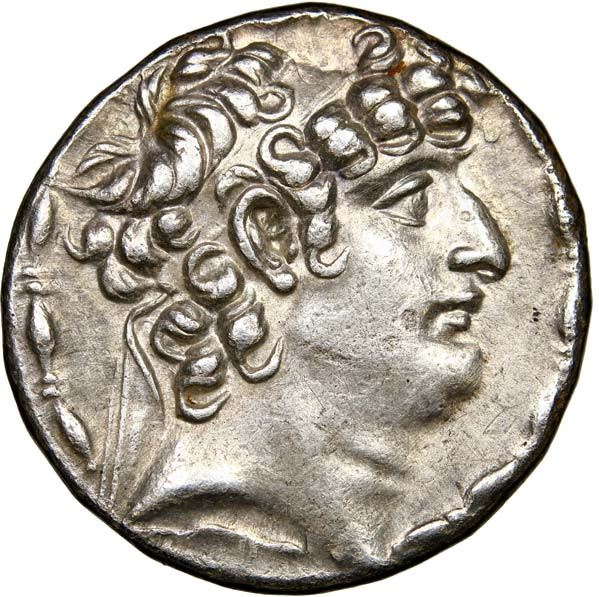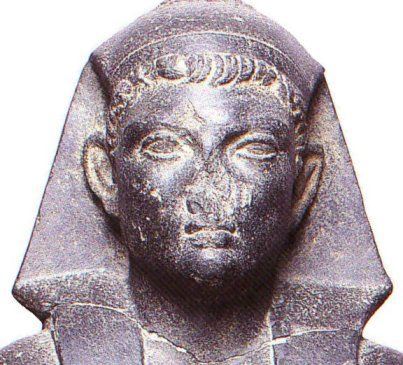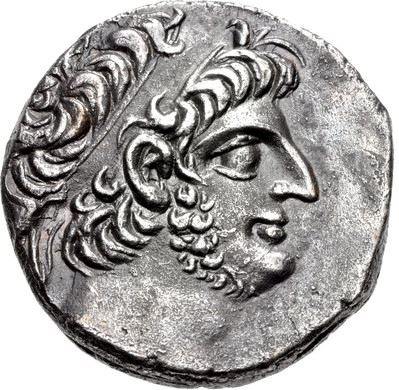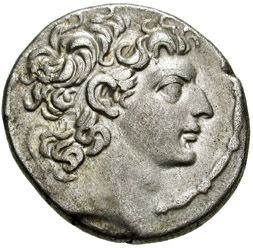The history of Ancient Greek coinage can be divided into four periods; the Archaic, the Classical, the Hellenistic and the Roman. The Archaic period extends from the introduction of coinage to the Greek world during the 7th century BC until the Persian Wars in about 480 BC. The Classical period then began, and lasted until the conquests of Alexander the Great in about 330 BC, which began the Hellenistic period, extending until the Roman absorption of the Greek world in the 1st century BC.
All Greek coins were handmade. The design for the obverse was carved into a block of bronze or iron called a die. The design of the reverse was carved into a similar punch. A blank metal disk was cast in a mold, placed between the die and the punch, and struck hard with a hammer, raising the design on both sides of the coin.
All Greek coins were handmade. The design for the obverse was carved into a block of bronze or iron called a die. The design of the reverse was carved into a similar punch. A blank metal disk was cast in a mold, placed between the die and the punch, and struck hard with a hammer, raising the design on both sides of the coin.
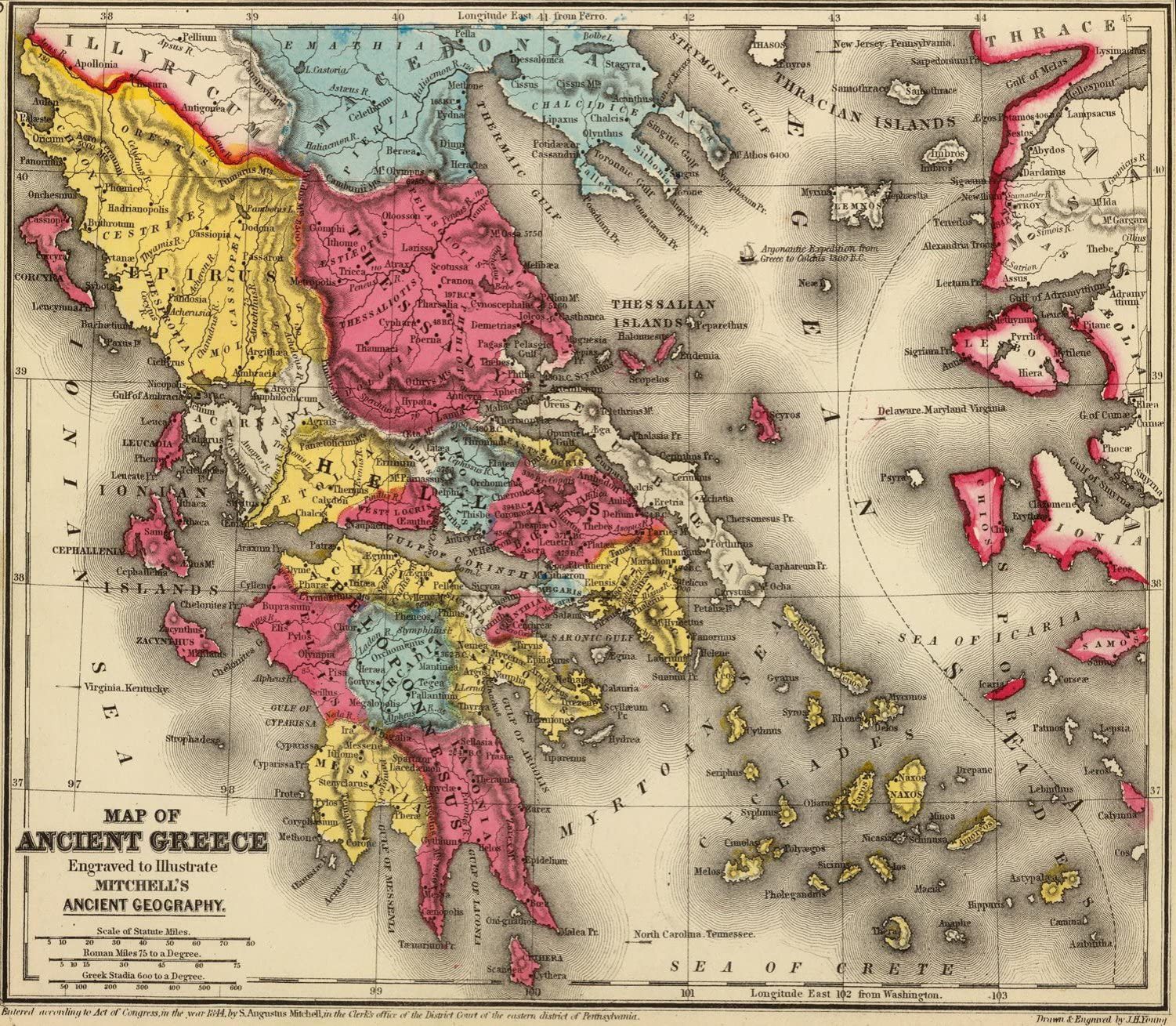
Gelon was a 5th-century BC ruler of Gela and Syracuse and first of the Deinomenid rulers.
Originally a priest, Gelon fought in a number of the conflicts on Sicily and earned a reputation as a formidable soldier - and became commander of the cavalry for Hippocrates, tyrant of Gela.
In 491 BC Gelon seized power in Gela with the help of the army - and in 485 BC he conquered Syr...
Originally a priest, Gelon fought in a number of the conflicts on Sicily and earned a reputation as a formidable soldier - and became commander of the cavalry for Hippocrates, tyrant of Gela.
In 491 BC Gelon seized power in Gela with the help of the army - and in 485 BC he conquered Syr...
Seleukos I was one of the Diadochi - 'successors' to Alexander III 'the Great'.
Having previously served as an infantry general under Alexander the Great, he eventually assumed the title of basileus and established the Seleucid Empire over much of the territory in the Near East which Alexander had conquered.
Seleucus founded a number of new cities during his reign, including ...
Having previously served as an infantry general under Alexander the Great, he eventually assumed the title of basileus and established the Seleucid Empire over much of the territory in the Near East which Alexander had conquered.
Seleucus founded a number of new cities during his reign, including ...
Alexander I was the ruler of the ancient Greek Kingdom of Macedon from c. 498 BC until his death in 454 BC.
Alexander I came to the throne during the era of the kingdom's vassalage at the hand of Achaemenid Persia, dating back to the time of his father, Amyntas I, although Macedon retained a broad scope of autonomy. He is, however, referred to as hyparchos by Herodotus, meaning subordi...
Alexander I came to the throne during the era of the kingdom's vassalage at the hand of Achaemenid Persia, dating back to the time of his father, Amyntas I, although Macedon retained a broad scope of autonomy. He is, however, referred to as hyparchos by Herodotus, meaning subordi...
Ptolemaios I - also known as Ptolemy of Lagus - was a Macedonian Greek general under Alexander the Great, one of the three Diadochi who succeeded to his empire.
Ptolemy became ruler of Egypt and founded a dynasty which ruled it for the next three centuries, turning Egypt into a Hellenistic kingdom and Alexandria into a center of Greek culture.
He assimilated some aspects of ...
Ptolemy became ruler of Egypt and founded a dynasty which ruled it for the next three centuries, turning Egypt into a Hellenistic kingdom and Alexandria into a center of Greek culture.
He assimilated some aspects of ...
Ariarathes I was the satrap of the Satrapy of Cappadocia under the Achaemenid Empire from 350 BC to 331 BC, and the King of Cappadocia from 331 BC until his death in 322 BC. He was the son of the Cappadocian satrap Ariamnes I.
Alexander the Great conquered Cappadocia during his route and installed a governor there, Ariarathes somehow assumed power as the first king of Cappadocians and e...
Alexander the Great conquered Cappadocia during his route and installed a governor there, Ariarathes somehow assumed power as the first king of Cappadocians and e...
The Achaean League was a Hellenistic-era confederation of Greek city states on the northern and central Peloponnese. The league was named after the region of Achaea in the northwestern Peloponnese, which formed its original core.
The first league was formed in the fifth century BC. The second Achaean League was established in 280 BC. As a rival of Antigonid Macedon and an ally of Rome, ...
The first league was formed in the fifth century BC. The second Achaean League was established in 280 BC. As a rival of Antigonid Macedon and an ally of Rome, ...
Artaxia I was the founder of the Artaxiad Dynasty whose members ruled the Kingdom of Armenia for nearly two centuries.
Artaxias was originally appointed strategos of Armenia by Seleucid King Antiochus the Great, but following his monarch's defeat by the Romans at the Battle of Magnesia in 190 BC, Artaxias and his co-strategos Zariadres revolted and, with Roman consent, began to reign au...
Artaxias was originally appointed strategos of Armenia by Seleucid King Antiochus the Great, but following his monarch's defeat by the Romans at the Battle of Magnesia in 190 BC, Artaxias and his co-strategos Zariadres revolted and, with Roman consent, began to reign au...
Rhoemetalces I was king of the Odrysian kingdom of Thrace from 12 BC to 12 AD, in succession to his nephew Rhescuporis I. He was a loyal ally to the first Roman Emperor Augustus.
Rhoemetalces I was a direct descendant of the Thracian King Cotys I, and the middle son of the earlier Thracian king Cotys IV. His younger brother was Rhescuporis II. When Cotys VII died about 48 BC Rhoemetalce...
Rhoemetalces I was a direct descendant of the Thracian King Cotys I, and the middle son of the earlier Thracian king Cotys IV. His younger brother was Rhescuporis II. When Cotys VII died about 48 BC Rhoemetalce...
Deiotarus of Galatia was a Chief Tetrarch of the Tolistobogii in western Galatia, Asia Minor, and a King of Galatia. He was considered one of the most adept of Celtic kings, ruling the three tribes of Celtic Galatia from his fortress in Blucium.
The name Deiotarus is generally translated as Galatian Celtic "Divine-bull"
Deiotarus was a faithful ally of the Romans and became...
The name Deiotarus is generally translated as Galatian Celtic "Divine-bull"
Deiotarus was a faithful ally of the Romans and became...
Ptolemaeus of Commagene was the last satrap and first king of Commagene. He was of Orontid Armenian descent, being related to the king of Sophene Arsames I. His father was King Orontes IV of Armenia, son of Arsames I.
Ptolemaeus started out as Governor - Satrap - of Commagene under the Seleucid rulers Antiochus III, Seleucus IV, Antiochus IV, and Antiochus V Eupator. But when the Seleuc...
Ptolemaeus started out as Governor - Satrap - of Commagene under the Seleucid rulers Antiochus III, Seleucus IV, Antiochus IV, and Antiochus V Eupator. But when the Seleuc...
Zipoetes I was the second independent ruler of Bithynia, and the first to style himself as King. He succeeded his father Bas on the throne in about 326 BC and reigned for forty-eight years, waging successful wars with Lysimachus and Antiochus, the son of Seleucus I Nicator.
He founded a city which was called Zipoetium (after himself) at the foot of Mount Lypedron; the exact locations of...
He founded a city which was called Zipoetium (after himself) at the foot of Mount Lypedron; the exact locations of...
Philetaerus was the founder of the Attalid dynasty of Pergamon in Anatolia. After the death of Alexander the Great in 323 BC, Philetaerus became embroiled in the struggle for supremacy, called the Wars of the Diadochi. He served first under Antigonus. He then shifted his allegiance to Lysimachus, who, after Antigonus was killed at the Battle of Ipsus in 301 BC, made Philetaerus commander of Pergam...
Mithradate I was a Persian nobleman and the founder of the Kingdom of Pontus in Anatolia. He is said to have been of the same age as Demetrios Poliorketes, which means he was born in the mid-330s BCE.
In 302 or 301 BC, shortly after having executed Mithradates' father, Antigonus Monophthalmus became suspicious of the son who had inherited the family dominion of Cius, and planned to ki...
In 302 or 301 BC, shortly after having executed Mithradates' father, Antigonus Monophthalmus became suspicious of the son who had inherited the family dominion of Cius, and planned to ki...
Pharnaces was the king of the Bosporan Kingdom from 63 BC and until his death in 47 BC. He was the son of Mithridates VI of Pontus, and was therefore referred to as Pharnaces of Pontus although he never actually ruled that Kingdom as it was annexe by Rome following the death of his father.
Pharnaces II was raised as his father's successor and treated with distinction. However, we know l...
Pharnaces II was raised as his father's successor and treated with distinction. However, we know l...
Pyrrhus or Pyrrhos was a Greek general and statesman of the Hellenistic period. He was king of the Greek tribe of Molossians, of the royal Aeacid house, and later he became king of Epirus.
Pyrrhus was one of the strongest opponents of early Rome. His battles, though victories, caused him unacceptably heavy losses, from which the term 'Pyrrhic victory' was coined.
While he was...
Pyrrhus was one of the strongest opponents of early Rome. His battles, though victories, caused him unacceptably heavy losses, from which the term 'Pyrrhic victory' was coined.
While he was...
The Boeotian League comprised eleven groups of sovereign cities and associated townships, each of which elected one Boeotarch and sixty delegates to the federal council at Thebes, and supplied a contingent of about 1000 infantry and 100 cavalry to the federal army.
All important questions of policy had to be submitted to the individual cities for ratification. Only citizens of property ...
All important questions of policy had to be submitted to the individual cities for ratification. Only citizens of property ...
Antiochus I 'Soter' was a king of the Hellenistic Seleucid Empire. He succeeded his father Seleucus I Nicator in 281 BC and reigned until his death in 261 BC.
Antiochus I was half Persian, his mother Apama, daughter of Spitamenes, being one of the eastern princesses whom Alexander the Great had given as wives to his generals in 324 BC.
In 294 BC, Antiochus married his stepmot...
Antiochus I was half Persian, his mother Apama, daughter of Spitamenes, being one of the eastern princesses whom Alexander the Great had given as wives to his generals in 324 BC.
In 294 BC, Antiochus married his stepmot...
Perdikkas II was a king of Macedonia from about 448 BC to about 413 BC. He was the son of Alexander I.
After the death of Alexander I in 454, Macedonia began to fall apart. Macedonian tribes became almost completely autonomous, and were only loosely allied to the king. Perdikkas consequently spent much of his reign fighting internal pretenders and their allies, most often Athens.
<...
After the death of Alexander I in 454, Macedonia began to fall apart. Macedonian tribes became almost completely autonomous, and were only loosely allied to the king. Perdikkas consequently spent much of his reign fighting internal pretenders and their allies, most often Athens.
<...
Berenike I was Queen of Egypt by marriage to Ptolemy I Soter. She became the second second queen, after Eurydice, of the Ptolemaic dynasty of Egypt.
Berenice was originally from Eordeaea, and the daughter of princess Antigone of Macedon. Her maternal grandfather was a nobleman called Cassander who was the brother of Antipater, the regent for Alexander's empire.
After the deat...
Berenice was originally from Eordeaea, and the daughter of princess Antigone of Macedon. Her maternal grandfather was a nobleman called Cassander who was the brother of Antipater, the regent for Alexander's empire.
After the deat...
Hieron I was the son of Deinomenes, the brother of Gelon, and tyrant of Syracuse in Sicily from 478 to 467 BC.
During his reign, he greatly increased the power of Syracuse. He removed the inhabitants of Naxos and Catana to Leontini, peopled Catana (which he renamed Aetna) with Dorians, concluded an alliance with Acragas (Agrigentum) and supported the cause of the Locrians against Anaxil...
During his reign, he greatly increased the power of Syracuse. He removed the inhabitants of Naxos and Catana to Leontini, peopled Catana (which he renamed Aetna) with Dorians, concluded an alliance with Acragas (Agrigentum) and supported the cause of the Locrians against Anaxil...
Ariarathas II was satrap and king of Cappadocia, but fled into Armenia after the death of his uncle and adopted father Ariarathes I, ruler of Cappadocia, who had refused to submit to Eumenes, the Governor appointed by Perdiccas following the death of Alexander the Great.
After the death of Eumenes he recovered Cappadocia with the assistance of Ardoates, the Armenian king, and killed Am...
After the death of Eumenes he recovered Cappadocia with the assistance of Ardoates, the Armenian king, and killed Am...
Artavasdes I reigned as King of Armenia from 159 BC to 123 BC and was the son of Artaxias I and Satenik.
Artavasdes repelled several attempts by Parthians to invade Armenia but was eventually defeated by Mithridates, who annexed parts of Eastern Armenia and took his son, Tigranes the Great as hostage.
Artavasdes I can be identified with the Armenian king who, according to the...
Artavasdes repelled several attempts by Parthians to invade Armenia but was eventually defeated by Mithridates, who annexed parts of Eastern Armenia and took his son, Tigranes the Great as hostage.
Artavasdes I can be identified with the Armenian king who, according to the...
Rhoemetalces II was a Client Ruler in association with his mother Antonia Tryphaena of the Odrysian kingdom of Thrace under the Romans from 18 to 38. On coinage his royal title is in Greek:ΒΑΣΙΛΕΥΣ ΡΟΙΜΗΤΑΛΚΑΣ or of King Rhoemetalces.
Rhoemetalces II and Tryphaena succeeded his paternal great-uncle Rhescuporis II, who had usurped the throne from Rhoemetalces II's father Cotys VIII. The ...
Rhoemetalces II and Tryphaena succeeded his paternal great-uncle Rhescuporis II, who had usurped the throne from Rhoemetalces II's father Cotys VIII. The ...
Sames II was the second king of Commagene. Of Armenian descent, he was the son and successor of Ptolemaeus of Commagene.
Sames reigned as king between 130–109 BC. During his reign, Sames ordered the construction of the fortress at Samosata which is now submerged by water from the Atatürk Dam.
Sames died in 109 BC. His wife was Pythodoris, daughter of the Kings of Pontus, and ...
Sames reigned as king between 130–109 BC. During his reign, Sames ordered the construction of the fortress at Samosata which is now submerged by water from the Atatürk Dam.
Sames died in 109 BC. His wife was Pythodoris, daughter of the Kings of Pontus, and ...
Tiberius Julius Aspurgus Philoromaios was a Prince and Roman client king of the Bosporan Kingdom. The name Aspurgus is of Iranian origin, derived from aspa (horse) and aspabara (horseman). Aspurgus was of Greek and Iranian ancestry.
Little is known of Aspurgus’ reign; however, he seemed to have been a strong and capable ruler. Due to previous dynastic conflicts during the Roman Republic...
Little is known of Aspurgus’ reign; however, he seemed to have been a strong and capable ruler. Due to previous dynastic conflicts during the Roman Republic...
Zipoetes II was a ruler of Bithynia from 278 BC to 276 BC. He was a son of Zipoetes I and a younger brother to Nicomedes I.
When Nicomedes tried to kill his three brothers, Zipoetes II was the only one to escape. He then raised an insurrection against Nicomedes and succeeded in maintaining himself, for some time, in the independent sovereignty of a considerable part of Bithynia.
When Nicomedes tried to kill his three brothers, Zipoetes II was the only one to escape. He then raised an insurrection against Nicomedes and succeeded in maintaining himself, for some time, in the independent sovereignty of a considerable part of Bithynia.
Brogitarius was king of Galatia between 63 BC and 50 BC, reigning concurrently with his father-in-law Deiotaros, who was also tetrarch of the Tolistobogii. By Deiotarus' daughter Adobogiona, Brogitarus was the father of Amyntas, tetrarch of the Trocmi and king of Galatia.
Cicero claims that Brogitarus obtained his elevation to the kingship of Galatia alongside Deiotarus by bribing P. Cl...
Cicero claims that Brogitarus obtained his elevation to the kingship of Galatia alongside Deiotarus by bribing P. Cl...
Eumenes I was dynast (ruler) of the city of Pergamon in Asia Minor from 263 BC until his death in 241 BC. He was the son of Eumenes, the brother of Philetaerus, the founder of the Attalid dynasty, and Satyra, daughter of Poseidonius. As he had no children, Philetaerus adopted Eumenes to become his heir.
Although nominally under Seleucid control, Pergamon under Philetaerus enjoyed consid...
Although nominally under Seleucid control, Pergamon under Philetaerus enjoyed consid...
Ariobarzanes was the second king of Pontus, succeeding his father Mithridates I Ctistes in 266 BC and died in an uncertain date between 258 and 240. He obtained possession of the city of Amastris in Paphlagonia, which was surrendered to him.
Ariobarzanes and his father sought the assistance of the Gauls, who had come into Asia Minor twelve years before the death of Mithridates, to expel...
Ariobarzanes and his father sought the assistance of the Gauls, who had come into Asia Minor twelve years before the death of Mithridates, to expel...
Dionysius was a Greek tyrant of Syracuse. He conquered several cities in Sicily and southern Italy, opposed Carthage's influence in Sicily and made Syracuse the most powerful of the Western Greek colonies. He was regarded by the ancients as an example of the worst kind of despot—cruel, suspicious and vindictive.
Dionysius began his working life as a clerk in a public office. Because of ...
Dionysius began his working life as a clerk in a public office. Because of ...
Ptolemaios II was the king of Ptolemaic Egypt from 283 to 246 BC. He was the son of the founder of the Ptolemaic kingdom Ptolemaios I Soter and Berenice, and was educated by Philitas of Cos. He had two half-brothers, Ptolemaios Keraunos and Meleager, who both became kings of Macedonia (in 281 BCE and 279 BCE respectively), and who both died in the Gallic invasion of 280–279 BCE. Ptolemaios was fir...
Archelaos I was a king of Macedon from 413 to 399 BC. He was a capable and beneficent ruler, known for the sweeping changes he made in state administration, the military, and commerce.
By the time that he died, Archelaus had succeeded in converting Macedon into a significantly stronger power. Thucydides credited Archelaus with doing more for his kingdom's military infrastructure than ...
By the time that he died, Archelaus had succeeded in converting Macedon into a significantly stronger power. Thucydides credited Archelaus with doing more for his kingdom's military infrastructure than ...
Antiochus II was a Greek king of the Hellenistic Seleucid Empire who reigned from 261 to 246 BC. He succeeded his father Antiochus I Soter in the winter of 262–61 BC. He was the younger son of Antiochus I and princess Stratonice, the daughter of Demetrius Poliorcetes.
He inherited a state of war with Ptolemaic Egypt, the "Second Syrian War", which was fought along the coasts of Asia Min...
He inherited a state of war with Ptolemaic Egypt, the "Second Syrian War", which was fought along the coasts of Asia Min...
Ariamnes II was a ruler and king of Cappadocia, who succeeded his father Ariarathes II. He is styled as the second of his name in our time, although his predecessor was a Satrap and not a king.
He was fond of his children, and shared his crown with his son Ariarathes III in his lifetime.
He was probably the first to obtain the independence of Cappadocia from the Seleucid Emp...
He was fond of his children, and shared his crown with his son Ariarathes III in his lifetime.
He was probably the first to obtain the independence of Cappadocia from the Seleucid Emp...
The Bretti or Brutti were an Italian tribe of Lucanian descent.
During the 2nd Punic War they allied themselves with Hannibal, and produced some interesting coinage. Following the defeat of Hannibal they were deprived of a great part of their territory, and the whole nation was reduced to a state bordering on servitude.
They were not admitted like the other nations of Ital...
During the 2nd Punic War they allied themselves with Hannibal, and produced some interesting coinage. Following the defeat of Hannibal they were deprived of a great part of their territory, and the whole nation was reduced to a state bordering on servitude.
They were not admitted like the other nations of Ital...
Tigranes reigned as King of Armenia from 115 BC to 95 BC. He ascended to the throne when his brother, Artavasdes I, died without an heir.
According to Appian, Tigranes II was not the son of Artavasdes, but of Tigranes I.
According to Appian, Tigranes II was not the son of Artavasdes, but of Tigranes I.
Rhoemetalces III was a King of the Thracians. He was the son of the Monarch Rhescuporis II. He in association with his cousin-wife Pythodoris II were client rulers of the Odrysian kingdom of Thrace under the Romans from AD 38 to 46, in succession to Pythodoris’ mother Tryphaena and her brother Rhoemetalces II.
Rhoemetalces III was murdered in 46, by insurgents or on the orders of his wi...
Rhoemetalces III was murdered in 46, by insurgents or on the orders of his wi...
Mithridates I was a king of Orontid Armenian descent who lived during the late 2nd century BC and early 1st century BC. Mithridates was a prince, the son, and successor of King of Commagene, Sames II Theosebes Dikaios.
Before his succession in 109 BC, he married the Syrian Greek Princess Laodice VII Thea as a part of a peace alliance. Mithridates embraced Greek culture. Laodice bore Mi...
Before his succession in 109 BC, he married the Syrian Greek Princess Laodice VII Thea as a part of a peace alliance. Mithridates embraced Greek culture. Laodice bore Mi...
Tiberius Julius Mithridates was a Roman Client King of the Bosporan Kingdom from 38 AD to 46 AD. He was the first son of Roman Client Monarchs Aspurgus and Gepaepyris. His younger brother was prince and future King Cotys I.
Little is known on the early life of Mithridates. When Aspurgus died in 38, Mithridates had become joint ruler with his mother, Gepaepyris. Sometime before 45, the R...
Little is known on the early life of Mithridates. When Aspurgus died in 38, Mithridates had become joint ruler with his mother, Gepaepyris. Sometime before 45, the R...
Nicomedes I was the eldest son of Zipoetes I, whom he succeeded on the throne in 278 BC. He commenced his reign by putting to death two of his brothers but the third, subsequently called Zipoetes II, raised an insurrection against him and succeeded in maintaining himself, for some time, in the independent sovereignty of a considerable part of Bithynia.
To defeat Zipoetes II, Nicomedes c...
To defeat Zipoetes II, Nicomedes c...
Castor was a king of Galatia, and the grandson of the first king of Galatia, Deiotaros.
Attalus I ruled Pergamon, an Ionian Greek polis, first as dynast, later as king, from 241 BC to 197 BC. He was the first cousin once removed and the adoptive son of Eumenes I, whom he succeeded, and was the first of the Attalid dynasty to assume the title of king in 238 BC.
Attalus won an important victory over the Galatians, newly arrived Celtic tribes from Thrace, who had been, for mo...
Attalus won an important victory over the Galatians, newly arrived Celtic tribes from Thrace, who had been, for mo...
Mithradates II was the third king of Pontus and son of Ariobarzanes, whom he succeeded on the throne. He was a minor when his father died, but the date of his accession cannot be determined. It seems probable that it must have taken place well before 240 BC, as Memnon tells us that he was a child at his father's death, and he had a daughter of marriageable age in 222 BC.
After Mithrada...
After Mithrada...
Amyntas was a King of Galatia and of several adjacent countries between 36 BC and 25 BC.
Amyntas seems to have first possessed Lycaonia, and to this he added the territory of Derbe by the murder of its prince, Antipater of Derbe, the friend of Cicero, as well as Isaura and Cappadocia by Roman favour.
Towards the end of his life, Amyntas conquered Hoinona and killed the ruler ...
Amyntas seems to have first possessed Lycaonia, and to this he added the territory of Derbe by the murder of its prince, Antipater of Derbe, the friend of Cicero, as well as Isaura and Cappadocia by Roman favour.
Towards the end of his life, Amyntas conquered Hoinona and killed the ruler ...
The Epirote League was an ancient Greek coalition, or koinon, of Epirote tribes. The coalition was established between 370 and 320 BC, which helped unify the three main tribes of Epirus. The political, economic, and cultural center of the Epirote League was the oracle of Dodona.
In 297 BC, Pyrrhus of Epirus became leader of the League. He would go on to his famous struggle against the ...
In 297 BC, Pyrrhus of Epirus became leader of the League. He would go on to his famous struggle against the ...
Arsinoe I was Queen of Egypt by marriage to Ptolemy II Philadelphus. She was the second daughter and youngest child born to King Lysimachus and Nicaea of Macedon.
She bore Ptolemy II three children; Ptolemy III, Lysimachus of Egypt and a daughter called Berenice. At an unknown date after 279, a sister of Ptolemy II called Arsinoe II arrived in Egypt. She was the last wife of Lysimachus ...
She bore Ptolemy II three children; Ptolemy III, Lysimachus of Egypt and a daughter called Berenice. At an unknown date after 279, a sister of Ptolemy II called Arsinoe II arrived in Egypt. She was the last wife of Lysimachus ...
Aeropos II was king of Macedon for nearly 5 years - the first 4 as a guardian for Orestes, and the last alone.
He was succeeded by Archelaos II.
He was succeeded by Archelaos II.
Dionysios II was a Greek politician who ruled Syracuse, Sicily from 367 BC to 357 BC and again from 346 BC to 344 BC.
When his father died in 367 BC, Dionysius, who was under thirty years old and completely inexperienced in public affairs, inherited the supreme power and began ruling under the supervision of his uncle, Dion, whose disapproval of the young Dionysius's lavishly dissolute ...
When his father died in 367 BC, Dionysius, who was under thirty years old and completely inexperienced in public affairs, inherited the supreme power and began ruling under the supervision of his uncle, Dion, whose disapproval of the young Dionysius's lavishly dissolute ...
Seleucus II was a ruler of the Hellenistic Seleucid Empire, who reigned from 246 to 225 BC.
After the death of his father, Antiochus, he was proclaimed king by his mother, Laodice in Ephesos, while her partisans at Antioch murdered Berenice and her son, another Antiochus. This dynastic feud began the Third Syrian War. Ptolemy III, who was Berenice's brother and the ruler of Egypt, invad...
After the death of his father, Antiochus, he was proclaimed king by his mother, Laodice in Ephesos, while her partisans at Antioch murdered Berenice and her son, another Antiochus. This dynastic feud began the Third Syrian War. Ptolemy III, who was Berenice's brother and the ruler of Egypt, invad...
Ariarathes III son of Ariamnes, ruler of Cappadocia, and grandson of Ariarathes II was King of Cappadocia from 255-220 BC, in the beginning as co-ruler with his father Ariamnes II, later as sole rulers. He married Stratonice, a daughter of the Seleucid ruler Antiochus II.
About 250 BC he was the first ruler of Cappadocia to proclaim himself king (basileus). It is known that he sided wit...
About 250 BC he was the first ruler of Cappadocia to proclaim himself king (basileus). It is known that he sided wit...
Tigranes II - usually known as 'the Great' - was King of Armenia under whom the country became, for a short time, the strongest state to Rome's east. He was a member of the Artaxiad Royal House.
Under his reign, the Armenian kingdom expanded beyond its traditional boundaries, allowing Tigranes to claim the title Great King, and involving Armenia in many battles against opponents such as...
Under his reign, the Armenian kingdom expanded beyond its traditional boundaries, allowing Tigranes to claim the title Great King, and involving Armenia in many battles against opponents such as...
Antiochos I was the most famous king of Commagene. He was the son and probably the only child of King Mithridates I Callinicus and Queen Laodice VII Thea of Commagene. Antiochus was half Armenian, a distant member of the Orontid Dynasty and half Greek.
While the Roman Republic was annexing territories in Anatolia, Antiochos, through skilled diplomacy, was able to keep Commagene indepen...
While the Roman Republic was annexing territories in Anatolia, Antiochos, through skilled diplomacy, was able to keep Commagene indepen...
Tiberius Julius Cotys was king of the Bosporan Kingdom from 46 AD to 63 AD. He was the second son of Roman client rulers Aspurgus and Gepaepyris.
Little is known on the life of Cotys I. When Aspurgus died in 38, his brother became joint ruler with his mother. Sometime before 45, the Roman Emperor Claudius gave his brother the whole Bosporan Kingdom to rule. Claudius recognised and appoi...
Little is known on the life of Cotys I. When Aspurgus died in 38, his brother became joint ruler with his mother. Sometime before 45, the Roman Emperor Claudius gave his brother the whole Bosporan Kingdom to rule. Claudius recognised and appoi...
Ziaelas was the third king of Bithyniaand a son of Nicomedes I and Ditizele. After Nicomedes I died, his second wife Etazeta of Bithynia became ruler on behalf of her infant sons. The grown-up Ziaelas, excluded from the throne, had previously fled to Armenia and taken refuge at the court of King Arsames I in Sophene.
On his father's death he immediately endeavoured to regain his rights ...
On his father's death he immediately endeavoured to regain his rights ...
Eumenes II was a ruler of Pergamon, and a son of Attalus I Soter and queen Apollonis and a member of the Attalid dynasty of Pergamon. He followed in his father's footsteps upon becoming king and collaborated with the Romans to oppose first Macedonian, then Seleucid expansion towards the Aegean, leading to the defeat of Antiochus the Great at the Battle of Magnesia in 190 BC.
Following t...
Following t...
Mithradates III was the fourth King of Pontus, son of Mithridates II of Pontus and Laodice. Mithridates had two sisters: Laodice III, the first wife of the Seleucid King Antiochus III the Great, and Laodice of Pontus. He may have ruled in an uncertain period between 220 BC and 183 BC. Nothing is known of him since the years just cited, because the kingdom of Pontus disappears from history.
John Hyrcanus was a Hasmonean - or Maccabeean - leader and Jewish high priest from 134 BC until his death in 104 BC). In rabbinic literature he is often referred to as Yoḥanan Cohen Gadol (יוחנן כהן גדול), "John the High Priest".
Antigonus I Monophthalmus, the son of Philip from Elimeia, was a Macedonian nobleman, general, and satrap under Alexander the Great.
During his early life he served under Philip II, and he was a major figure in the Wars of the Diadochi after Alexander's death, declaring himself king in 306 BC and establishing the Antigonid dynasty.
During his early life he served under Philip II, and he was a major figure in the Wars of the Diadochi after Alexander's death, declaring himself king in 306 BC and establishing the Antigonid dynasty.
Arsinoe II was a Ptolemaic Queen and co-regent of Ancient Egypt. She was Queen of Thrace, Asia Minor and Macedonia by marriage to King Lysimachus, and queen and co-ruler of Egypt with her brother-husband Ptolemy II Philadelphus.
In Egypt, she is believed to have instigated the accusation and exile of her brother Ptolemy II's first wife, Arsinoë I. Arsinoë II then married her brother. As...
In Egypt, she is believed to have instigated the accusation and exile of her brother Ptolemy II's first wife, Arsinoë I. Arsinoë II then married her brother. As...
Amyntas II was son of Philip or Menelaus, the brothers of Perdiccas II.
He ruled for one year, between 395 BC and 394 BC.
He ruled for one year, between 395 BC and 394 BC.
Timoleon was a Greek statesman and general, who hailed from Corinth.
Because of the political problems facing Syracuse and the threat from Sparta, a group of Syracusans sent an appeal for help to Corinth which reached the city state in 344 BC. Timoleon was chosen by a unanimous vote to undertake the mission, and set sail for Sicily with seven ships, a few of the leading citizens of Cor...
Because of the political problems facing Syracuse and the threat from Sparta, a group of Syracusans sent an appeal for help to Corinth which reached the city state in 344 BC. Timoleon was chosen by a unanimous vote to undertake the mission, and set sail for Sicily with seven ships, a few of the leading citizens of Cor...
Seleucus III was a ruler of the Hellenistic Seleucid Kingdom, the eldest son of Seleucus II Callinicus and Laodice II.
His birth name was Alexander and he was named after his great uncle the Seleucid official Alexander. He changed his name to Seleucus after he succeeded his father as King.
After a brief reign of three years (225–223 BC), Seleucus was assassinated in Anatoli...
His birth name was Alexander and he was named after his great uncle the Seleucid official Alexander. He changed his name to Seleucus after he succeeded his father as King.
After a brief reign of three years (225–223 BC), Seleucus was assassinated in Anatoli...
Ariarathes IV was the king of Cappadocia in 220–163 BC. He was the son of Ariarathes III and his Greek Macedonian wife Stratonice.
He was a child at his accession, and reigned for about 57 years. He married Antiochis, the daughter of Antiochus III, and, in consequence of this alliance assisted Antiochus in his war against the Romans. After the defeat of Antiochus by the Romans in 190 ...
He was a child at his accession, and reigned for about 57 years. He married Antiochis, the daughter of Antiochus III, and, in consequence of this alliance assisted Antiochus in his war against the Romans. After the defeat of Antiochus by the Romans in 190 ...
The Thessalian League was a loose confederacy of feudal-like city-states and tribes in the Thessalian plain in Northern Greece. The seat of the Thessalian diet was Larissa.
At the end of Second Macedonian War in 196, Rome established Thessaly as a koinon, Federal League, and cultivated its development to make it part of hegemonic powers of central and northern Greece. Under Roman contro...
At the end of Second Macedonian War in 196, Rome established Thessaly as a koinon, Federal League, and cultivated its development to make it part of hegemonic powers of central and northern Greece. Under Roman contro...
Tigranes the Younger was a son of Tigranes II "the Great" who struck an alliance with the Romans to usurp his father.
However, after Pompey the Great defeated his father the two struck a struck a deal and Tigranes the Younger was returned to Rome a prisoner.
However, after Pompey the Great defeated his father the two struck a struck a deal and Tigranes the Younger was returned to Rome a prisoner.
Mithridates II was king of Commagene from 38 BC and until his death in 20 BC. He wasone of the sons of King Antiochus I Theos of Commagene and Queen Isias Philostorgos of Commagene.
According to Plutarch, he was an ally of the Roman triumvir Mark Antony. In 31 BC, Mithridates personally led his forces to Actium in Greece in support of Antony in the war against Caesar Octavian, the futur...
According to Plutarch, he was an ally of the Roman triumvir Mark Antony. In 31 BC, Mithridates personally led his forces to Actium in Greece in support of Antony in the war against Caesar Octavian, the futur...
Tiberius Julius Rhescuporis was a prince and Roman Client King of the Bosporan Kingdom from 68 AD to 90 AD. He was the son and heir of the Roman Client King Cotys I and Roman Client Queen Eunice. He was of Greek, Iranian and Roman ancestry
Little is known of the life of Rhescuporis I. In 63 for unknown reasons, the Roman Emperor Nero disposed Cotys I, and his fate afterwards is unknown....
Little is known of the life of Rhescuporis I. In 63 for unknown reasons, the Roman Emperor Nero disposed Cotys I, and his fate afterwards is unknown....
Prusias I was a king of Bithynia, the son of Ziaelas of Bithynia. He was a vigorous and energetic leader; he fought a war against Byzantium (220 BC), seizing its Asiatic territory, a part of Mysia that had been in its possession for a long time.
He expanded the territories of Bithynia in a series of wars against Attalus I of Pergamum and Heraclea Pontica on the Black Sea, taking various...
He expanded the territories of Bithynia in a series of wars against Attalus I of Pergamum and Heraclea Pontica on the Black Sea, taking various...
Attalus II was a King of Pergamon and the founder of modern-day Turkish city Antalya. He was the second son of Attalus I Soter and queen Apollonis of Cyzicus, and ascended the throne first as co-ruler alongside his ailing brother Eumenes II in 160 BC, whose widow Stratonice of Pergamon he married in 158 BC upon Eumenes' death.
Attalus expanded his kingdom with the help of his good frien...
Attalus expanded his kingdom with the help of his good frien...
Pharnaces I was the fifth king of Pontus, and the son of King Mithradates III and his wife Laodice, whom he succeeded on the throne. He ruled c. 190 BC – c. 155 BC, but the precise year of his ascension is not known.
In 183 BC he attacked Sinope, after which the Rhodians sent an ambassador to Rome with a complaint but nothing came of it. Soon after he attacked Eumenes II of Pergamon and...
In 183 BC he attacked Sinope, after which the Rhodians sent an ambassador to Rome with a complaint but nothing came of it. Soon after he attacked Eumenes II of Pergamon and...
Judah Aristobulus I reigned c. 104 – 103 BC, and was the first ruler of the Hasmonean Dynasty to declare himself "king". He was the eldest of the five sons of John Hyrcanus, the previous leader.
Aristobulus was not only just the first king from the Hasmonean lineage, but the first of any Hebrew kings to claim both the high priesthood and the kingship title.
The Sadducees and...
Aristobulus was not only just the first king from the Hasmonean lineage, but the first of any Hebrew kings to claim both the high priesthood and the kingship title.
The Sadducees and...
Lysimachos was a Macedonian officer and diadochus (i.e. "successor") of Alexander the Great, who became a basileus in 306 BC, ruling Thrace, Asia Minor and Macedon.
During Alexander's Persian campaigns, in 328 BC he was one of his immediate bodyguards. After Alexander’s death in 323 BC, he was appointed to the government of Thrace as strategos.
In 306/305 BC, Lysimachus follo...
During Alexander's Persian campaigns, in 328 BC he was one of his immediate bodyguards. After Alexander’s death in 323 BC, he was appointed to the government of Thrace as strategos.
In 306/305 BC, Lysimachus follo...
Ptolemaios III was the third king of the Ptolemaic dynasty in Egypt.
He was the eldest son of Ptolemy II Philadelphus and his first wife, Arsinoe I, and came to power in 246 BC upon the death of his father. He married Berenice of Cyrene in the year corresponding to 244/243 BC.
He was responsible for the first known example of a series of decrees published as bilingual inscrip...
He was the eldest son of Ptolemy II Philadelphus and his first wife, Arsinoe I, and came to power in 246 BC upon the death of his father. He married Berenice of Cyrene in the year corresponding to 244/243 BC.
He was responsible for the first known example of a series of decrees published as bilingual inscrip...
Amyntas III was king of the ancient Greek kingdom of Macedon in 393 BC, and again from 392 to 370 BC. He was the son of Arrhidaeus and grandson of Amyntas, one of the sons of Alexander I.
He came to the throne after the ten years of confusion which followed the death of Archelaus I. But he had many enemies at home; in 393 he was driven out by the Illyrians, but in the following year, wi...
He came to the throne after the ten years of confusion which followed the death of Archelaus I. But he had many enemies at home; in 393 he was driven out by the Illyrians, but in the following year, wi...
Agathocles was a Greek tyrant of Syracuse (317–289 BC) and king of Sicily (304–289 BC).
The son of a potter, he learned his father's trade, but afterwards entered the army along with his brother Antander. He was twice banished for attempting to overthrow the oligarchical party in Syracuse.
In 317 BC he returned with an army of mercenaries under a solemn oath to observe the de...
The son of a potter, he learned his father's trade, but afterwards entered the army along with his brother Antander. He was twice banished for attempting to overthrow the oligarchical party in Syracuse.
In 317 BC he returned with an army of mercenaries under a solemn oath to observe the de...
Antiochus III was a Hellenistic Greek king and the 6th ruler of the Seleucid Empire.
Rising to the throne at the age of eighteen in 222 BC, his early campaigns against the Ptolemaic Kingdom were unsuccessful, but in the following years Antiochus gained several military victories and substantially expanded the empire's territory. His traditional designation, the Great, reflects an epithe...
Rising to the throne at the age of eighteen in 222 BC, his early campaigns against the Ptolemaic Kingdom were unsuccessful, but in the following years Antiochus gained several military victories and substantially expanded the empire's territory. His traditional designation, the Great, reflects an epithe...
Ariarathes V as a son of the preceding king Ariarathes IV of Cappadocia and queen Antiochis. He was distinguished by his contemporaries for his excellence of his character and his cultivation of philosophy and the liberal arts and is considered by some historians to have been the greatest of the kings of Cappadocia. He was a strong philhellene; he was honoured with Athenian citizenship. He refound...
Alexander Jannaeus was the second Hasmonean king of Judaea from 103 to 76 BC. A son of John Hyrcanus, he inherited the throne from his brother Aristobulus I, and married his brother's widow, Queen Salome Alexandra. From his conquests to expand the kingdom to a bloody civil war, Alexander's reign has been generalized as cruel and oppressive with never ending conflict.
The coinage of Alex...
The coinage of Alex...
The Phokian Confederation was a military alliance between ~22 small city states in the mountainous region of Phocis.
Due to the strategic location of Phokis - it controls the passage from Boeotia to Lokris and Thermopylai - the confederation was repeatedly under pressure from Boeotia, Thessaly and the Delphic Amphiktyony.
In 346 BC the Confederation was defeated in the so-cal...
Due to the strategic location of Phokis - it controls the passage from Boeotia to Lokris and Thermopylai - the confederation was repeatedly under pressure from Boeotia, Thessaly and the Delphic Amphiktyony.
In 346 BC the Confederation was defeated in the so-cal...
Artavasdes II was a King of the Kingdom of Armenia from 54 BC until 34 BC and a member of the Artaxiad Dynasty. He succeeded his father, Tigranes the Great, also known as Tigranes II.
Artavasdes II was an ally of Rome, but when Orodes II of Parthia invaded Armenia following his victory over the Roman general Marcus Licinius Crassus at the Battle of Carrhae in 53 BC, he was forced to joi...
Artavasdes II was an ally of Rome, but when Orodes II of Parthia invaded Armenia following his victory over the Roman general Marcus Licinius Crassus at the Battle of Carrhae in 53 BC, he was forced to joi...
Prusias II was the Greek king of Bithynia. He was the son and successor of Prusias I and Apama III. He became king when his father died in 189 BC. Prusias II joined with the king of Pergamon, Eumenes II in a war against King Pharnaces I of Pontus (181–179 BC). He later invaded the territories of Pergamon (156–154 BC), only to be defeated, with Pergamon insisting on heavy reparations, including 500...
Mithridates III was king of Commagene from 20 BC and until his death in 12 BC. He was the son and successor of King Mithridates II of Commagene and Queen Laodice. He was of Armenian and Greek descent.
Very little is known on his life and his reign. When he died in 12 BC, Antiochus III of Commagene became King.
Very little is known on his life and his reign. When he died in 12 BC, Antiochus III of Commagene became King.
Sauromates I was a prince and Roman client king of the Bosporan Kingdom. He was the son and heir of the Bosporan King Rhescuporis I by an unnamed wife, and was of Greek, Iranian and Roman ancestry.
Sauromates I continued his father’s legacy of rebuilding the Bosporan Kingdom. In 68, Rhescuporis I had restored the Bosporan Kingdom, previously a part of the Roman province of Moesia Inferi...
Sauromates I continued his father’s legacy of rebuilding the Bosporan Kingdom. In 68, Rhescuporis I had restored the Bosporan Kingdom, previously a part of the Roman province of Moesia Inferi...
Attalus III was the last Attalid king of Pergamon, ruling from 138 BC to 133 BC. He was the son of king Eumenes II and his queen Stratonice of Pergamon, and was the nephew of Attalus II, whom he succeeded.
According to Livy, Attalus III had little interest in ruling Pergamon, devoting his time to studying medicine, botany, gardening, and other pursuits. He had no male children or heirs ...
According to Livy, Attalus III had little interest in ruling Pergamon, devoting his time to studying medicine, botany, gardening, and other pursuits. He had no male children or heirs ...
Mithradates IV was a prince and sixth ruler of the Kingdom of Pontus. He is first mentioned in 179 BC in a treaty concluded by Pharnaces I with Eumenes II of Pergamon, in a manner which suggests that he shared some sovereign power.
The date of his accession to the Pontian throne is unknown, but he is recorded as the ruler of Pontus in 154 BC, when he is mentioned as sending an auxiliary...
The date of his accession to the Pontian throne is unknown, but he is recorded as the ruler of Pontus in 154 BC, when he is mentioned as sending an auxiliary...
Berenike II was a ruling queen of Cyrene by birth, and a queen and co-regent of Egypt by marriage to her cousin Ptolemy III Euergetes, the third ruler of the Ptolemaic dynasty of Egypt.
In approximately 249 BC, her father died, making Berenice ruling queen of Cyrene. Soon after her father died, Berenice was married to Demetrius the Fair, a Macedonian prince.
After Demetrius c...
In approximately 249 BC, her father died, making Berenice ruling queen of Cyrene. Soon after her father died, Berenice was married to Demetrius the Fair, a Macedonian prince.
After Demetrius c...
Perdiccas III was king of the ancient kingdom of Macedonia from 368 BC to 359 BC, succeeding his brother Alexander II.
As the son of Amyntas III and Eurydice, he was a child when Alexander II was killed by Ptolemy of Aloros, who then ruled as regent. In 365 BC, Perdiccas killed Ptolemy and assumed government.
There is very little information about the reign of Perdiccas III. ...
As the son of Amyntas III and Eurydice, he was a child when Alexander II was killed by Ptolemy of Aloros, who then ruled as regent. In 365 BC, Perdiccas killed Ptolemy and assumed government.
There is very little information about the reign of Perdiccas III. ...
Hicetas was tyrant of Syracuse, during the interval between the reign of Agathocles and that of Pyrrhus.
We are told by Diodorus that he ruled nine years. The only events of his government that are recorded are a war with Phintias, tyrant of Agrigentum (modern Agrigento), in which he obtained a considerable victory, and one with the Carthaginians, by whom he was defeated at the river Te...
We are told by Diodorus that he ruled nine years. The only events of his government that are recorded are a war with Phintias, tyrant of Agrigentum (modern Agrigento), in which he obtained a considerable victory, and one with the Carthaginians, by whom he was defeated at the river Te...
Seleucus IV was king of the Hellenistic Seleucid Empire from 187 BC to 175 BC.
He was the second son and successor of Antiochus III the Great and Laodice III. Seleucus IV married his sister Laodice IV, by whom he had three children: two sons Antiochus, Demetrius I Soter and a daughter Laodice V.
He was compelled by financial necessities, created in part by the heavy war-inde...
He was the second son and successor of Antiochus III the Great and Laodice III. Seleucus IV married his sister Laodice IV, by whom he had three children: two sons Antiochus, Demetrius I Soter and a daughter Laodice V.
He was compelled by financial necessities, created in part by the heavy war-inde...
Ariarathes VI , was the youngest son of Ariarathes V of Cappadocia and Nysa of Cappadocia, and reigned around 14 years as the King of Cappadocia.
e was a child at his succession, and for this reason the power was kept by his mother, who acted as his regent. At some point his mother seems to have poisoned all of Ariarathes’ five brothers; but the infant king was saved by people loyal to ...
e was a child at his succession, and for this reason the power was kept by his mother, who acted as his regent. At some point his mother seems to have poisoned all of Ariarathes’ five brothers; but the infant king was saved by people loyal to ...
Evagoras was the king of Salamis (411–374 BC) in Cyprus, known especially from the work of Isocrates, who presents him as a model ruler.
He claimed descent from Teucer, the son of Telamon and half-brother of Ajax, and his family had long been rulers of Salamis, although during his childhood Salamis came under Phoenician control, which resulted in his exile. While in Cilicia, Evagoras ga...
He claimed descent from Teucer, the son of Telamon and half-brother of Ajax, and his family had long been rulers of Salamis, although during his childhood Salamis came under Phoenician control, which resulted in his exile. While in Cilicia, Evagoras ga...
John Hyrcanus II was for a long time the Jewish High Priest in the 1st century BCE. He was also briefly King of Judea 67–66 BCE and then the ethnarch (ruler) of Judea probably 47–40 BCE.
Hyrcanus was the eldest son of Alexander Jannaeus, King and High Priest, and Alexandra Salome. After the death of Alexander in 76 BC, his widow succeeded to the rule of Judea and installed her elder son...
Hyrcanus was the eldest son of Alexander Jannaeus, King and High Priest, and Alexandra Salome. After the death of Alexander in 76 BC, his widow succeeded to the rule of Judea and installed her elder son...
Artaxias II was a Prince of the Kingdom of Armenia and member of the Artaxiad Dynasty who served as a Roman Client King of Armenia from 33 BC until 20 BC.
After ascending to the Armenian throne and regaining the country, with the support of Phraates IV, Artaxias II was successful in a military campaign against Artavasdes I of Media Atropatene, a former enemy of Artavasdes II. From this ...
After ascending to the Armenian throne and regaining the country, with the support of Phraates IV, Artaxias II was successful in a military campaign against Artavasdes I of Media Atropatene, a former enemy of Artavasdes II. From this ...
Antiochos III was king of Commagene from 12 BC to 17 AD. He was the son and successor of King Mithridates III of Commagene and Iotapa, and of mixed Armenian, Greek and Median descent--the last through his mother. His parents were first cousins.
Very little is known on his life and his reign as King. When Antiochus died in 17 AD, his death created major issues for the kingdom, which was ...
Very little is known on his life and his reign as King. When Antiochus died in 17 AD, his death created major issues for the kingdom, which was ...
Tiberius Julius Cotys II was a prince and Roman Client King of the Bosporan Kingdom. He was the son and heir of Sauromates I by an unnamed wife and was of Greek, Iranian and Roman ancestry. He was named in honor of his paternal great grandfather.
He reigned until his death in 132 and little is known on his reign. During his reign, the city of Chersonesus Taurica was under his direct con...
He reigned until his death in 132 and little is known on his reign. During his reign, the city of Chersonesus Taurica was under his direct con...
Nicomedes II was the king of Bithynia from 149 to c. 127 BC. He was the son and successor of Prusias II and Apame IV. He was so popular with the people that his father sent him to Rome to limit his influence. However, in Rome, he also gained favor from the Roman Senate, forcing Prusias to send an emissary named Menas with secret orders to assassinate him. But the emissary revealed the plot, and pe...
Eumenes III was a pretender to the throne of Pergamon. He led a revolt against the Pergamene regime and found success early on, seizing various cities near the coast of Anatolia, including the island of Samos, and killing the Roman consul Publius Licinius Crassus Dives Mucianus.
Eumenes’ revolt was met with staunch opposition, coming not only from the Romans but also from the surroundin...
Eumenes’ revolt was met with staunch opposition, coming not only from the Romans but also from the surroundin...
Mithradates V was the 7th king of Pontus, ruling from ~150 BC to ~120 BC. He was the son of the King Pharnaces I and Queen Nysa. His mother is believed to have died during childbirth, while giving birth to either him or his sister.
Mithradates V continued the alliance with the Roman Republic started by his predecessors. He supported them with some ships and a small auxiliary force durin...
Mithradates V continued the alliance with the Roman Republic started by his predecessors. He supported them with some ships and a small auxiliary force durin...
Salome Alexandra or Alexandra of Jerusalem, 141–67 BCE. The wife of Aristobulus I, and afterward of Alexander Jannaeus, she was the last queen of Judea, and the last ruler of ancient Judea to die as the ruler of an independent kingdom from 76 to 67 BCE.
Hieron II was the Tyrant of Syracuse from 270 to 215 BC, and claimed descent from Gelon. He was a former general of Pyrrhus of Epirus and an important figure of the First Punic War.
He rose to power on the departure of Pyrrhus from Sicily (275 BC), where the Syracusan army and citizens appointed him commander of the troops.
In 263 he concluded a treaty with Rome, by which he...
He rose to power on the departure of Pyrrhus from Sicily (275 BC), where the Syracusan army and citizens appointed him commander of the troops.
In 263 he concluded a treaty with Rome, by which he...
Mithradates VI was king of Pontus and Armenia Minor in northern Anatolia from about 120–63 BC. Mithridates is remembered as one of the Roman Republic’s most formidable and successful enemies, who engaged three of the prominent generals from the late Roman Republic in the Mithridatic Wars: Lucius Cornelius Sulla, Lucius Licinius Lucullus and Gnaeus Pompey Magnus. He is often considered the greates...
Philip II was the king of the Kingdom of Macedon from 359 BC until his assassination in 336 BC. He was a member of the Argead dynasty of Macedonian kings, and the father of Alexander the Great and Philip III.
He reformed the Ancient Macedonian army and established the Macedonian phalanx which was critical in securing victories on the battlefield. After defeating Athens and Thebes at the...
He reformed the Ancient Macedonian army and established the Macedonian phalanx which was critical in securing victories on the battlefield. After defeating Athens and Thebes at the...
Ptolemaois IV - son of Ptolemy III and Berenice II - was the fourth Pharaoh of Ptolemaic Egypt.
Ptolemy IV's reign was inaugurated by the murder of his mother,[2] and he was always under the dominion of favourites, male and female, who indulged his vices and conducted the government as they pleased.
He was devoted to orgiastic forms of religion and literary dilettantism. He ...
Ptolemy IV's reign was inaugurated by the murder of his mother,[2] and he was always under the dominion of favourites, male and female, who indulged his vices and conducted the government as they pleased.
He was devoted to orgiastic forms of religion and literary dilettantism. He ...
Ariarathes VII was king of Cappadocia from 116 BC to 101 BC. He was the first son of King Ariarathes VI and his wife Laodice.
In his first years he reigned under the regency of his mother Laodice, the eldest sister of the King Mithridates VI of Pontus. During this period the kingdom was seized by King Nicomedes III of Bithynia, who married Laodice.
Nicomedes III was soon exp...
In his first years he reigned under the regency of his mother Laodice, the eldest sister of the King Mithridates VI of Pontus. During this period the kingdom was seized by King Nicomedes III of Bithynia, who married Laodice.
Nicomedes III was soon exp...
Tigranes III was a Prince of the Kingdom of Armenia and member of the Artaxiad Dynasty who served as a Roman Client King of Armenia from 20 BC until 10 BC. He was the second son born to Artavasdes II of Armenia by an unnamed mother, and the brother of his predecessor Artiaxias II.
Although he reigned for a substantial period of time, little is known on his reign. His kingship brought pe...
Although he reigned for a substantial period of time, little is known on his reign. His kingship brought pe...
Laodice IV was a Greek Princess, Head Priestess and Queen of the Seleucid Empire. She was married to three Seleucid kings - all her brothers.
In 196 BC, her eldest brother, crown prince Antiochus, was appointed by her father to succeed him. In that year Laodice was married to him. The marriage of Laodice IV and Antiochus was the first sibling marriage to occur in the Seleucid dynasty. I...
In 196 BC, her eldest brother, crown prince Antiochus, was appointed by her father to succeed him. In that year Laodice was married to him. The marriage of Laodice IV and Antiochus was the first sibling marriage to occur in the Seleucid dynasty. I...
Antiochos IV was the last king of Commagene, and reigned between 38–72 as a client king to the Roman Empire. His parents King Antiochus III of Commagene and Queen Iotapa were full-blooded siblings who had married each other. The younger Antiochos himself would marry his full-blooded sister Iotapa.
Antiochus appears to have been very young when his father died in 17. The Roman emperor Ti...
Antiochus appears to have been very young when his father died in 17. The Roman emperor Ti...
Tiberius Julius Rhoemetalces was a prince and Roman Client King of the Bosporan Kingdom. He was the son and heir of the Bosporan King Cotys II by an unnamed wife, and of Greek, Iranian and Roman ancestry.
When Cotys II died in 132, Rhoemetalces succeeded him. Rhoemetalces ruled as Bosporan King from 132 until his death in 153. He was a contemporary to the rule of the Roman Emperors Hadr...
When Cotys II died in 132, Rhoemetalces succeeded him. Rhoemetalces ruled as Bosporan King from 132 until his death in 153. He was a contemporary to the rule of the Roman Emperors Hadr...
Nicomedes III was the king of Bithynia, from c. 127 BC to c. 94 BC. He was the son and successor of Nicomedes II of Bithynia by an unnamed woman.
According to Granius Licinianus, Nicomedes III had a first wife called Aristonica and had Nicomedes with her. Aristonica died after nine days and he married Nysia, the daughter of Ariarathes VI of Cappadocia and, Laodice of Cappadocia, the sis...
According to Granius Licinianus, Nicomedes III had a first wife called Aristonica and had Nicomedes with her. Aristonica died after nine days and he married Nysia, the daughter of Ariarathes VI of Cappadocia and, Laodice of Cappadocia, the sis...
Aristobulus II was the Jewish High Priest and King of Judea, 66 BC to 63 BC, from the Hasmonean Dynasty.
Aristobulus was the younger son of Alexander Jannaeus, King and High Priest, and Alexandra Salome. After the death of Alexander in 76 BC, his widow succeeded to the rule of Judea and installed her elder son Hyrcanus II as High Priest in 73 BC. When Salome died in 67 BC, Hyrcanus suc...
Aristobulus was the younger son of Alexander Jannaeus, King and High Priest, and Alexandra Salome. After the death of Alexander in 76 BC, his widow succeeded to the rule of Judea and installed her elder son Hyrcanus II as High Priest in 73 BC. When Salome died in 67 BC, Hyrcanus suc...
Commonly known as Alexander the Great, Alexander III was a king (basileus) of the Ancient Greek kingdom of Macedon and a member of the Argead dynasty.
He was born in Pella in 356 BC and succeeded his father Philip II to the throne at the age of twenty. He spent most of his ruling years on an unprecedented military campaign through Asia and northeast Africa, and he had created one of th...
He was born in Pella in 356 BC and succeeded his father Philip II to the throne at the age of twenty. He spent most of his ruling years on an unprecedented military campaign through Asia and northeast Africa, and he had created one of th...
Arsinoe III was Queen of Egypt in 220 – 204 BC. She was a daughter of Ptolemy III and Berenice II. She was the first Ptolemaic queen to bear a child by her brother. Arsinoe and her spouse were loved and well respected by the Egyptian public.
Arsinoe took active part in the government of the country, at least in the measure that it was tolerated by the all-powerful minister Sosibius.
Arsinoe took active part in the government of the country, at least in the measure that it was tolerated by the all-powerful minister Sosibius.
Gelon II was the eldest son of Hieron II, Tyrant of Syracuse.
Gelon died shortly before his father Hieron, at the age of more than 50 years. Not much is known concerning him, but he appears to have inherited the quiet and prudent character of his father. Polybius records to his praise that he sacrificed all objects of personal ambition to the duty of obedience and reverence to his paren...
Gelon died shortly before his father Hieron, at the age of more than 50 years. Not much is known concerning him, but he appears to have inherited the quiet and prudent character of his father. Polybius records to his praise that he sacrificed all objects of personal ambition to the duty of obedience and reverence to his paren...
Antiochus IV was a Hellenistic Greek king of the Seleucid Empire from 175 BC until his death in 164 BC.
He was a son of King Antiochus III the Great. His original name was Mithradates (alternative form Mithridates); he assumed the name Antiochus after he ascended the throne.
Notable events during the reign of Antiochus IV include his near-conquest of Egypt, his persecution of...
He was a son of King Antiochus III the Great. His original name was Mithradates (alternative form Mithridates); he assumed the name Antiochus after he ascended the throne.
Notable events during the reign of Antiochus IV include his near-conquest of Egypt, his persecution of...
Ariarathes VIII was the second son of Ariarathes VI of Cappadocia and wife Laodice of Cappadocia.
He ascended to the throne when the Cappadocian nobleman rebelled against his maternal uncle, King Mithridates VI of Pontus and his son, the puppet King Ariarathes IX.
He was speedily driven out of the kingdom by Mithridates VI, and shortly afterwards died a natural death. By the ...
He ascended to the throne when the Cappadocian nobleman rebelled against his maternal uncle, King Mithridates VI of Pontus and his son, the puppet King Ariarathes IX.
He was speedily driven out of the kingdom by Mithridates VI, and shortly afterwards died a natural death. By the ...
Herod I - often referred to as Herod the Great - was a Roman client king of Judea who ruled from 37–4 BC.
Herod's support from the Roman Empire was a major factor in enabling him to maintain his authority over Judea. There have been mixed interpretations concerning Herod's popularity during his reign. In The Jewish War, Josephus characterizes Herod's rule in generally favorable terms, a...
Herod's support from the Roman Empire was a major factor in enabling him to maintain his authority over Judea. There have been mixed interpretations concerning Herod's popularity during his reign. In The Jewish War, Josephus characterizes Herod's rule in generally favorable terms, a...
Rhoikos was a king of Amathus on Cyprus c. 360-350 BC.
Tigranes IV was a Prince of the Kingdom of Armenia and member of the Artaxiad Dynasty who served as a Roman Client King of Armenia from 10 BC until 5 BC. He married his half-sister Erato in Hellenistic/Oriental fashion, and they ruled together.
Although Tigranes IV and Erato were Roman Client Monarchs governing Armenia, they were both anti Roman and were not the choices of the Roman emp...
Although Tigranes IV and Erato were Roman Client Monarchs governing Armenia, they were both anti Roman and were not the choices of the Roman emp...
Antipater was a Macedonian general and statesman under kings Philip II of Macedon and Alexander the Great, and father of King Kassander.
Nothing is known of his early career until 342 BC, when he was appointed by Philip to govern Macedon as his regent while the former left for three years of hard and successful campaigning against Thracian and Scythian tribes, which extended Macedonian ...
Nothing is known of his early career until 342 BC, when he was appointed by Philip to govern Macedon as his regent while the former left for three years of hard and successful campaigning against Thracian and Scythian tribes, which extended Macedonian ...
Tiberius Julius Eupator was a prince and Roman Client King of the Bosporan Kingdom. He was the son and heir of the Bosporan King Rhoemetalces by an unnamed wife and was of Greek, Iranian and Roman ancestry.
When Rhoemetalces died in 153, Eupator succeeded him. Eupator reigned as Bosporan King from 153 until his death in 174. On coinage his royal title is in Greek: ΒΑΣΙΛΕΩΣ ΕΥΠΑΤΟΡΟΣ or ...
When Rhoemetalces died in 153, Eupator succeeded him. Eupator reigned as Bosporan King from 153 until his death in 174. On coinage his royal title is in Greek: ΒΑΣΙΛΕΩΣ ΕΥΠΑΤΟΡΟΣ or ...
Nicomedes IV was the king of Bithynia from c. 94 BC to 74 BC. He was the first son and successor of Nicomedes III of Bithynia and Nysa.
His reign began at the death of his father. The first few years of his kingship were relatively peaceful, but soon King Mithridates VI of Pontus (the maternal grand-uncle of Nicomedes IV), one of Rome's greatest enemies during the late Republic, began h...
His reign began at the death of his father. The first few years of his kingship were relatively peaceful, but soon King Mithridates VI of Pontus (the maternal grand-uncle of Nicomedes IV), one of Rome's greatest enemies during the late Republic, began h...
Antigonus II Mattathias also known as Antigonus the Hasmonean (died 37 BC) was the last Hasmonean king of Judea. A puppet king installed by the Parthians, he was the son of King Aristobulus II of Judea.
In 37 BC Herod handed him over to the Romans for execution, after Antigonus's three-year reign during which he led the Jews' fierce struggle for independence against the Romans.
In 37 BC Herod handed him over to the Romans for execution, after Antigonus's three-year reign during which he led the Jews' fierce struggle for independence against the Romans.
Ptolemaios V was the fifth ruler of the Ptolemaic dynasty. He inherited the throne at the age of five, and under a series of regents, the kingdom was paralyzed. The Rosetta Stone was produced during his reign as an adult.
Ptolemy V came of age in approximately 196 or 197 BC with a ceremony known as an anacleteria, which was described in Polybius' Histories. Polybius writes that Ptolemy'...
Ptolemy V came of age in approximately 196 or 197 BC with a ceremony known as an anacleteria, which was described in Polybius' Histories. Polybius writes that Ptolemy'...
Philip III reigned as king of Macedonia from after 11 June 323 BC until his death. He was a son of Philip II by Philinna of Larissa, and thus an elder half-brother of Alexander the Great.
Originally named Arrhidaeus, Philip III was the closest living relative to Alexander III upon his death - but due to mental disabilities was unfit to rule. Followng a power struggle, it was decided tha...
Originally named Arrhidaeus, Philip III was the closest living relative to Alexander III upon his death - but due to mental disabilities was unfit to rule. Followng a power struggle, it was decided tha...
Antiochus V was ruler of the Greek Seleucid Empire from 163–161 BC.
He was only 9 years old when appointed king by the Romans, and the real power resided with his regent, Lysias. The true heir to the throne, Demetrius, was kept as a hostage in Rome following the peace treaty of Apamea.
Lysias and Demetrius did not scrap all the warships and war elephants promised in the peace...
He was only 9 years old when appointed king by the Romans, and the real power resided with his regent, Lysias. The true heir to the throne, Demetrius, was kept as a hostage in Rome following the peace treaty of Apamea.
Lysias and Demetrius did not scrap all the warships and war elephants promised in the peace...
Ariarathes IX was made king of Cappadocia by his father King Mithridates VI of Pontus after the assassination of Ariarathes VII.
Since he was only eight years old, he was put under the regency of the Cappadocian Gordius. Early in his reign, he was overthrown by a rebellion by the Cappadocian nobility, who replaced him with Ariarathes VIII, , whom Mithridates promptly expelled, restoring...
Since he was only eight years old, he was put under the regency of the Cappadocian Gordius. Early in his reign, he was overthrown by a rebellion by the Cappadocian nobility, who replaced him with Ariarathes VIII, , whom Mithridates promptly expelled, restoring...
Erato was a Princess of the Kingdom of Armenia and member of the Artaxiad Dynasty who served as a Roman Client King of Armenia from 10 BC until 5 BC. She married her half-sister Tigranes IV in Hellenistic/Oriental fashion, and they ruled together.
Although Tigranes IV and Erato were Roman Client Monarchs governing Armenia, they were both anti Roman and were not the choices of the Roman ...
Although Tigranes IV and Erato were Roman Client Monarchs governing Armenia, they were both anti Roman and were not the choices of the Roman ...
The Lokri Opuntii were a subdivision of the Locrians, a tribe which inhabited the coastal area around Opous, on the eastern coast of Central Greece. Their western counterparts were called the Lokri Epicnemidii.
The Locrians are mentioned by Homer, who describes them as following Ajax, the son of Oïleus, to the Trojan War in forty ships, and as inhabiting the towns of Kynos, Opus, Callia...
The Locrians are mentioned by Homer, who describes them as following Ajax, the son of Oïleus, to the Trojan War in forty ships, and as inhabiting the towns of Kynos, Opus, Callia...
Tiberius Julius Sauromates II was a prince and Roman Client King of the Bosporan Kingdom. He was the son and heir of the Bosporan King Eupator by an unnamed woman. Sauromates II was named in honor of Sauromates I, a paternal ancestor of his and a previous Bosporan King.
Little is known of the life and reign of Sauromates II. According to surviving coinage, he appeared to be a religiou...
Little is known of the life and reign of Sauromates II. According to surviving coinage, he appeared to be a religiou...
Darius of Pontus was a client king of Iranian and Greek Macedonian ancestry, ruling Pontus. He was appointed by Marcus Antonius.
Darius' reign must have lasted less that a year because Cassius Dio referred to Polemon as a king of Pontus when he was involved in Mark Antony's war against the Parthians in 36 BC.
Darius' reign must have lasted less that a year because Cassius Dio referred to Polemon as a king of Pontus when he was involved in Mark Antony's war against the Parthians in 36 BC.
Herod Archelaus, 23 BC – c. 18 AD, was ethnarch of Samaria, Judea, and Idumea (biblical Edom), including the cities Caesarea and Jaffa, for a period of nine years (circa 4 BC to 6 AD).
Archelaus was removed by Roman Emperor Augustus when Judaea province was formed under direct Roman rule, at the time of the Census of Quirinius.
He was the son of Herod the Great and Malthace...
Archelaus was removed by Roman Emperor Augustus when Judaea province was formed under direct Roman rule, at the time of the Census of Quirinius.
He was the son of Herod the Great and Malthace...
Cleopatra I was a princess of the Seleucid Empire, Queen of Ptolemaic Egypt by marriage to Ptolemy V of Egypt, and regent of Egypt during the minority of her son Ptolemy VI from 180 BC until 176 BC.
Upon her husband's death in 180 BC, she ruled on behalf of her young son, Ptolemy VI. She was the first Ptolemaic queen to be a sole ruler of Egypt. This can be concluded from date formulas ...
Upon her husband's death in 180 BC, she ruled on behalf of her young son, Ptolemy VI. She was the first Ptolemaic queen to be a sole ruler of Egypt. This can be concluded from date formulas ...
Alexander IV was the son of Alexander the Great (Alexander III) and Princess Roxana of Bactria.
Because Roxana was pregnant when her husband died and the sex of the baby was unknown, there was dissension in the army regarding the order of succession. The infantry supported Philip III, and the elite cavalry supported waiting in the hope that Roxana's unborn child would be male.
Because Roxana was pregnant when her husband died and the sex of the baby was unknown, there was dissension in the army regarding the order of succession. The infantry supported Philip III, and the elite cavalry supported waiting in the hope that Roxana's unborn child would be male.
Demetrius I was ruler of the Hellenistic Seleucid Empire between 161 and 150 BC.
He was sent to Rome as a hostage during the reign of his father Seleucus IV Philopator. When his father was murdered by his finance minister Heliodorus in 175 BC., his uncle Antiochus IV Epiphanes killed the usurper, but usurped the throne himself.
When Antiochus IV died in 163 BC, his 9-year-ol...
He was sent to Rome as a hostage during the reign of his father Seleucus IV Philopator. When his father was murdered by his finance minister Heliodorus in 175 BC., his uncle Antiochus IV Epiphanes killed the usurper, but usurped the throne himself.
When Antiochus IV died in 163 BC, his 9-year-ol...
Ariobarzanes I was the king of Cappadocia from 95 BC to c. 63 BC–62 BC.
Ariobarzanes I was originally put in place by the citizens vote of Cappadocia after the Roman Senate rejected the claims of Ariarathes IX of Cappadocia and was supported by the Roman consul Lucius Cornelius Sulla. He was in control on-and-off of a kingdom that was considered a Roman protectorate and he was removed t...
Ariobarzanes I was originally put in place by the citizens vote of Cappadocia after the Roman Senate rejected the claims of Ariarathes IX of Cappadocia and was supported by the Roman consul Lucius Cornelius Sulla. He was in control on-and-off of a kingdom that was considered a Roman protectorate and he was removed t...
The Magnetes were an ancient Greek tribe. In book 2 of the Iliad Homer includes them in the Greek Army that is besieging Troy, and identifies their homeland in Thessaly, in part of what is still known as Magnesia. They later also contributed to the Greek colonisation by founding two prosperous cities in Western Anatolia, Magnesia on the Maeander and Magnesia ad Sipylum.
Provincial coins...
Provincial coins...
Tiberius Julius Rhescuporis II was a prince and Roman Client King of the Bosporan Kingdom. He was the first-born son to Bosporan King Sauromates II by an unnamed woman and was of Greek, Iranian and Roman ancestry.
During his reign, Rhescuporis II co-ruled with his son Rhescuporis III from an unnamed wife. He was a contemporary to the rule of the Roman Emperors Caracalla, Macrinus, Elaga...
During his reign, Rhescuporis II co-ruled with his son Rhescuporis III from an unnamed wife. He was a contemporary to the rule of the Roman Emperors Caracalla, Macrinus, Elaga...
Arsaces was the second son and youngest child born to King Pharnaces II of Pontus. In 37 BC his brother Darius died and Arsaces succeeded his brother as King of Pontus.
Both Darius and Arsaces were mere client kings, put on the throne by Marcus Antonius with no real power.
His reign as king was short, as Arsaces died later in 37 BC or even perhaps in 36 BC. He was replaced by...
Both Darius and Arsaces were mere client kings, put on the throne by Marcus Antonius with no real power.
His reign as king was short, as Arsaces died later in 37 BC or even perhaps in 36 BC. He was replaced by...
Kassander was king of the Kingdom of Macedon from 305 BC until 297 BC, and de facto ruler of much of Greece from 317 BC until his death.
In his youth, Cassander was taught by the philosopher Aristotle at the Lyceum in Macedonia. He was educated alongside Alexander the Great in a group that included Hephaestion, Ptolemy and Lysimachus.
Cassander stood out amongst the Diadochi ...
In his youth, Cassander was taught by the philosopher Aristotle at the Lyceum in Macedonia. He was educated alongside Alexander the Great in a group that included Hephaestion, Ptolemy and Lysimachus.
Cassander stood out amongst the Diadochi ...
Ptolemaios VI 'Philometer' was king of Ptolemaic Egypt from 180 to 145 BC.
He ascended to the throne in 180 BC at the age of about 6, and ruled jointly with his mother, Cleopatra I, until her death in 176 BC, which is what 'Philometor' implies; "he who loves his mother".
In 173 BC he married his sister, Cleopatra II. He had at least four children with her: Ptolemy Eupator, Pt...
He ascended to the throne in 180 BC at the age of about 6, and ruled jointly with his mother, Cleopatra I, until her death in 176 BC, which is what 'Philometor' implies; "he who loves his mother".
In 173 BC he married his sister, Cleopatra II. He had at least four children with her: Ptolemy Eupator, Pt...
Alexander Balas was the ruler of the Greek Seleucid kingdom in 150–146 BC. Alexander defeated Demetrius Soter for the crown in 150 BC.
Alexander was a native of Smyrna of humble origin, but pretended to be the son of Antiochus IV Epiphanes and heir to the Seleucid throne.
Alexander's claims were recognized by the Roman Senate, Ptolemy Philometor of Egypt and others. He marrie...
Alexander was a native of Smyrna of humble origin, but pretended to be the son of Antiochus IV Epiphanes and heir to the Seleucid throne.
Alexander's claims were recognized by the Roman Senate, Ptolemy Philometor of Egypt and others. He marrie...
Ariobarzanes II was the king of Cappadocia from c. 63 BC or 62 BC to c. 51 BC. He was the son of King Ariobarzanes I.
Ariobarzanes II married Athenais Philostorgos II, one of the daughters of King Mithridates VI of Pontus. He was an ineffective ruler, requiring the aid of Gabinius in 57 BC to ward off his enemies.
He was successful in maintaining rule over Cappadocia for appr...
Ariobarzanes II married Athenais Philostorgos II, one of the daughters of King Mithridates VI of Pontus. He was an ineffective ruler, requiring the aid of Gabinius in 57 BC to ward off his enemies.
He was successful in maintaining rule over Cappadocia for appr...
Tiberius Julius Rhescuporis III was a prince and Roman Client King of the Bosporan Kingdom. He was the son and heir of Bosporan King Rhescuporis II by an unnamed woman and was of Greek, Iranian and Roman ancestry. In 210/211 the paternal grandfather of Rhescuporis III, King Sauromates II died, Rhescuporis III succeeded with his father Rhescuporis II. Rhescuporis III co-ruled with his father as Bos...
Polemon I was the Roman Client King of Cilicia, Pontus, Colchis and the Bosporan Kingdom. He was appointed king by Marcus Antonius in 37 BC, alongside other client kings in the region.
According to Cassius Dio, in 36 BC Polemon took part in Mark Antony's campaign against Parthia. He was in a detachment led by Oppius Statianus which was attacked and slaughtered by the Parthians and the M...
According to Cassius Dio, in 36 BC Polemon took part in Mark Antony's campaign against Parthia. He was in a detachment led by Oppius Statianus which was attacked and slaughtered by the Parthians and the M...
Toward the end of the Peloponnesian war Lycophron established a tyranny at Pherae. On his death his son Jason became dictator and by around 374 B.C. extended his rule throughout Thessaly.
After Jason's assassination and that of his two successors Alexander ruled Pherae with great harshness until he was killed by his wife, Thebe, in 359 B.C., and Thessaly was conquered by the Thebans.
After Jason's assassination and that of his two successors Alexander ruled Pherae with great harshness until he was killed by his wife, Thebe, in 359 B.C., and Thessaly was conquered by the Thebans.
Ariobarzanes III was the king of Cappadocia from ca. 51 BC until 42 BC.
Of Persian and Greek ancestry, the Roman Senate agreed that he was to be the successor of his father, Ariobarzanes II. Cicero, Roman governor of Cilicia, noted that he was surrounded by enemies who included his mother, Athenais.
Originally highly supportive of Pompey despite the cost, he was maintained i...
Of Persian and Greek ancestry, the Roman Senate agreed that he was to be the successor of his father, Ariobarzanes II. Cicero, Roman governor of Cilicia, noted that he was surrounded by enemies who included his mother, Athenais.
Originally highly supportive of Pompey despite the cost, he was maintained i...
Cleopatra II was a queen and co-ruler of Ptolemaic Egypt with her brother-husbands and her daughter between 175 BC until 116 BC, and sole ruler from 131 until 127 BC.
She was married to both of her brothers - Ptolemy VI and Ptolemy VIII - at various times, and in fact the whole period was one big incest-fueled carnage of marriages to step-daughter and murders on own children and step ch...
She was married to both of her brothers - Ptolemy VI and Ptolemy VIII - at various times, and in fact the whole period was one big incest-fueled carnage of marriages to step-daughter and murders on own children and step ch...
Demetrius II was one of the sons of Demetrius I Soter, brother of Antiochus VII Sidetes, and ruled the Seleucid Empire for two periods, separated by a number of years of captivity in Parthia.
In 147 BC, he overthrew Alexander I Balas and regained his fathers throne. However, Demetrius was not a popular king. The people of Syria had little respect for the young boy, who had come to pow...
In 147 BC, he overthrew Alexander I Balas and regained his fathers throne. However, Demetrius was not a popular king. The people of Syria had little respect for the young boy, who had come to pow...
Tiberius Julius Cotys III was a prince and Roman Client King of the Bosporan Kingdom. He was the second born son of Bosporan King Sauromates II by an unnamed woman and was of Greek, Iranian and Roman ancestry.
His brother and nephew were the Bosporan Kings Rhescuporis II and Rhescuporis III. Cotys III was named in honor of Cotys II, a paternal ancestor of his and a previous Bosporan Kin...
His brother and nephew were the Bosporan Kings Rhescuporis II and Rhescuporis III. Cotys III was named in honor of Cotys II, a paternal ancestor of his and a previous Bosporan Kin...
Pythodorida was a Roman client queen of Pontus, the Bosporan Kingdom, Cilicia, and Cappadocia. She ruled Pontus from ~8 BC as the wife of King Polemon I.
Polemon I died in 8 BC, and Pythodorida became the sole Queen of Pontus until her death. Pythodorida was able to retain Colchis and Cilicia but not the Bosporan Kingdom which was granted to her first husband's stepson, Aspurgus. She th...
Polemon I died in 8 BC, and Pythodorida became the sole Queen of Pontus until her death. Pythodorida was able to retain Colchis and Cilicia but not the Bosporan Kingdom which was granted to her first husband's stepson, Aspurgus. She th...
Abbaetae Mysi were an Mysian people that occupied a district in western Phrygia, called Abbaitis, of which Ancyra and Synaiis were the chief cities. The coins were probably struck at Ancyra and the style belongs to the middle of the 2nd century B.C.
Ptolemaios VIII 'Physcon' was king of Ptolemaic Egypt no less than three times; from 69-164 BC with siblings Ptolemy VI & Cleopatra II, from 144-131 BC with sister-wife Cleopatra II and niece / step-daughter-wife Cleopatra III, and finally from 126-116 BC with sister-wife Cleopatra II and niece-wife Cleopatra III.
While his official epithet was Euergetes, he was popularly known as "Phys...
While his official epithet was Euergetes, he was popularly known as "Phys...
Demetrius I was a Macedonian Greek nobleman, military leader, and finally king of Macedon between 294–288 BC. He belonged to the Antigonid dynasty and was its first member to rule Macedonia. His father was Antigones I Monophthalmos.
Due to war and revolt, he was forced to leave Macedonia i 288 BC. In 286 BC, famine and pestilence destroyed most of his army, and he was forsaken by his tr...
Due to war and revolt, he was forced to leave Macedonia i 288 BC. In 286 BC, famine and pestilence destroyed most of his army, and he was forsaken by his tr...
Antiochus VI was the son of Alexander Balas, and the formal ruler of the Seleucid Empire from 145 BC and until 141 BC.
Antiochus VI did not actually rule. Either already in 145 or in early 144 BC he was nominated by the general Diodotus Tryphon as heir to the throne in opposition to Demetrius II, and remained the general's tool.
He died in 142 or 141 BC - some sources claim h...
Antiochus VI did not actually rule. Either already in 145 or in early 144 BC he was nominated by the general Diodotus Tryphon as heir to the throne in opposition to Demetrius II, and remained the general's tool.
He died in 142 or 141 BC - some sources claim h...
Ariarathes X was the king of Cappadocia from c. 42 BC to 36 BC.
His father was King Ariobarzanes II and his mother was Queen Athenais. He became king after his brother Ariobarzanes III Philoromaios was killed.
His rule did not last long as Marcus Antonius of Rome removed and executed him, replacing him with Sisines, who became king under the name Archelaus.
His father was King Ariobarzanes II and his mother was Queen Athenais. He became king after his brother Ariobarzanes III Philoromaios was killed.
His rule did not last long as Marcus Antonius of Rome removed and executed him, replacing him with Sisines, who became king under the name Archelaus.
Tiberius Julius Sauromates III was a prince and Roman Client King of the Bosporan Kingdom. He was the first-born son to the Bosporan King Cotys III and his mother was an unnamed Sarmatian noble woman. He was of Greek, Iranian and Roman ancestry.
The father of Sauromates III, Cotys III succeeded his paternal uncle and cousin Rhescuporis II and Rhescuporis III in 227, after their deaths. ...
The father of Sauromates III, Cotys III succeeded his paternal uncle and cousin Rhescuporis II and Rhescuporis III in 227, after their deaths. ...
Marcus Antonius Polemon Pythodoros was a prince of the Bosporan, Pontus, Cilicia and Cappadocia. He served as a Roman Client King of Pontus, Colchis and Cilicia.
Polemon II was the second son and middle child of the Pontic Rulers Polemon Pythodoros and Pythodorida of Pontus. His eldest brother was Zenon, also known as Artaxias III, who was Roman Client King of Armenia and his youngest s...
Polemon II was the second son and middle child of the Pontic Rulers Polemon Pythodoros and Pythodorida of Pontus. His eldest brother was Zenon, also known as Artaxias III, who was Roman Client King of Armenia and his youngest s...
Ptolemaios VII was an Egyptian king of the Ptolemaic period. His reign is controversial, and it is possible that he did not reign at all, but was only granted royal dignity posthumously.
His identity is unclear. According to one reconstruction, he was the son of Ptolemy VI Philometor and Cleopatra II of Egypt, he reigned briefly with his father in 145 BC, and for a short time after that...
His identity is unclear. According to one reconstruction, he was the son of Ptolemy VI Philometor and Cleopatra II of Egypt, he reigned briefly with his father in 145 BC, and for a short time after that...
Antigones II was a powerful ruler who solidified the position of the Antigonid dynasty in Macedon after a long period defined by anarchy and chaos. His father was Demetrius Poliorcetes, andhis mother was Phila, the daughter of Antipater.
Following the death of his father in 285 BC, Antigones warred with Lysimachus, Pyrrhus and against several internal rebellions, but managed to remain ...
Following the death of his father in 285 BC, Antigones warred with Lysimachus, Pyrrhus and against several internal rebellions, but managed to remain ...
Diodotus Tryphon was a king of the Hellenistic Seleucid Empire who initially acted as regent and tutor for the son of Alexander Balas.
Soon after the death of his charge, Antiochus VI, he convinced the army to elect him king, taking the titles of Basileus, as was tradition for Hellenistic kings, but also that of Autokrator. The term Autokrator is unique in the fact that it is not inclu...
Soon after the death of his charge, Antiochus VI, he convinced the army to elect him king, taking the titles of Basileus, as was tradition for Hellenistic kings, but also that of Autokrator. The term Autokrator is unique in the fact that it is not inclu...
Archelaus was a Roman client prince and the last king of Cappadocia, ruling from 36 BC to 17 AD.
After Archelaus assumed the Cappadocian throne, his royal title was in Greek: Ἀρχέλαος Φιλοπατρίς Κτίστης, Archelaus Philopatris Ktistes. Philopatris Ktistes, means in Greek lover and founder of his country. His royal title is known from surviving inscriptions; in particular from coinage. <...
After Archelaus assumed the Cappadocian throne, his royal title was in Greek: Ἀρχέλαος Φιλοπατρίς Κτίστης, Archelaus Philopatris Ktistes. Philopatris Ktistes, means in Greek lover and founder of his country. His royal title is known from surviving inscriptions; in particular from coinage. <...
Demetrius II was the son of Antigones II, and reigned as king of Macedonia from the winter of 239 to 229 BC. He had already during his father's lifetime distinguished himself by defeating Alexander II of Epirus at Derdia and so saving Macedonia.
On his accession, Demetrius faced a coalition of enemies which included the two great leagues. Usually rivals, the Aetolian and Achaean Leagues...
On his accession, Demetrius faced a coalition of enemies which included the two great leagues. Usually rivals, the Aetolian and Achaean Leagues...
Tiberius Julius Rhescuporis IV was a prince and Roman Client King of the Bosporan Kingdom. He was the second born son to the Bosporan King Cotys III and his mother was an unnamed Sarmatian noble woman. He was of Greek, Iranian and Roman ancestry.
He had two brothers: one oldest called Sauromates III and a younger called Ininthimeus. Rhescuporis IV was named in honor of his paternal uncl...
He had two brothers: one oldest called Sauromates III and a younger called Ininthimeus. Rhescuporis IV was named in honor of his paternal uncl...
Ptolemy IX was king of Egypt three times, from 116 BC to 110 BC, 109 BC to 107 BC and 88 BC to 81 BC, with intervening periods ruled by his brother, Ptolemy X Alexander I.
Ptolemy IX was chosen by his mother Cleopatra III to be her co-regent. He married his sister Cleopatra IV, but his mother pushed her out and replaced her with his younger sister Cleopatra Selene. Later, she claimed th...
Ptolemy IX was chosen by his mother Cleopatra III to be her co-regent. He married his sister Cleopatra IV, but his mother pushed her out and replaced her with his younger sister Cleopatra Selene. Later, she claimed th...
Antiochus VII was king of the Seleucid Empire from 138 to 129 BC. He was the last Seleucid king of any stature. He became King when he defeated the usurper Tryphon, and laid siege to Jerusalem in 132. During the siege he allowed a seven-day truce for the Jews to celebrate a religious festival, impressing the Jewish leadership.
Antiochus spent the final years of his life attempting to r...
Antiochus spent the final years of his life attempting to r...
Antogines III was king of Macedon from 229 BC to 221 BC. He was a half-cousin of his predecessor, Demetrius II Aetolicus.
When Demetrius II died in battle in 229 BC, his son and would-be successor, the later Philip V, was only nine years old. According to Plutarch, both the Macedonian army and nobility thought the political situation too volatile to wait for Philip V to mature enough to...
When Demetrius II died in battle in 229 BC, his son and would-be successor, the later Philip V, was only nine years old. According to Plutarch, both the Macedonian army and nobility thought the political situation too volatile to wait for Philip V to mature enough to...
Tiberius Julius Ininthimeus was a prince and Roman Client King of the Bosporan Kingdom. He was the youngest born son to the Bosporan King Cotys III and his mother was an unnamed Sarmatian noble woman. He was of Greek, Iranian and Roman ancestry. His two eldest brothers were princes Sauromates III and Rhescuporis IV. Ininthimeus most probably inherited his name from his maternal ancestry.
...
...
Cleopatra III was a queen of Egypt 142–101 BC. She was also known as Cleopatra Euergetis while associated with her husband Ptolemy VIII or her son Ptolemy X.
Cleopatra III’s uncle Ptolemy VIII of Egypt ruled together with her parents from ca 170 to 164 BC at which point he expelled Cleopatra II and Ptolemy VI of Egypt. But he was soon forced to abdicate. After the death of her father Pt...
Cleopatra III’s uncle Ptolemy VIII of Egypt ruled together with her parents from ca 170 to 164 BC at which point he expelled Cleopatra II and Ptolemy VI of Egypt. But he was soon forced to abdicate. After the death of her father Pt...
Alexander II Zabinas ruled the Greek Seleucid kingdom from 129-123 BC.
Zabinas was a false Seleucid who claimed to be an adoptive son of Antiochus VII Sidetes, but in fact seems to have been the son of an Egyptian merchant named Protarchus. Antioch, Apamea, and several other cities, disgusted with the tyranny of Demetrius, acknowledged the authority of Alexander.
He was used...
Zabinas was a false Seleucid who claimed to be an adoptive son of Antiochus VII Sidetes, but in fact seems to have been the son of an Egyptian merchant named Protarchus. Antioch, Apamea, and several other cities, disgusted with the tyranny of Demetrius, acknowledged the authority of Alexander.
He was used...
Philip V was King of the ancient kingdom of Macedonia from 221 to 179 BC. Philip's reign was principally marked by an unsuccessful struggle with the emerging power of the Roman Republic.
The son of Demetrius II and Chryseis, Philip was nine years old at his father's death in 229 BC. His cousin, Antigonus III Doson, administered the kingdom as regent until his death in 221 BC when Philip...
The son of Demetrius II and Chryseis, Philip was nine years old at his father's death in 229 BC. His cousin, Antigonus III Doson, administered the kingdom as regent until his death in 221 BC when Philip...
Tiberius Julius Rhescuporis V was a prince and Roman Client King of the Bosporan Kingdom. He was the son and heir to the Bosporan King Ininthimeus and his mother was an unnamed woman and was of Greek, Iranian and Roman ancestry. He was a contemporary to the rule of the Roman Emperors Gordian III, Philip the Arab, Decius and the period Crisis of the Third Century which occurred in the Roman Empire....
Ptolemy X was King of Egypt from 110 BC to 109 BC and 107 BC till 88 BC. He was the son of Ptolemy VIII Physcon and Cleopatra III. In 110 BC he became King with his mother as co-regent, after his mother had deposed his brother Ptolemy IX Lathyros. However, in 109 BC he was deposed by Ptolemy IX. In 107 BC he became King again, and again with his mother as co-regent.
In 101 BC he had hi...
In 101 BC he had hi...
Cleopatra Thea was the ruler of the Seleucid Empire from 125 BC after the death of Demetrius II Nicator, and until 121 or 120 BC, some of the time in co-regency with her son Antiochus VIII Grypus
She grew up in Egypt as the daughter of Ptolemy VI and Cleopatra II. In 150 BC she married Alexander Balas, but was later remarried to Demetrius II. He was defeated and captured by the Parthia...
She grew up in Egypt as the daughter of Ptolemy VI and Cleopatra II. In 150 BC she married Alexander Balas, but was later remarried to Demetrius II. He was defeated and captured by the Parthia...
Perseus was the last king (Basileus) of the Antigonid dynasty, who ruled the successor state in Macedon created upon the death of Alexander the Great. He also has the distinction of being the last of the line, after losing the Battle of Pydna on 22 June 168 BC; subsequently Macedon came under Roman rule.
He was the son of king Philip V of Macedon and a concubine, probably Polycratia of ...
He was the son of king Philip V of Macedon and a concubine, probably Polycratia of ...
Tiberius Julius Pharsanzes was a prince and Roman Client King of the Bosporan Kingdom. He was the first-born son to the Bosporan King Rhescuporis V and his mother was an unnamed woman. He was of Greek, Iranian and Roman ancestry. His younger brothers were princes Synges and Teiranes.
Between 253–254, Pharsanzes co-ruled with his father Rhescuporis V. His royal title on coins is in Greek...
Between 253–254, Pharsanzes co-ruled with his father Rhescuporis V. His royal title on coins is in Greek...
Berenike III ruled as queen of Egypt from 81 to 80 BC, and possibly from 101 to 88 BC jointly with her uncle/husband Ptolemy X Alexander I.
She was born in 120 BC, the daughter of Ptolemy IX Lathyros and Cleopatra Selene. She married Ptolemy X Alexander I in 101 BC, after he took the throne from Lathyros and had his mother (and her grandmother) Cleopatra III killed.
When Lath...
She was born in 120 BC, the daughter of Ptolemy IX Lathyros and Cleopatra Selene. She married Ptolemy X Alexander I in 101 BC, after he took the throne from Lathyros and had his mother (and her grandmother) Cleopatra III killed.
When Lath...
Seleucus V was the eldest son of Demetrius II Nicator and Cleopatra Thea, and ruled the Seleucid Empire for a short time in 126 BC.
Two different motives are given as reason for this deed: according to one ve...
Two different motives are given as reason for this deed: according to one ve...
Following the defeat of Perseus in the 3rd Macedonian War against the Roman Republic, the Macedonian Kingdom was formally abolished and replaced by four allied republics instead.
Lucius Aemilius Paullus designated the four capitals; Amphipolis, Thessalonica, Pella, and Pelagonia. Intermarriage between people of different cantons and the possession of houses or land in more than one can...
Lucius Aemilius Paullus designated the four capitals; Amphipolis, Thessalonica, Pella, and Pelagonia. Intermarriage between people of different cantons and the possession of houses or land in more than one can...
Tiberius Julius Synges was a prince and Roman Client King of the Bosporan Kingdom. He was the second born son to the Bosporan King Rhescuporis V and his mother was an unnamed woman.
Synges succeeded his eldest brother Pharsanzes who co-ruled with their father, Rhescuporis V. Pharsanzes died in 254 and Synges succeeded as second co-ruler with their father in 258 and ruled with his father...
Synges succeeded his eldest brother Pharsanzes who co-ruled with their father, Rhescuporis V. Pharsanzes died in 254 and Synges succeeded as second co-ruler with their father in 258 and ruled with his father...
Ptolemy XI was a member of the Ptolemaic dynasty who ruled Egypt for a few days in 80 BC.
His uncle Ptolemy IX Lathryos died in 81 BC or 80 BC, leaving only his sole legitimate daughter as his heir, and so Cleopatra Berenice (= Berenice III) ruled alone for a time. However, Rome's Sulla wanted a pro-Roman ruler on the throne, and sent the young son of Ptolemy X to Egypt, displaying Ptol...
His uncle Ptolemy IX Lathryos died in 81 BC or 80 BC, leaving only his sole legitimate daughter as his heir, and so Cleopatra Berenice (= Berenice III) ruled alone for a time. However, Rome's Sulla wanted a pro-Roman ruler on the throne, and sent the young son of Ptolemy X to Egypt, displaying Ptol...
Antiochus VIII was ruler of the Seleucid Empire between 125 BC and 96 BC, initially alongside his mother, Cleopatra Thea.
He was crowned as a teenager in 125 BC after his mother Cleopatra Thea had killed his elder brother Seleucus V. After Antiochus defeated Alexander Zabinas in 123 BC, his mother tried to poison him with wine, but the suspicious king forced her to drink the cup herself...
He was crowned as a teenager in 125 BC after his mother Cleopatra Thea had killed his elder brother Seleucus V. After Antiochus defeated Alexander Zabinas in 123 BC, his mother tried to poison him with wine, but the suspicious king forced her to drink the cup herself...
Tiberius Julius Teiranes was a prince and Roman Client King of the Bosporan Kingdom. He was the third born son to the Bosporan King Rhescuporis V and his mother was an unnamed woman. He was of Greek, Iranian and Roman ancestry.
Teiranes succeeded his second brother Synges, who died around 276 as the third co-ruler with their father Rhescuporis V. Later in 276, Teiranes’ father died and ...
Teiranes succeeded his second brother Synges, who died around 276 as the third co-ruler with their father Rhescuporis V. Later in 276, Teiranes’ father died and ...
Ptolemy XII Auletes was an Egyptian king of Macedonian descent. Auletes means pipes-player, referring to the king's love of playing the pipes. Ptolemy XII was also known as Neos Dionysos Theos Philopator Theos Philadelphos, which roughly means 'New Dionysus, God Beloved of his Father, God Beloved of his Brother'.
He reigned during the late Hellenistic period preceding the Roman conques...
He reigned during the late Hellenistic period preceding the Roman conques...
Antiochus IX was the son of Antiochus VII Sidetes and Cleopatra Thea, and ruler of the Seleucid Empire from 116–96 BC. He ruled alongside his brother Antiochus VIII Grypus.
According to the description given by Diodorus, Antiochus IX resembled Antiochus IV in character and certainly resembled him in hostility to the Jews. The circumstances were different, however. The relative strength ...
According to the description given by Diodorus, Antiochus IX resembled Antiochus IV in character and certainly resembled him in hostility to the Jews. The circumstances were different, however. The relative strength ...
Tiberius Julius Sauromates IV was a prince and Roman Client King of the Bosporan Kingdom. He was the first-born son to the Bosporan King Teiranes and an unnamed mother. His younger brother was prince Theothorses and was of Greek, Iranian and Roman ancestry.
In 276 the paternal grandfather of Sauromates IV, King Rhescuporis V died and Teiranes succeeded him. Sauromates IV was raised to c...
In 276 the paternal grandfather of Sauromates IV, King Rhescuporis V died and Teiranes succeeded him. Sauromates IV was raised to c...
Cleopatra V was a Ptolemaic Queen of Egypt. She is the only surely attested wife of Ptolemy XII.
Cleopatra may have been an illegitimate daughter of Ptolemy IX but more likely the daughter of Ptolemy X Alexander.
t is unclear how long Cleopatra V lived. References to her in the sources vanish around the time Cleopatra VII was born (69 BC): her name begins to disappear from mo...
Cleopatra may have been an illegitimate daughter of Ptolemy IX but more likely the daughter of Ptolemy X Alexander.
t is unclear how long Cleopatra V lived. References to her in the sources vanish around the time Cleopatra VII was born (69 BC): her name begins to disappear from mo...
Seleucus VI was the oldest son of Antiochus VIII Grypus and his wife Tryphaena, and ruled the Seleucid Empire from 96-95 BC.
In 96 BC, he defeated his half-uncle Antiochus IX Cyzicenus in revenge for his father's death. However, the score was evened the next year (95 BC) by Antiochus X Eusebes, the son of Antiochus Cyzicenus, and Seleucus was forced to flee from Syria to Mopsuestia in C...
In 96 BC, he defeated his half-uncle Antiochus IX Cyzicenus in revenge for his father's death. However, the score was evened the next year (95 BC) by Antiochus X Eusebes, the son of Antiochus Cyzicenus, and Seleucus was forced to flee from Syria to Mopsuestia in C...
Tiberius Julius Theothorses was a prince and Roman Client King of the Bosporan Kingdom. He was the second-born son to the Bosporan King Teiranes and his mother was an unnamed woman. He was of Greek, Iranian and Roman ancestry. His elder brother was prince Sauromates IV, who co-ruled briefly with his father before his death in 276.
In 278, during his father's reign, Theothorses was eleva...
In 278, during his father's reign, Theothorses was eleva...
Cleopatra VII Philopator was the last active ruler of the Ptolemaic Kingdom of Egypt, briefly survived as pharaoh by her son Caesarion, the son of Julius Caesar.
She originally ruled jointly with her father Ptolemy XII, and later with her brothers Ptolemy XIII and Ptolemy XIV.
As sole ruler, she had an affair with Julius Caesar which strengthened her grip on the throne. Afte...
She originally ruled jointly with her father Ptolemy XII, and later with her brothers Ptolemy XIII and Ptolemy XIV.
As sole ruler, she had an affair with Julius Caesar which strengthened her grip on the throne. Afte...
Antiochus X was king of the Seleucid Empire from 95-92 BC, alongside a number of other claimants to the throne.
Beginning his reign in 95 BC, his first achievement was to defeat his double half-cousin/second cousin Seleucus VI Epiphanes, and avenging the recent death of his father Antiochus IX Cyzicenus.
After that, he ruled Antioch and its surroundings, fighting endlessly a...
Beginning his reign in 95 BC, his first achievement was to defeat his double half-cousin/second cousin Seleucus VI Epiphanes, and avenging the recent death of his father Antiochus IX Cyzicenus.
After that, he ruled Antioch and its surroundings, fighting endlessly a...
Tiberius Julius Rhescuporis VI was the last ruler of the Bosporan Kingdom, a client realm of the Roman Empire. He ruled from 303 until his death in 342, and was a contemporary to the Tetrarchy and the Constantinian dynasty in Rome. Little is known of his life and reign.
In 303, Rhescuporis VI became co-ruler with his father, Theothorses. When Theothorses died around 308/309, Rhescuporis...
In 303, Rhescuporis VI became co-ruler with his father, Theothorses. When Theothorses died around 308/309, Rhescuporis...
Ptolemy XIII was one of the last members of the Ptolemaic dynasty. He succeeded his father in the spring of 51 BC as co-ruler of Egypt by his marriage to his older sister Cleopatra VII.
In the spring of 48 BC, Ptolemy XIII and his regent Pothinus attempted to depose Cleopatra VII due to her increasing status as Queen. Her face appeared on minted coins, for example, while Ptolemy XIII's ...
In the spring of 48 BC, Ptolemy XIII and his regent Pothinus attempted to depose Cleopatra VII due to her increasing status as Queen. Her face appeared on minted coins, for example, while Ptolemy XIII's ...
Demetrius III was the son of Antiochus VIII Grypus and his wife Tryphaena, and ruled the Seleucid Empire for a very short time in 95 BC.
By the assistance of Ptolemy IX of Egypt, he recovered part of Syria in 95 BC, and held his court at Damascus, from where he tried to enlarge his domain. To the south he defeated the Maccabean king Alexander Jannaeus in battle, following a request for...
By the assistance of Ptolemy IX of Egypt, he recovered part of Syria in 95 BC, and held his court at Damascus, from where he tried to enlarge his domain. To the south he defeated the Maccabean king Alexander Jannaeus in battle, following a request for...
Tiberius Julius Rhadamsades was a prince and Roman Client King of the Bosporan Kingdom. He was the second born son to the Bosporan King Theothorses and an unnamed woman. He was of Greek, Iranian and Roman ancestry. His eldest brother was prince Rhescuporis VI.
Around 308/309, Rhadamsades succeeded his father and became co-ruler with his older brother Rhescuporis VI. He ruled as Bosporan...
Around 308/309, Rhadamsades succeeded his father and became co-ruler with his older brother Rhescuporis VI. He ruled as Bosporan...
Arsinoe IV was the fourth of six children and the youngest daughter of Ptolemy XII Auletes, and queen and co-ruler of Egypt with Ptolemy XIII from 48 BC – 47 BC, making her one of the last members of the Ptolemaic dynasty of ancient Egypt. Arsinoë IV was the half-sister of Cleopatra VII and also a sibling of Ptolemy XIII.
Following the turmoil created by the civil war of her brother Pto...
Following the turmoil created by the civil war of her brother Pto...
Antiochus XI was a son of Antiochus VIII Grypus and his wife Tryphaena.
Antiochus XI was a brother of Seleucus VI Epiphanes and a minor participant in the civil wars which clouded the last years of the once glorious Seleucids, now reduced to local dynasties in Syria.
Following the defeat of his brother in 95 BC by Antiochus X Eusebes, Antiochus XI and yet another brother, Ph...
Antiochus XI was a brother of Seleucus VI Epiphanes and a minor participant in the civil wars which clouded the last years of the once glorious Seleucids, now reduced to local dynasties in Syria.
Following the defeat of his brother in 95 BC by Antiochus X Eusebes, Antiochus XI and yet another brother, Ph...
Ptolemy XIV was a son of Ptolemy XII of Egypt and one of the last members of the Ptolemaic dynasty of Egypt.
Following the death of his older brother Ptolemy XIII in 47 BC, he was proclaimed Pharaoh and co-ruler by their older sister and remaining Pharaoh, Cleopatra VII of Egypt.
He and Cleopatra were married, but Cleopatra continued to act as lover of Roman dictator Julius ...
Following the death of his older brother Ptolemy XIII in 47 BC, he was proclaimed Pharaoh and co-ruler by their older sister and remaining Pharaoh, Cleopatra VII of Egypt.
He and Cleopatra were married, but Cleopatra continued to act as lover of Roman dictator Julius ...
Philip I Philadelphus was the fourth son of Antiochus VIII Grypus and his wife Tryphaena.
Philip I took the diadem in 95 BC together with his brother (probably twin) Antiochus XI Epiphanes, after the eldest son Seleucus VI Epiphanes was killed by their cousin Antiochus X Eusebes. He established himself in Antiochia after 92 BC and survived attacks from younger brother Demetrius III Euc...
Philip I took the diadem in 95 BC together with his brother (probably twin) Antiochus XI Epiphanes, after the eldest son Seleucus VI Epiphanes was killed by their cousin Antiochus X Eusebes. He established himself in Antiochia after 92 BC and survived attacks from younger brother Demetrius III Euc...
Ptolemy XV, better known by the nicknames Caesarion (Little Caesar), was the last Pharaoh of Egypt. He was the final member of the Ptolemaic dynasty of Egypt, who reigned jointly with his mother Cleopatra VII of Egypt, from September 2, 44 BC.
He held the position of sole ruler between the death of Cleopatra, on August 12, 30 BC, up to August 23, 30 BC, the time his death was ordered b...
He held the position of sole ruler between the death of Cleopatra, on August 12, 30 BC, up to August 23, 30 BC, the time his death was ordered b...
Antiochus XII ruled the Seleucid Empire from 87-84 BC. He was the fifth son of Antiochus VIII Grypus and Tryphaena to take up the diadem.
He succeeded his brother Demetrius III Eucaerus as separatist ruler of the southern parts of the last remaining Seleucid realms, basically Damascus and its surroundings.
Antiochus initially gained support from Ptolemaic forces and was the...
He succeeded his brother Demetrius III Eucaerus as separatist ruler of the southern parts of the last remaining Seleucid realms, basically Damascus and its surroundings.
Antiochus initially gained support from Ptolemaic forces and was the...
Seleucud VII Philometor ruled the sad remains of the Seleucid Empire from 83-69 BC.
In reality, he was probably nothing more than a local dynast with complicated family ties. Seleucus was unknown until recently, but from coins issued by him and his mother, Ptolemaic princess Cleopatra Selene, it is presumed that he was her son by king Antiochus X Eusebes, and a brother of later king Ant...
In reality, he was probably nothing more than a local dynast with complicated family ties. Seleucus was unknown until recently, but from coins issued by him and his mother, Ptolemaic princess Cleopatra Selene, it is presumed that he was her son by king Antiochus X Eusebes, and a brother of later king Ant...
Antiochus XIII Asiaticus was one of the last rulers of the sad remains of the Seleucid Empire, which he ruled from 69-64 BC as a client king under Pompeius Magnus.
He was son of king Antiochus X and Cleopatra Selene. Some time after Tigranes had conquered Syria (83 BC), she traveled to Rome to have her sons recognized as kings of Egypt, but to no avail.
Selene was eventually...
He was son of king Antiochus X and Cleopatra Selene. Some time after Tigranes had conquered Syria (83 BC), she traveled to Rome to have her sons recognized as kings of Egypt, but to no avail.
Selene was eventually...
Philip II Philoromaeus was the son of the Seleucid king Philip I Philadelphus, and briefly ruled the renains of the Seleucid Empire after the death of his second cousin Antiochus XIII Asiaticus.
No coins of Philip II are known, which is unusual for Seleucid rulers. Seleucus V Philometor is the only other king for whom this is the case. This may indicate that Philip did not rule in any o...
No coins of Philip II are known, which is unusual for Seleucid rulers. Seleucus V Philometor is the only other king for whom this is the case. This may indicate that Philip did not rule in any o...

